Microsoft RH-6 Triple Band GSM Phone User Manual 3108 Dufu fcc 1 1
Microsoft Mobile Oy Triple Band GSM Phone 3108 Dufu fcc 1 1
Contents
- 1. Manual 1
- 2. Manual 2
Manual 1
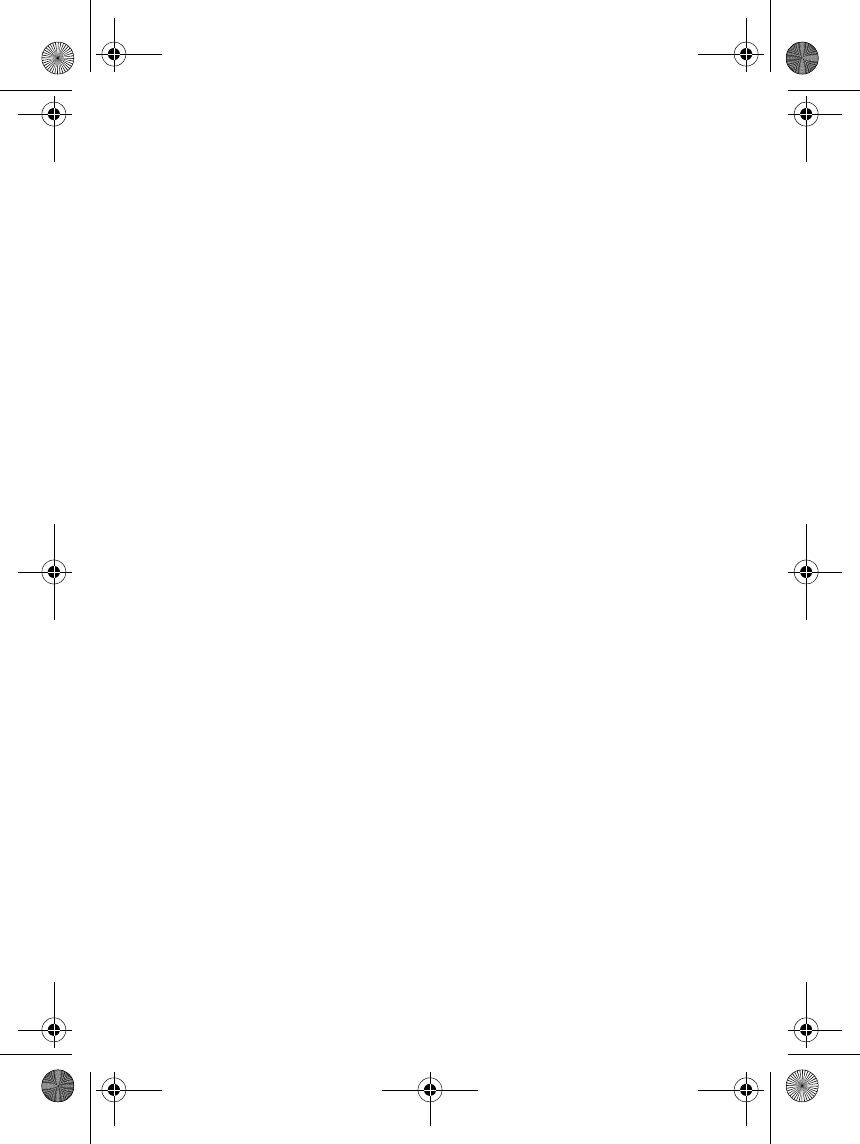
-10
3108_Dufu_fcc_1.1.fm Page -10 Friday, October 24, 2003 2:11 AM
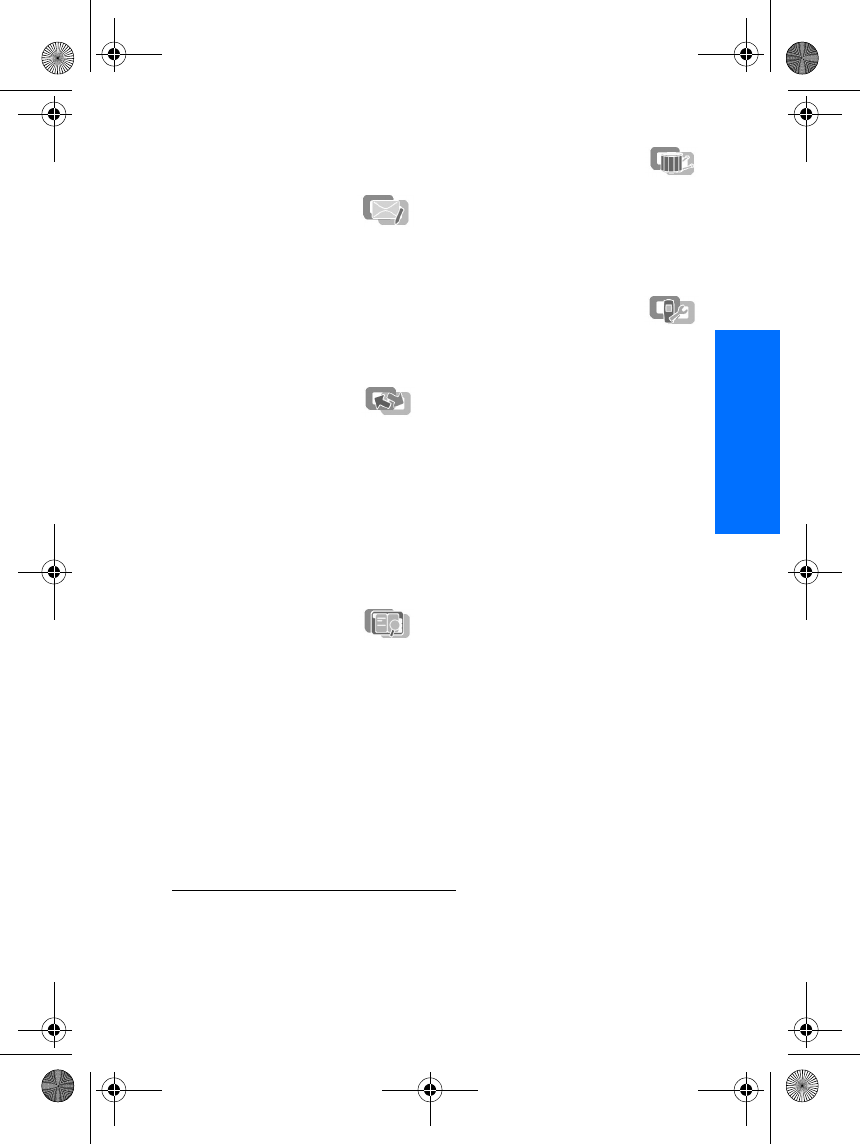
-9
English
List of menu functions
1. Messages
1. Text messages
2. Multimedia msgs.
3. Chat
4. Voice messages
5. Info messages
6. Message settings
7. Service commands
2. Call register
1. Missed calls
2. Received calls
3. Dialled numbers
4. Delete recent call lists
5. Call duration
6. Call costs
7. GPRS data counter
8. GPRS connection timer
3. Contacts
1. Search
2. Add contact
3. Delete
4. Copy
5. Settings
6. Speed dials
7. Info numbers1
8. Service numbers1
9. My numbers2
10.Caller groups2
4. Profiles
1. General
2. Silent
3. Meeting
4. Outdoor
5. Pager
5. Settings
1. Right selection key
settings
1. Select options
2. Organise
2. Screen saver
3. Time and date settings
1. Clock
2. Date
3. Auto-update of date & time
4. Call settings
1. Call divert
2. Anykey answer
3. Flip call handling
4. Automatic redial
5. Speed dialling
6. Call waiting
7. Summary after call
8. Send my caller ID
9. Line for outgoing calls3
5. Phone settings
1. Language settings
2. Automatic keyguard
3. Recognition time-out
4. Cell info display
5. Welcome note
6. Operator selection
1. Shown if supported by your SIM card. For availability, contact your network or ser-
vice provider.
2. If Info numbers or Service numbers is not supported, or, if neither is supported, the
number of this menu item changes accordingly.
3. Shown if supported by your SIM card and network services. Contact your network
operator or service provider for more information.
3108_Dufu_fcc_1.1.fm Page -9 Friday, October 24, 2003 2:11 AM
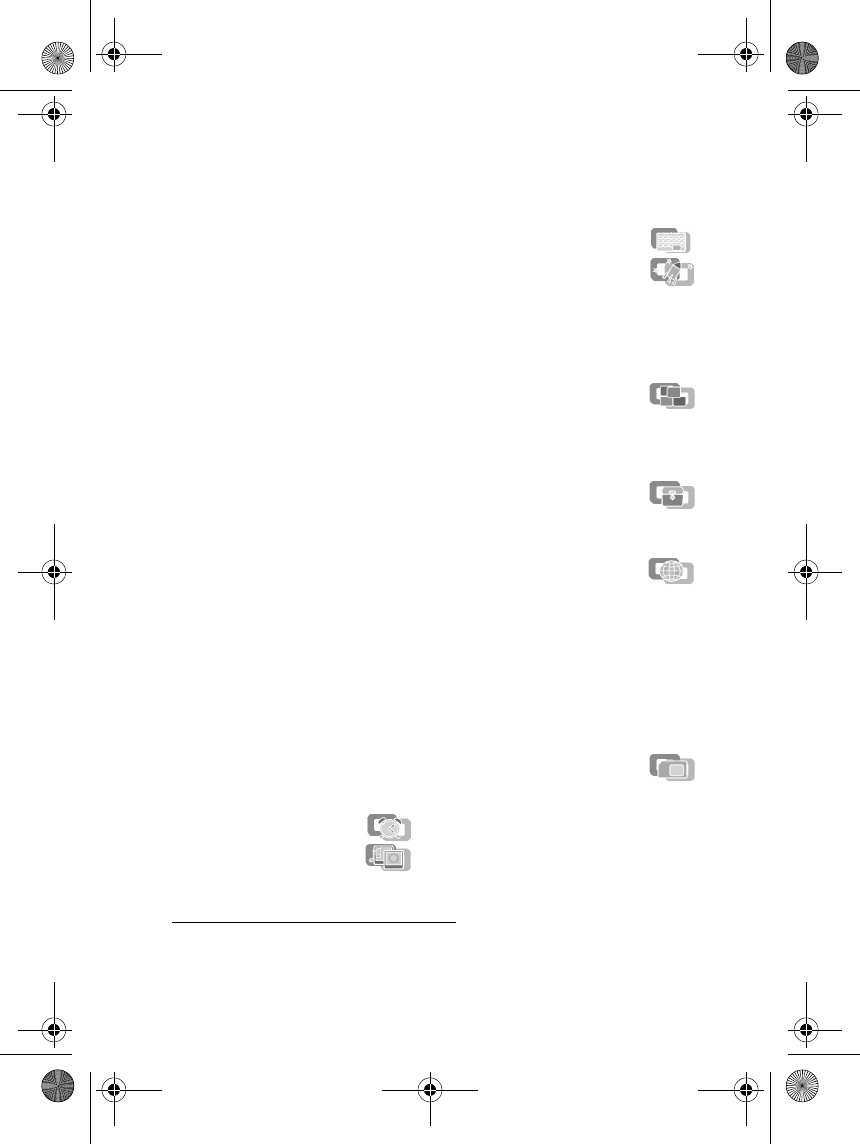
-8
7. Confirm SIM service
actions
8. Help text activation
9. Start-up tone
6. Display settings
1. Wallpaper
2. Colour schemes
3. Operator logo
4. Display brightness
7. Tone settings
1. Incoming call alert
2. Ringing tone
3. Ringing volume
4. Vibrating alert
5. Message alert tone
6. Keypad tones
7. Warning tones
8. Alert for
8. Enhancement settings1
9. Security settings
1. PIN code request
2. Call barring service
3. Fixed dialling
4. Closed user group
5. Security level
6. Access codes
1. Change security code
2. Change PIN code
3. Change PIN2 code
4. Change barring
password
10.Restore factory settings
6. Alarm clock
7. Gallery
1. View folders
2. Add folder
3. Delete folder
4. Rename folder
5. Gallery downloads
8. Calendar
9. Games
1. Select game
2. Game downloads
3. Memory
4. Settings
10.Applications
1. Select application
2. App. downloads
3. Memory
11.Extras
1. Calculator
2. Stopwatch
12.Services
1. Home
2. Bookmarks
3. Download links
4. Service inbox
5. Settings
6. Go to address
7. Clear the cache
13.SIM services2
1. Shown only if the phone is or has been connected to a compatible headset, handsfree
unit or loopset approved by the manufacturer.
2. Only shown if supported by your SIM card. The name and contents vary depending
on the SIM card.
3108_Dufu_fcc_1.1.fm Page -8 Friday, October 24, 2003 2:11 AM
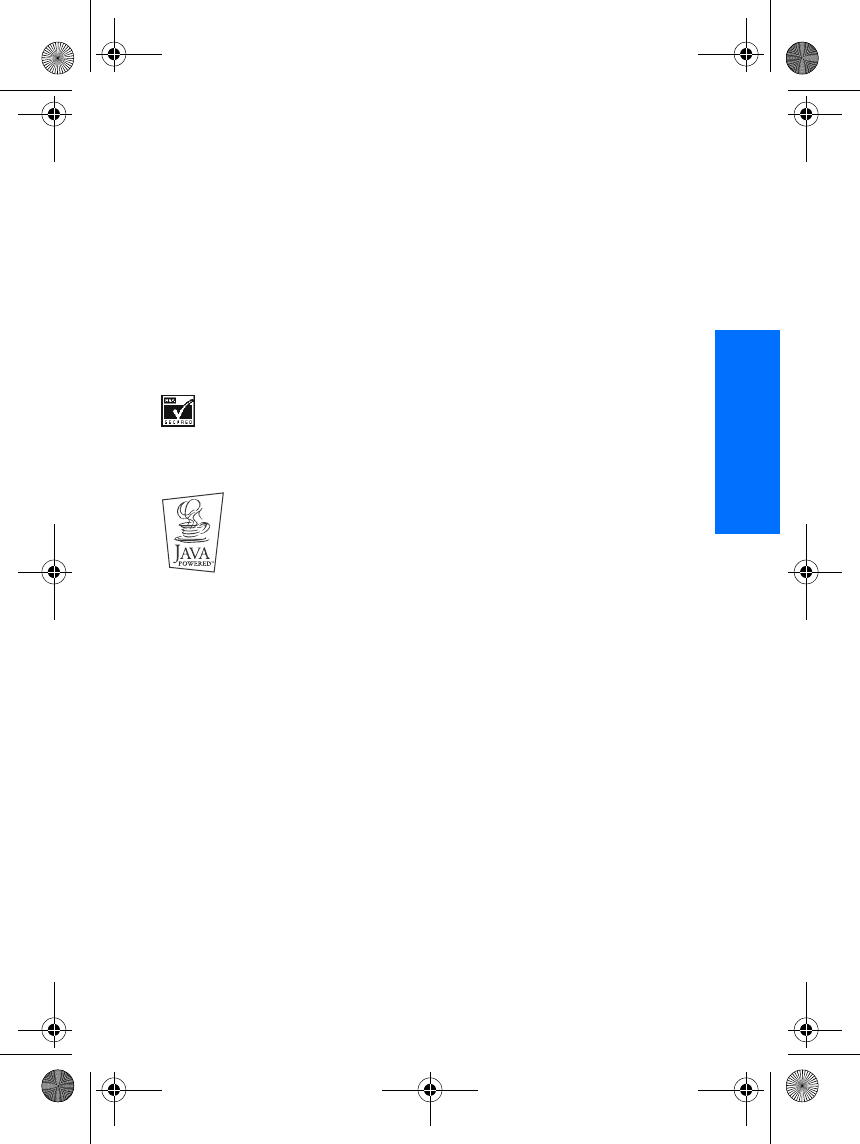
-7
English
The wireless phone described in this guide is approved for use in GSM 900, 1800 and
1900 networks.
LEGAL INFORMATION
Part number ___ Issue 1.
Copyright © 2003 Nokia. All rights reserved.
Nokia, Nokia Connecting People, Nokia 3108, Xpress-on, Pop-Port and the Original Accessories
logos are trademarks or registered trademarks of Nokia Corporation. All other product and
company names mentioned herein may be trademarks or tradenames of their respective owners.
US Patent No 5818437 and other pending patents.
T9 text input software Copyright (C) 1997-2003. Tegic Communications,
Inc. All rights reserved.
Includes RSA BSAFE cryptographic or security protocol software from RSA
Security.
Java is a trademark of Sun Microsystems, Inc.
The information in this user guide was written for the Nokia 3108 phone. Nokia operates a policy
of continuous development. Nokia reserves the right to make changes and improvements to any of the products
described in this document without prior notice.
Under no circumstances shall Nokia be responsible for any loss of data or income or
any special, incidental, consequential or indirect damages howsoever caused.
THE CONTENTS OF THIS DOCUMENT ARE PROVIDED “AS IS.” EXCEPT AS REQUIRED BY
APPLICABLE LAW, NO WARRANTIES OF ANY KIND, EITHER EXPRESS OR IMPLIED, INCLUDING,
BUT NOT LIMITED TO, THE IMPLIED WARRANTIES OF MERCHANTABILITY AND FITNESS FOR A
PARTICULAR PURPOSE, ARE MADE IN RELATION TO THE ACCURACY AND RELIABILITY OR
CONTENTS OF THIS DOCUMENT. NOKIA RESERVES THE RIGHT TO REVISE THIS DOCUMENT OR
WITHDRAW IT AT ANY TIME WITHOUT PRIOR NOTICE.
EXPORT CONTROLS
This product contains commodities, technology or software exported from the United States in
accordance with the Export Administration regulations. Diversion contrary to U.S. or Canadian
law is prohibited.
FCC/INDUSTRY CANADA NOTICE
Your phone may cause TV or radio interference (for example, when using a telephone in close
proximity to receiving equipment). The FCC or Industry Canada can require you to stop using
your telephone if such interference cannot be eliminated. If you require assistance, contact your
local service facility. This device complies with part 15 of the FCC rules. Operation is subject to
the condition that this device does not cause harmful interference.
3108_Dufu_fcc_1.1.fm Page -7 Friday, October 24, 2003 2:11 AM

Table of Contents
-6
Table of Contents
List of menu functions -9
General information................. -1
Stickers in the sales package ...... -1
Access codes .............................. -1
Shared memory ........................... 0
1.Your phone ............................. 1
Keys............................................. 1
Functions of the flip cover .......... 2
Stylus and touch pad ................... 2
Connectors................................... 2
Standby mode.............................. 2
Screen saver..................................... 3
Wallpaper ........................................ 3
Essential indicators in standby mode .
3
2.Getting started........................ 5
Remove and mount the back cover
5
For cover with stylus holder............ 5
For flat cover ................................... 5
Install the SIM card and the battery
6
Charging the battery.................... 7
Switching the phone on and off .. 7
Access menu functions................ 8
Help text ...................................... 8
Keypad lock (Keyguard) ............. 8
Lock the keypad .............................. 9
Unlock the keypad........................... 9
Handle incoming calls when keypad is
locked .............................................. 9
Put on the wrist strap ....................... 9
3.Call functions........................ 10
Make a call ................................ 10
Answer a call............................. 10
Reject a call ............................... 10
End a call................................... 10
Call your voice mailbox (network
service) ...................................... 10
Redial recently dialled numbers 11
Speed dial a phone number ....... 11
In-call options ........................... 11
Make a new call............................. 11
Handle a waiting call..................... 11
Swap calls (network service) .... 12
Transfer calls (network service) 12
Make a conference call ............. 12
Loudspeaker .............................. 12
Answering or Ending a call with the
flip cover ................................... 13
4.Handwriting input method.. 14
Writing with the stylus .............. 14
Handwriting input modes.......... 16
Input mode indicator and recognition
scope .............................................. 16
....................................................... 17
Switching between handwriting input
modes............................................. 17
Recognition timeout.................. 17
Use gestures .............................. 18
Touch pad tone.......................... 19
5.Keypad input methods......... 20
Setting predictive English input on
or off.......................................... 20
Using predictive English input.. 20
Writing compound words .............. 21
Using traditional English input . 21
Changing writing language. ...... 21
Tips for writing text .................. 21
6.Menu functions..................... 23
Messages (Menu 1) ................... 23
Text messages................................ 23
Multimedia messages .................... 27
Multimedia messages memory full 30
3108_Dufu_fcc_1.1.fm Page -6 Friday, October 24, 2003 2:11 AM
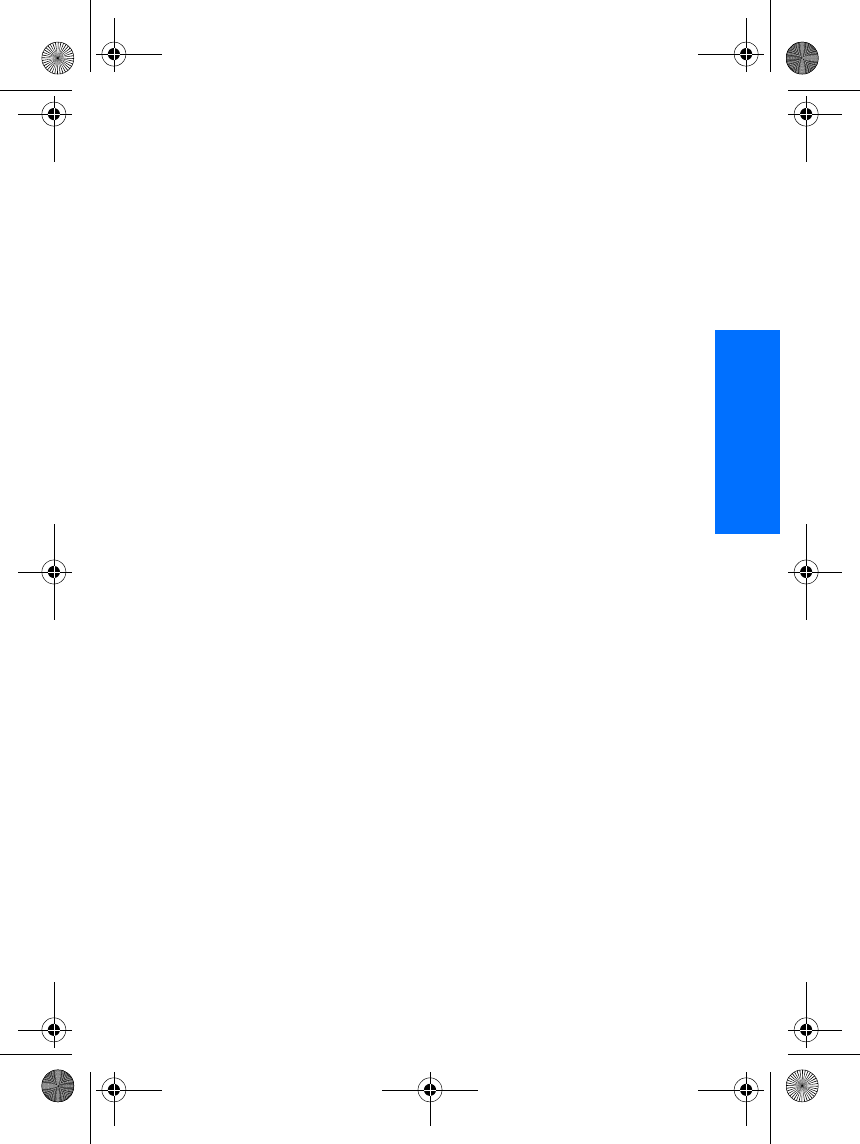
Table of Contents
-5
English
Delete messages ............................ 30
Chat ............................................... 30
Voice messages ............................. 31
Info messages ................................ 31
Message settings............................ 32
Service commands......................... 34
Call register (Menu 2) ............... 34
Recent calls lists ............................ 34
Call counters and call timers ......... 35
Contacts (Menu 3)..................... 36
Phone book settings....................... 36
Save names and phone numbers (Add
names) ........................................... 36
Search for a name in the phone book .
37
Edit a name, number or text item .. 38
Delete names and numbers............ 38
Copy in phone book ...................... 38
Send and receive business cards.... 39
Speed dials..................................... 39
Info numbers ................................. 39
Service numbers ............................ 39
My numbers................................... 39
Caller groups ................................. 40
Profiles (Menu 4) ...................... 40
Settings (Menu 5)...................... 41
Right selection key ........................ 41
Screen saver settings ..................... 41
Time and date settings................... 41
Call settings ................................... 42
Phone settings................................ 44
Display settings ............................. 45
Tone settings ................................. 46
Enhancement settings .................... 47
Security settings ............................ 47
Restore factory settings ................. 48
Alarm clock
(Menu 6).................................... 48
When the alarm time expires......... 49
Gallery (Menu 7)....................... 49
Calendar (Menu 8) .................... 51
Calendar......................................... 51
Games (Menu 9)........................ 53
Launching a game ......................... 53
Memory status for games .............. 54
Game settings ................................ 54
Applications (Menu 10) ............ 54
Launching an application .............. 54
Other options available for an
application or application set......... 55
Download an application ............... 55
Memory status for applications ..... 56
Extras (Menu 11) ...................... 56
Calculator ...................................... 56
Stopwatch ...................................... 57
Services (Menu 12) ................... 58
Basic steps for accessing and using
services .......................................... 58
Setting up the phone for a service . 59
GPRS Connection.......................... 60
Making a connection to a service .. 60
Browsing the pages of a service .... 60
Disconnect from a service ............. 62
Appearance settings of the multi-
mode browser ................................ 62
Cookies .......................................... 62
Bookmarks..................................... 62
Downloading ................................. 63
Service inbox ................................. 63
The cache memory ........................ 64
Browser security............................ 64
SIM services (Menu 13)............ 66
7.PC connectivity..................... 68
PC Suite..................................... 68
GPRS, HSCSD and CSD............... 68
Use data communication
applications ............................... 69
8.Battery information ............. 70
Charging and Discharging ........ 70
9.Genuine Enhancements ....... 71
3108_Dufu_fcc_1.1.fm Page -5 Friday, October 24, 2003 2:11 AM
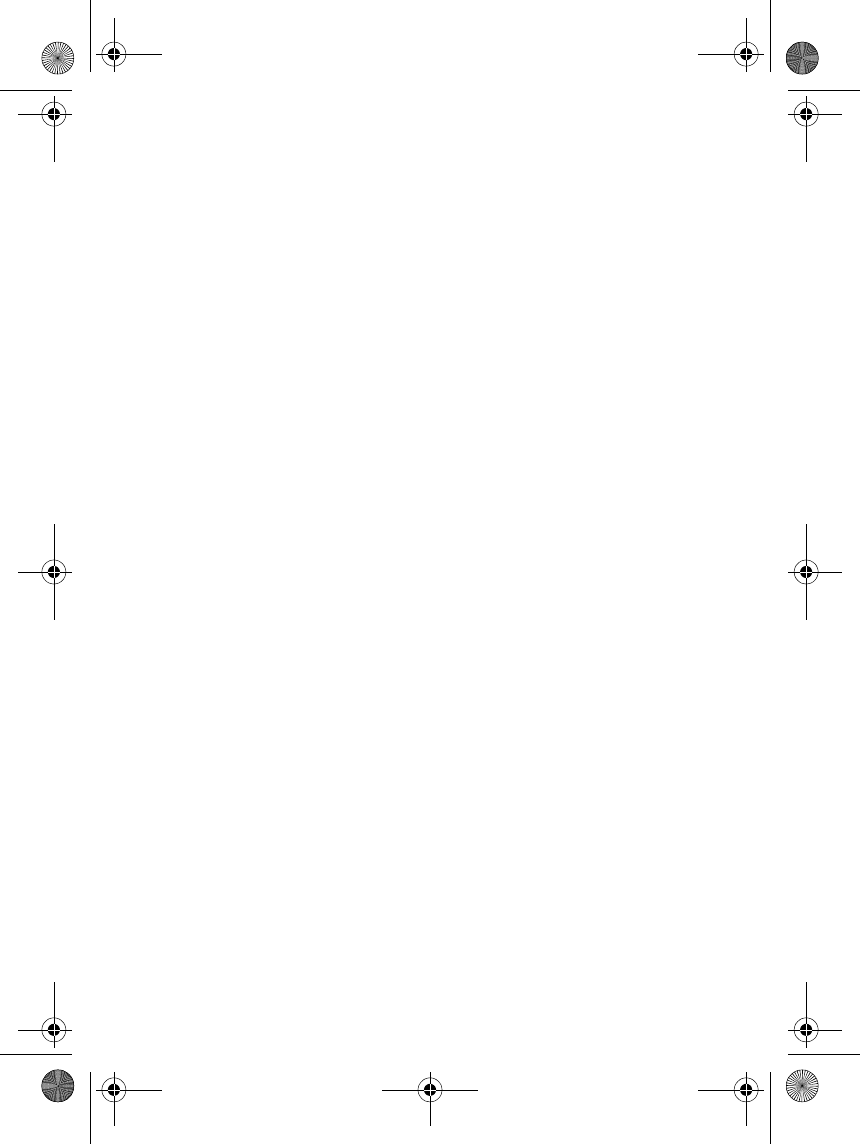
Table of Contents
-4
Battery ....................................... 71
Travel Charger (ACP-12).......... 71
3108_Dufu_fcc_1.1.fm Page -4 Friday, October 24, 2003 2:11 AM
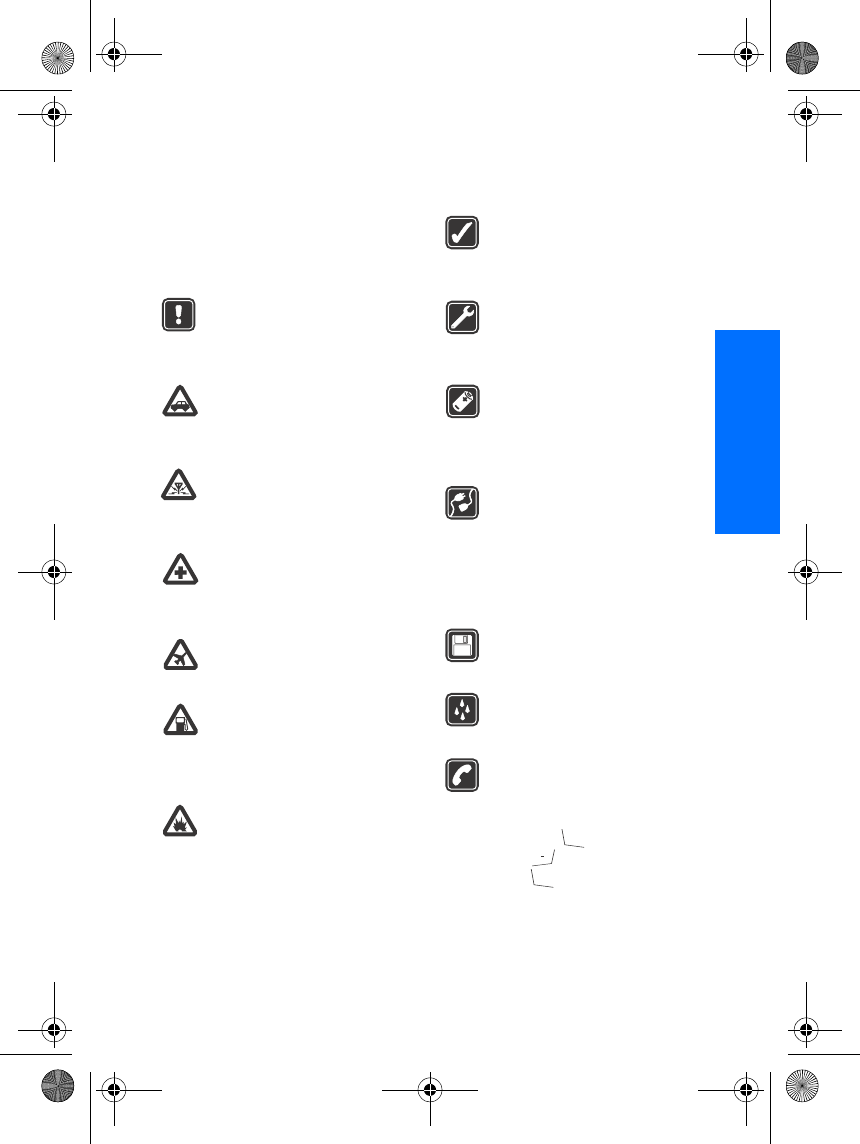
FOR YOUR SAFETY
-3
English
FOR YOUR SAFETY
Read these simple guidelines. Breaking
the rules may be dangerous or illegal.
Further detailed information is given in
this manual.
Do not switch the phone on
when wireless phone use is
prohibited or when it may cause
interference or danger.
ROAD SAFETY COMES
FIRST
Don't use a hand-held phone
while driving.
INTERFERENCE
All wireless phones may get
interference, which could affect
performance.
SWITCH OFF IN HOSPITALS
Follow any regulations or rules.
Switch the phone off near
medical equipment.
SWITCH OFF IN AIRCRAFT
Wireless devices can cause
interference in aircraft.
SWITCH OFF WHEN
REFUELLING
Don't use the phone at a
refuelling point. Don't use near
fuel or chemicals.
SWITCH OFF NEAR
BLASTING
Don't use the phone where
blasting is in progress. Observe
restrictions, and follow any
regulations or rules.
USE SENSIBLY
Use only in the normal position.
Don't touch the antenna
unnecessarily.
QUALIFIED SERVICE
Only qualified personnel may
install or repair phone
equipment.
ACCESSORIES AND
BATTERIES
Use only approved accessories
and batteries. Do not connect
incompatible products.
CONNECTING TO OTHER
DEVICES
When connecting to any other
device, read its user's guide for
detailed safety instructions. Do
not connect incompatible
products.
BACKUP COPIES
Remember to make backup
copies of all important data.
WATER-RESISTANCE
Your phone is not water-
resistant. Keep it dry.
CALLING
Ensure the phone is switched on
and in service. Enter the phone
number, including the area code,
then press . To end a call,
press . To answer a call,
press .
3108_Dufu_fcc_1.1.fm Page -3 Friday, October 24, 2003 2:11 AM
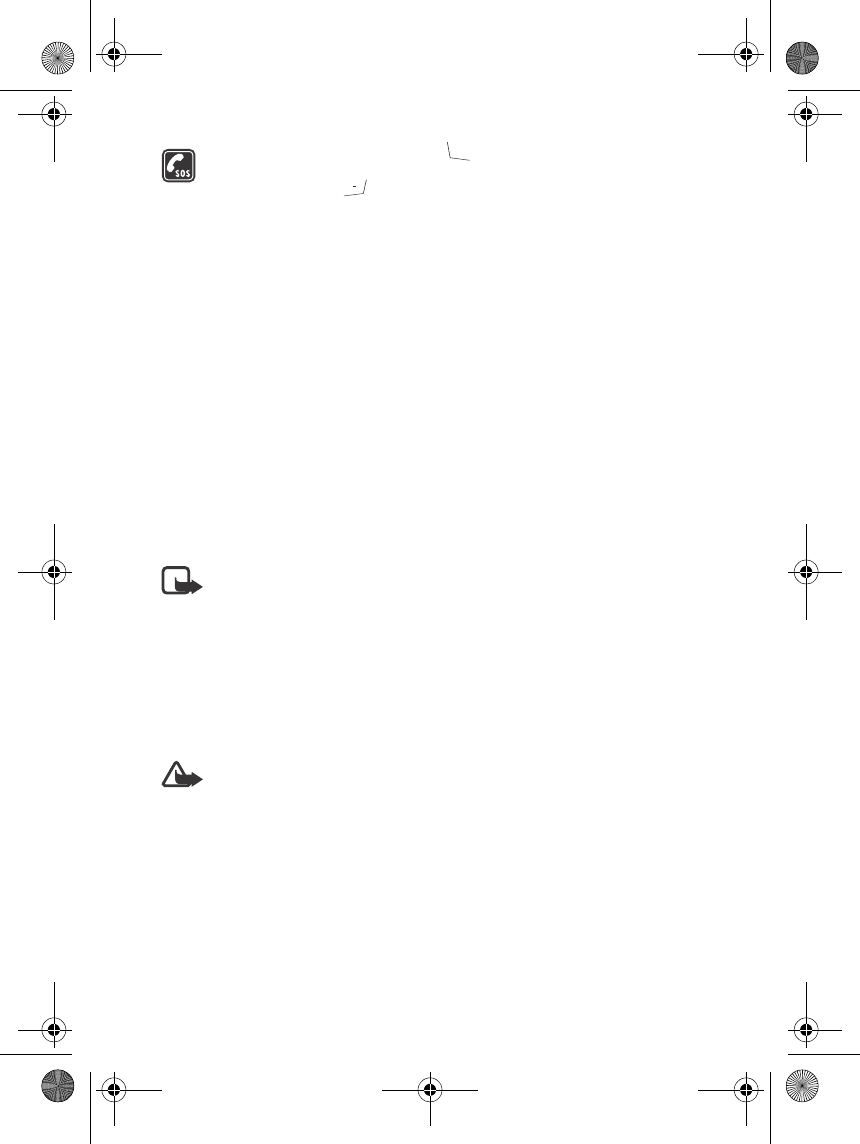
FOR YOUR SAFETY
-2
EMERGENCY CALLS
Ensure the phone is switched on
and in service. Press as
many times as needed (e.g. to
exit a call, to exit a menu, etc.) to
clear the display. Enter the
emergency number, then press
. Give your location. Do not end the
call until told to do so.
Network services
The wireless phone described in this guide is approved for use on the EGSM 900,
GSM 1800 and GSM 1900 network.
Triband is a network dependent feature. Check with your local service provider if you
can subscribe to and use this feature.
A number of features included in this guide are called network services. These are
special services that you arrange through your wireless service provider. Before you
can take advantage of any of these network services, you must subscribe to them
through your service provider and obtain instructions for their use from your service
provider.
Note: Some networks may not support all language-dependent characters
and/or services.
Chargers and enhancements
Check the model number of any charger before use with this device. This device is
intended for use when supplied with power from ACP-7, ACP-12, LCH-9 and LCH-
12 chargers. Note the specific model number of a charger varies with different type of plug. For
example, for ACP-12, the specific model number can be ACP-12C, ACP-12U or ACP-12X, etc.
Warning: Use only batteries, chargers and accessories approved by the
phone manufacturer for use with this particular phone model. The use of any
other types may invalidate any approval or warranty applying to the phone,
and may be dangerous.
For availability of approved enhancements, please check with your dealer.
When you disconnect the power cord of any enhancement, grasp and pull the plug,
not the cord.
3108_Dufu_fcc_1.1.fm Page -2 Friday, October 24, 2003 2:11 AM
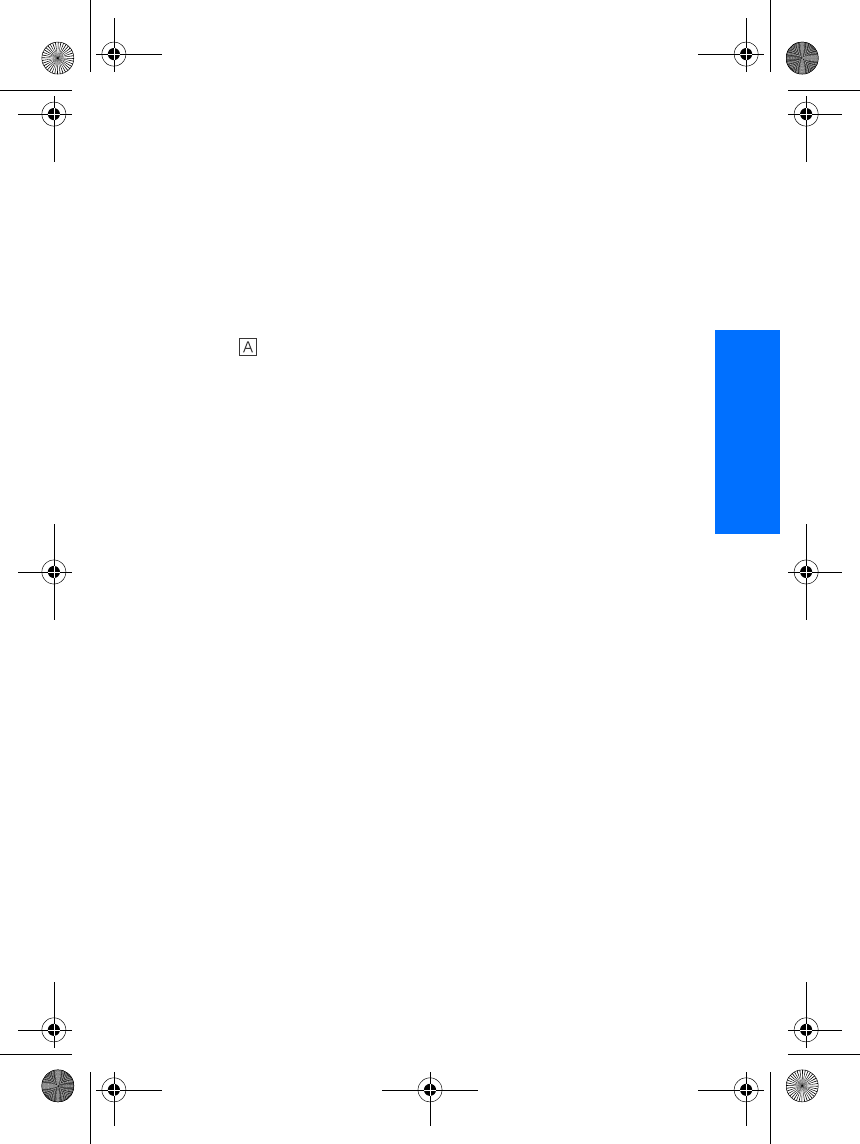
General information
-1
English
General information
■Stickers in the sales
package
The stickers contain important
information for services and
customer support.
Attach the sticker to the Your
details page in this User's guide.
■Access codes
•Security code (5 to 10 digits):
The security code may protect
your phone against unauthorised
use. It is supplied with the
phone, and the default code is
12345.
Change the code, and keep the
new code secret and in a safe
place separate from your phone.
To change and use the code, see
”Security settings” on page 47.
•PIN code and PIN2 code (4 to 8
digits):
The PIN (Personal Identification
Number) code protects your
SIM card against unauthorised
use. The PIN code is usually
supplied with the SIM card.
To set the phone to request the
PIN code each time the phone is
switched on, see ”Security
settings” on page 47.
The PIN2 code may be supplied
with the SIM card. You need the
code to access some functions,
such as charging unit counters.
If you key in an incorrect PIN
code three times in succession,
the phone may display PIN
blocked and ask you to enter the
PUK code. Contact your service
provider to obtain the PUK
code.
•PUK and PUK2 code (8
digits): The PUK (Personal
Unblocking Key) code is
required to change a blocked
PIN code. The PUK2 code is
required to change a blocked
PIN2 code.
If the codes are not supplied
with the SIM card, contact your
local service provider for the
codes.
•Barring password (4 digits):
The barring password is needed
when using the Call barring
service, see ”Security settings”
on page 47. You can obtain the
password from your service
provider.
•Signing PIN: The signing PIN
is needed for the digital
signature. See ”Digital
signature” on page 66. The
signing PIN is supplied with the
3108_Dufu_fcc_1.1.fm Page -1 Friday, October 24, 2003 2:11 AM
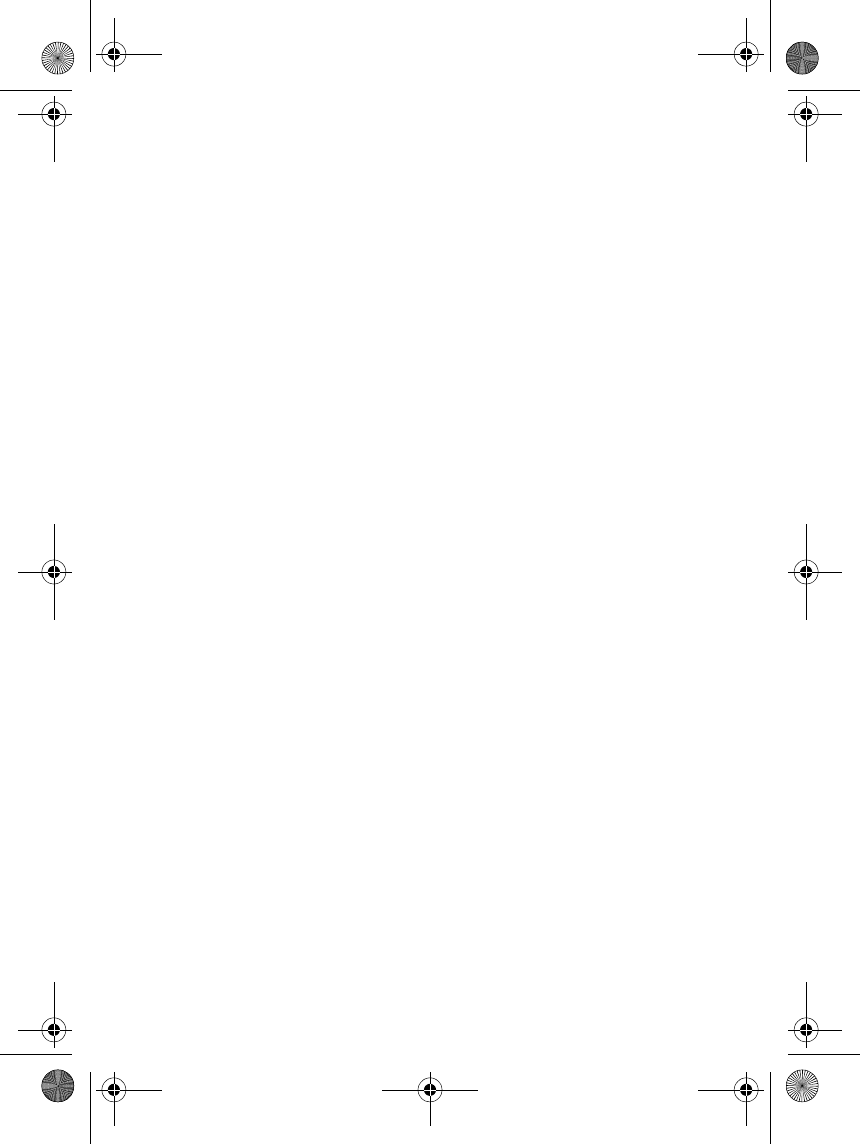
General information
0
SIM card if the SIM card has a
security module in it.
If you key in an incorrect PIN
code several times, the phone
may display PIN code blocked
and ask you to key in the PUK
code. Contact your service
provider to get the PUK code.
■Shared memory
The following features in this
phone may use shared memory:
phone book, text messages and
multimedia messages, images and
ringing tones in gallery, calendar
and Java games and applications.
Using any of these features may
consume the shared memory. This
is especially true with heavy use of
any of the features, although some
of the features may have a certain
amount of memory specially
allocated to them in addition to the
shared memory. For example,
saving many images, or Java
applications. may take all the
shared memory. In this case your
phone may notify you that the
memory is full. You need to delete
some of the contents or entries
using shared memory before
continuing.
3108_Dufu_fcc_1.1.fm Page 0 Friday, October 24, 2003 2:11 AM
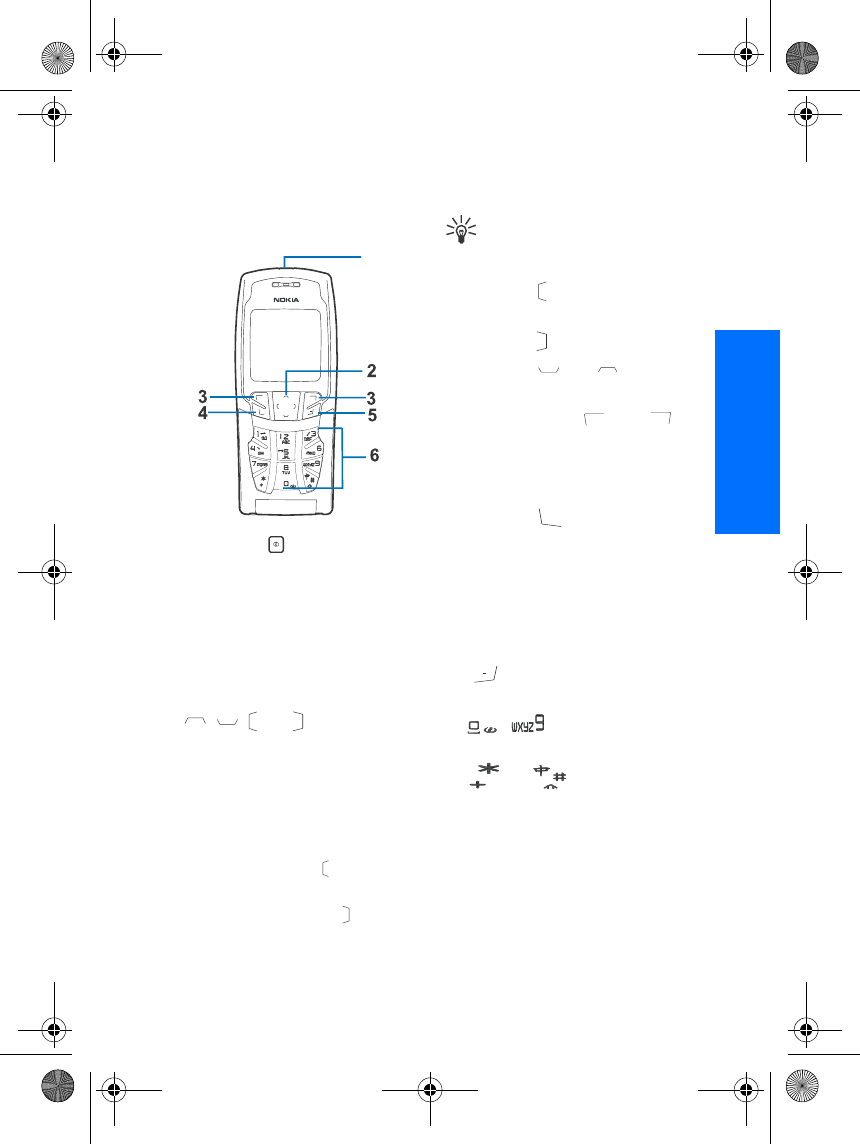
Your phone
1
English
1. Your phone
■Keys
1. Power key
Switches the phone on and off.
When the keypad is locked,
pressing the power key briefly
turns the phone’s display lights
on for about 15 seconds.
2. 4-way scroll keys
, , and
Use the keys to scroll through
names, phone numbers, menus,
and settings, or move the cursor
or highlight in text editing.
When in call or media
application, press to
decrease the volume of the call
or application, press to
increase the volume.
Tip: In standby mode, press
the scroll keys to quickly
access some functions:
•Press to create a text
message.
•Press to open Calendar.
•Press and to open
your phone book.
3. Selection keys and
The function of the keys
depends on the text shown
above the keys in the display.
4. Send key
• Dials a phone number.
• Answers a call.
• In standby mode, press it to
list the most recently dialled
numbers.
5. ends an active call. Exits
from any function.
6. - are used to enter
numbers and characters.
and are used for
various purposes in different
functions.
1
3108_Dufu_fcc_1.1.fm Page 1 Friday, October 24, 2003 2:11 AM
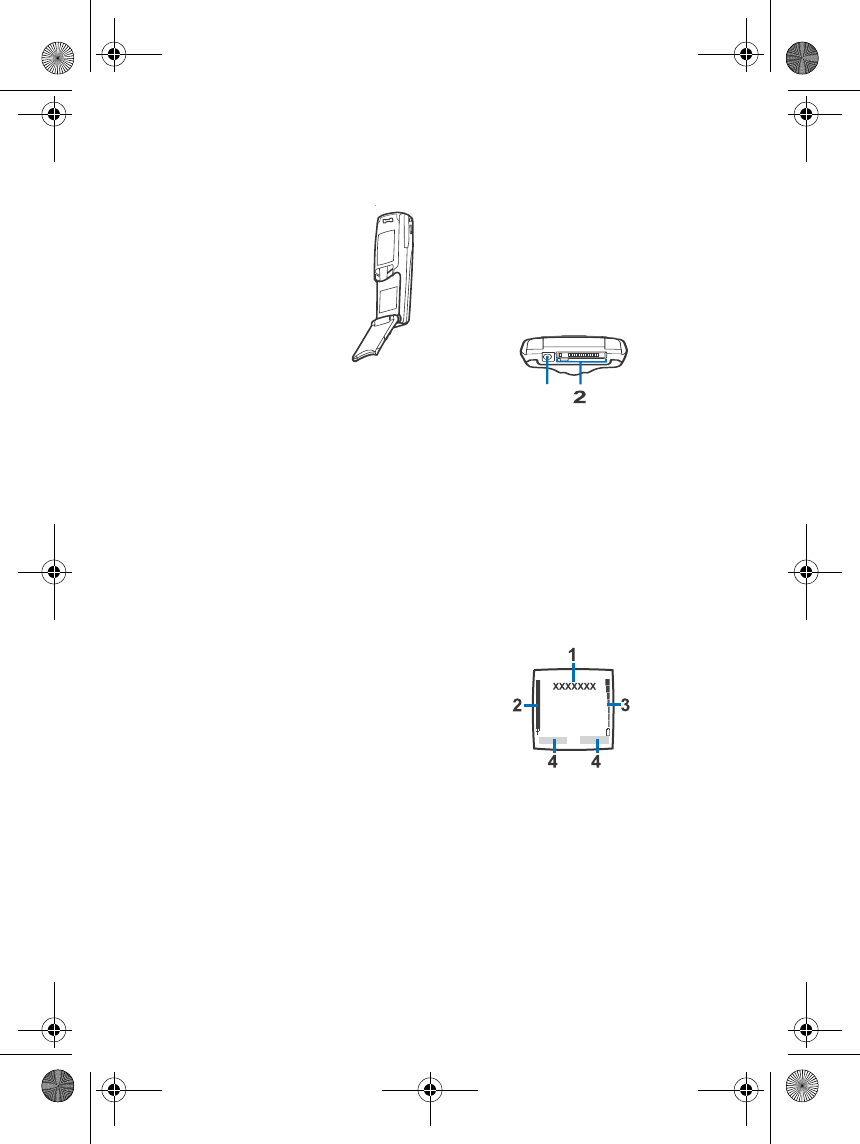
Your phone
2
■Functions of the flip
cover
Your phone has a flip
cover. Opening and
closing the flip cover
affects basic voice call
handling and text input
method.
Note that the keys on the
flip cover work only
when the flip cover is properly
closed.
• Answer or end a voice call
You can customise the function
of the flip cover with respect to
voice call handling in Settings,
Call settings, Flip call handling.
Refer to “Flip call handling” on
page 43.
• Change text input method
When you need to input text,
open the flip cover to use
handwriting input method, close
the flip cover to use keypad
input method. Further
instructions about the
handwriting input method start
on page 14.
Note it is recommended that always
keep the flip cover closed when you
are not writing or using it to for
calls.
■Stylus and touch pad
The stylus is in the slot of the back
cover, and the touch pad is under
the flip cover of the phone. You can
write with the stylus on the touch
pad to input text. For information
on how to input text with the stylus,
see “Handwriting input method” on
page 14.
■Connectors
1. Charger connector
2. Pop-PortTM connector for the
headset and the data cable.
■Standby mode
When the phone is ready for use,
and you have not keyed in any
characters, the phone is in standby
mode.
1. The current operator’s logo
(network service).
2. Signal strength: the higher the
bar, the stronger the signal.
3. Battery charge level: the higher
the bar, the more power in the
battery.
4. Selection key functions.
1
3108_Dufu_fcc_1.1.fm Page 2 Friday, October 24, 2003 2:11 AM
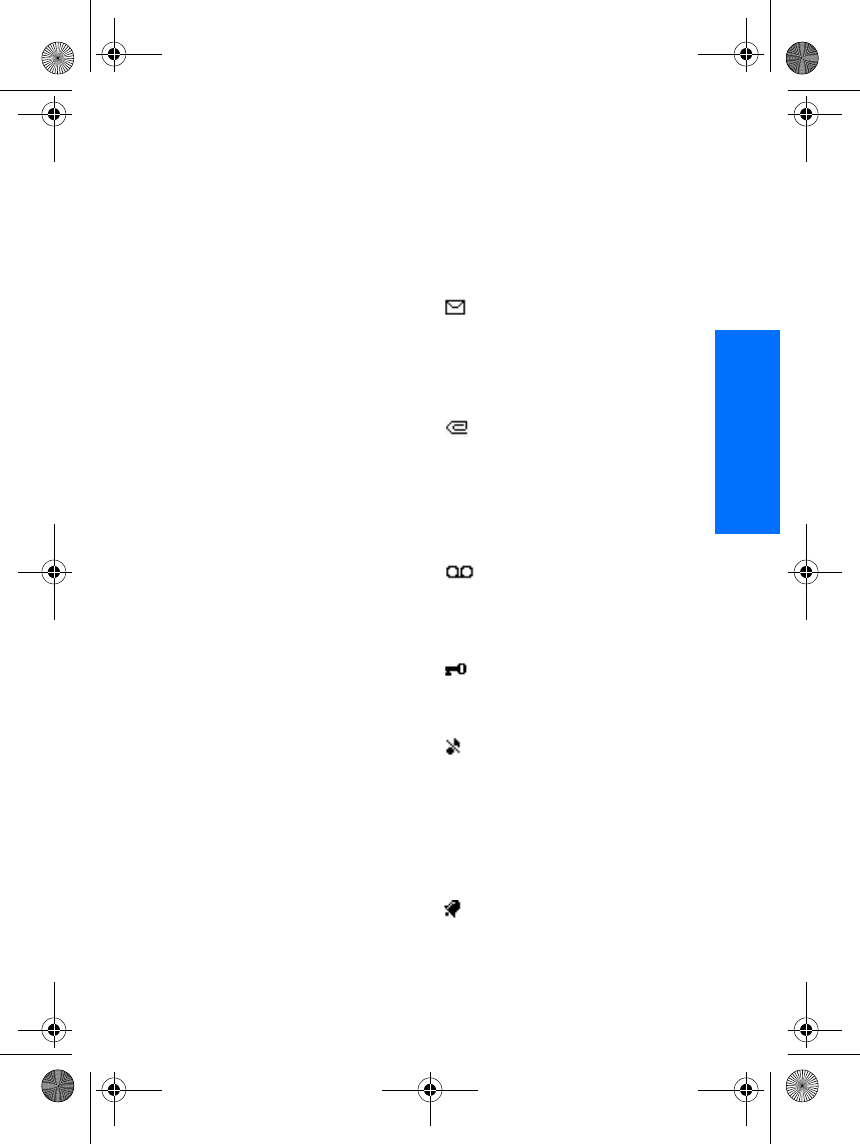
Your phone
3
English
You can customise the function
of the right selection key in the
standby mode in Settings, Right
selection key settings. See also
”Right selection key” on page
41.
Screen saver
If you have set the screen saver on,
the phone automatically activates
an animation or still image as
screen saver after a pre-set period of
time in standby mode. You can also
customise the time after which the
phone activates the screen saver.
Please refer to “Screen saver
settings” on page 41.
Independent of the screen saver
settings, for power saving , a digital
clock view will overwrite the whole
display when for a certain time no
function of the phone has been
used.
Note that if you have not set the
time, 00:00 is displayed. You can
set the time in Settings, Time and
date settings.
The screen saver cannot be
activated when the flip cover of the
phone is open.
Wallpaper
You can set your phone to display a
background image, wallpaper,
when the phone is in standby mode.
You can choose a wallpaper in
Settings, Display settings,
Wallpaper. See also ”Wallpaper” on
page 45.
Essential indicators in
standby mode
You have received one or
several text or picture
messages. See ”Read and
reply to a message” on page
25.
You have received one or
several multimedia
messages. See ”Reading
and replying to a
multimedia message” on
page 29.
You have received one or
several voice messages. See
”Voice messages” on page
31.
The phone’s keypad is
locked. See ”Keypad lock
(Keyguard)” on page 8.
The phone does not ring for
an incoming call or
message when Incoming
call alert is set to Off and
Message alert tone is set to
Off. See ”Tone settings” on
page 46.
The alarm clock is set to
On. See “Alarm clock
(Menu 6)” on page 48.
3108_Dufu_fcc_1.1.fm Page 3 Friday, October 24, 2003 2:11 AM
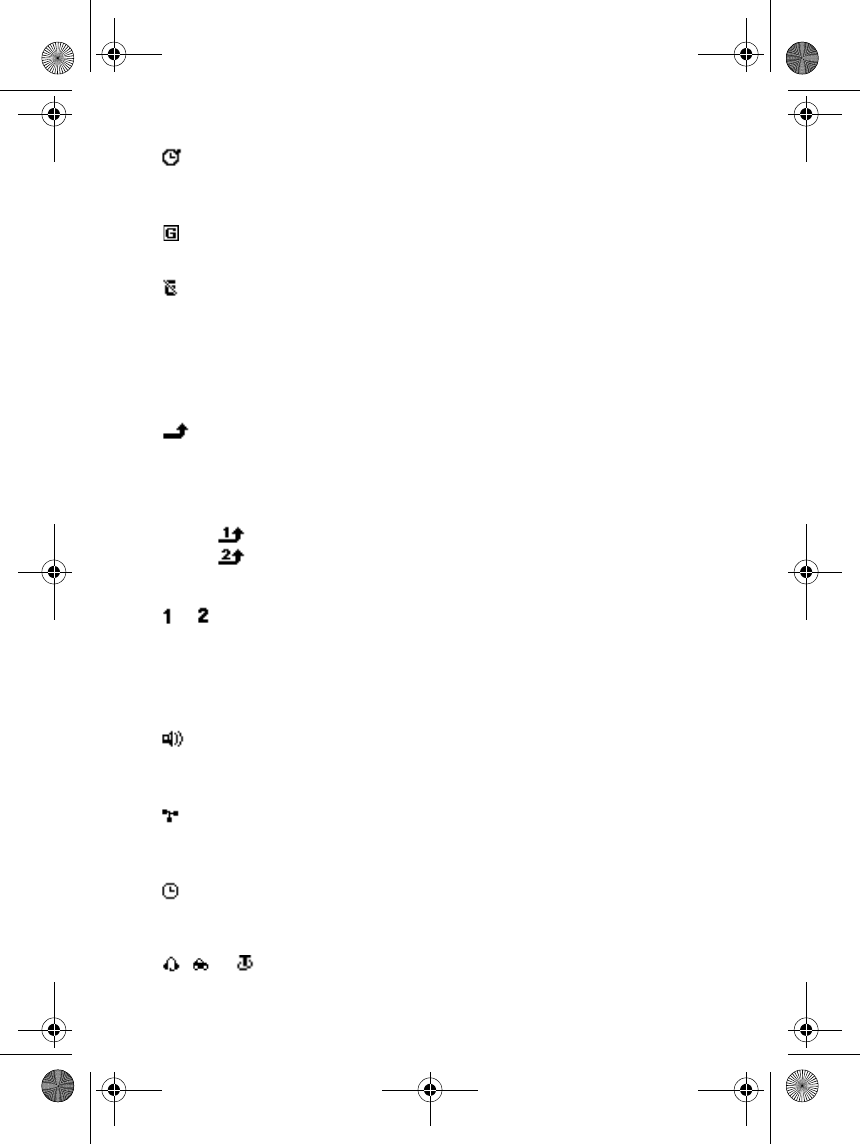
Your phone
4
The stopwatch is running in
the background. See
”Stopwatch” on page 57.
A GPRS connection is
established.
The GPRS connection is
suspended (on hold), for
example if there is an
incoming or outgoing call
during a GPRS dial-up
connection.
All your calls are diverted
to another number, Divert
all voice calls. If you have
two phone lines, the divert
indicator for the first line is
and for the second line
. See ”Call divert” on
page 42.
or If you have two phone
lines, the indicator displays
the selected phone line. See
”Line for outgoing calls” on
page 43.
The loudspeaker has been
activated, see
”Loudspeaker” on page 12.
Calls are limited to a closed
user group. See ”Security
settings” on page 47.
The timed profile is
selected. See ”Profiles
(Menu 4)” on page 40.
, or
A headset, handsfree, or
loopset, is connected to the
phone.
To enable the phone to show the
time and date in standby mode, see
”Clock” and ”Date” on page 42.
3108_Dufu_fcc_1.1.fm Page 4 Friday, October 24, 2003 2:11 AM
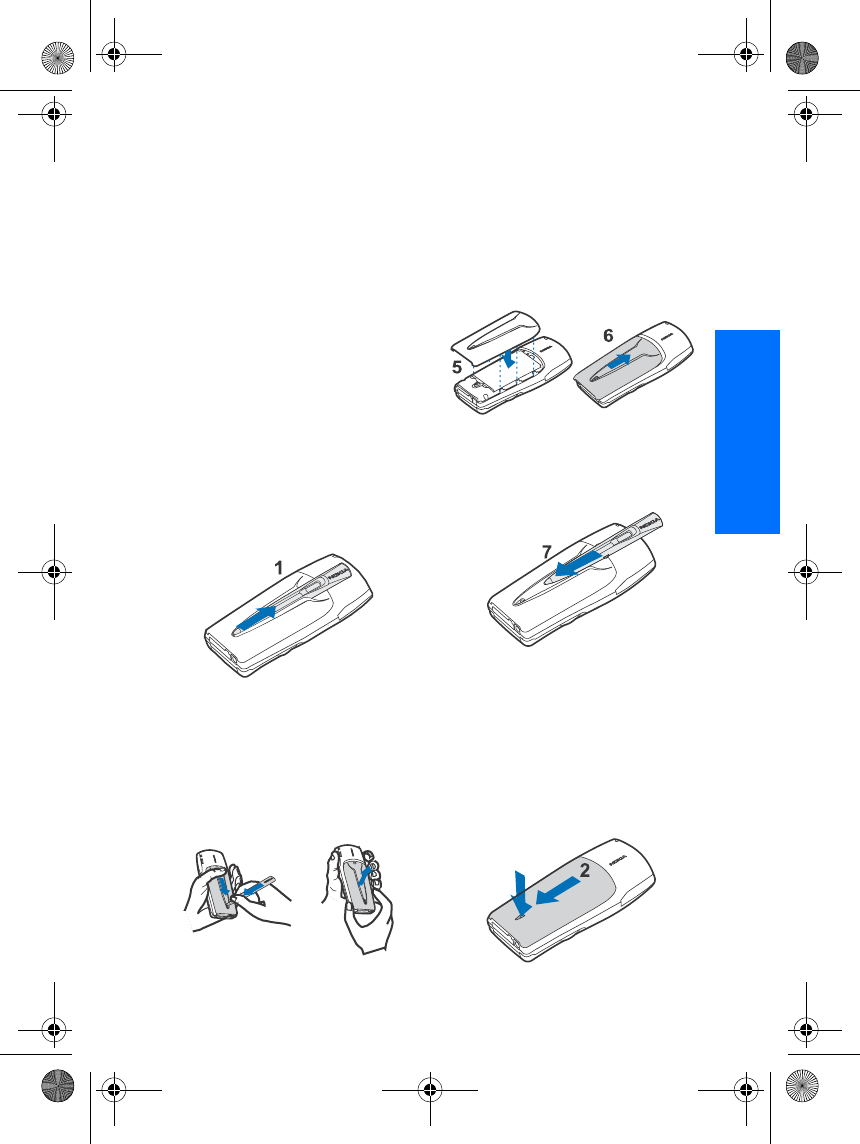
Getting started
5
English
2. Getting started
■Remove and mount the
back cover
There are two different back covers
in your sales package. One is with
the stylus holder to carry the stylus,
the other is flat. You can choose
which one to use. Below are
instructions on how to remove and
mount the two kinds of back covers.
For cover with stylus
holder
1. Slide the stylus toward the top
end of the phone to remove (1).
2. Press down the back cover
release button with the stylus
(2), and slide the back cover
slightly toward the bottom end
of the phone (3). Lift the back
cover to remove (4).
3. Position the back cover as
shown in the illustration (5).
Slide the back cover toward the
top end of the phone to lock (6).
4. Slide the stylus toward the
bottom end of the phone until it
reaches the end of the slot (7).
For flat cover
1. Press the back cover release
button (1), slide the back cover
slightly toward the bottom end
of the phone (2), and lift the
back cover to remove.
2
34
1
3108_Dufu_fcc_1.1.fm Page 5 Friday, October 24, 2003 2:11 AM
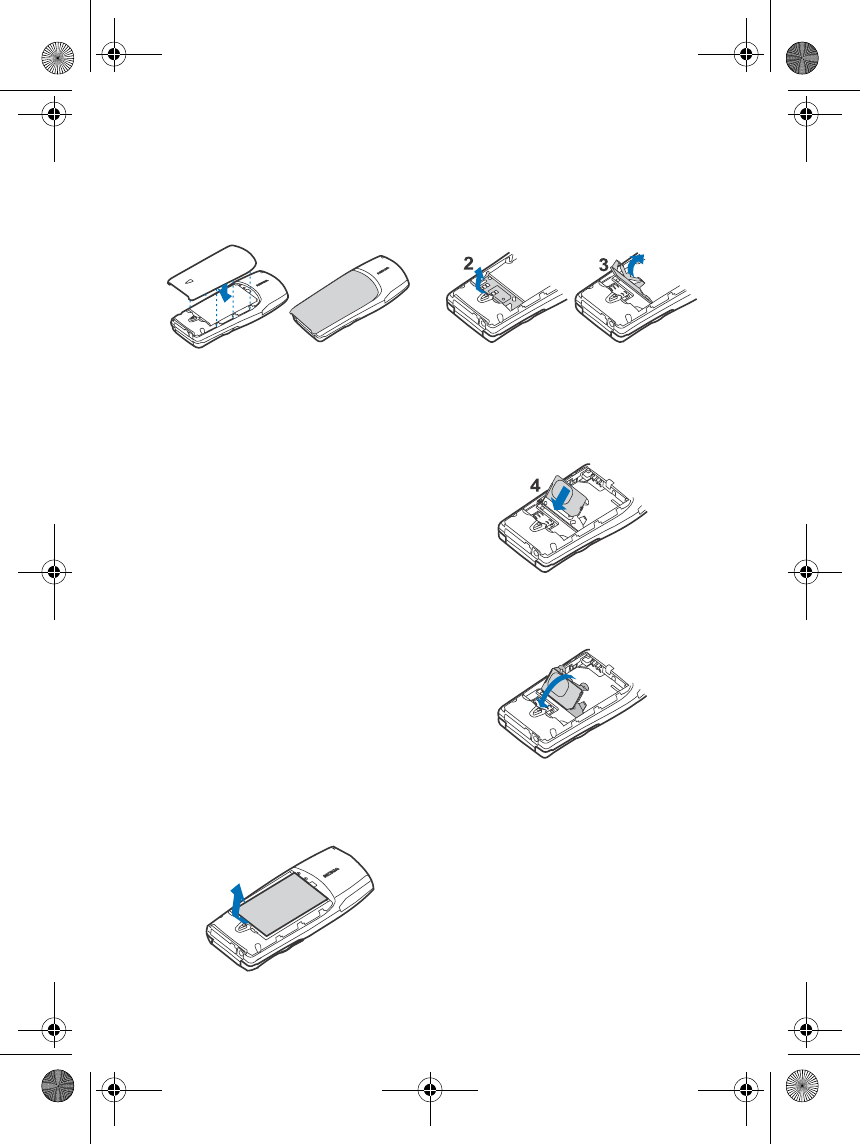
Getting started
6
2. Position the back cover as
shown in the illustration (3).
Slide the back cover toward the
top end of the phone to lock. (4).
■Install the SIM card and
the battery
• Keep all miniature SIM cards
out of the reach of small
children.
• The SIM card and its contacts
can easily be damaged by
scratches or bending, so be
careful when handling, inserting
or removing the card.
• Before installing the SIM card,
always make sure that the phone
is switched off and disconncted
from the charger or any other
devices, and then remove the
battery.
1. Lift the battery up from the
finger grip on the phone with
your fingers (1) to remove.
2. Carefully lift the SIM card
holder from the finger grip of the
phone with your finger (2). Flip
cover the holder open (3).
3. Insert the SIM card into the slot
of the SIM card holder, bevelled
corner first and golden contact
facing out (4).
4. Close the SIM card holder (5)
and press it to lock.
5. Position the battery so the
golden contacts match up with
3
4
1
5
3108_Dufu_fcc_1.1.fm Page 6 Friday, October 24, 2003 2:11 AM
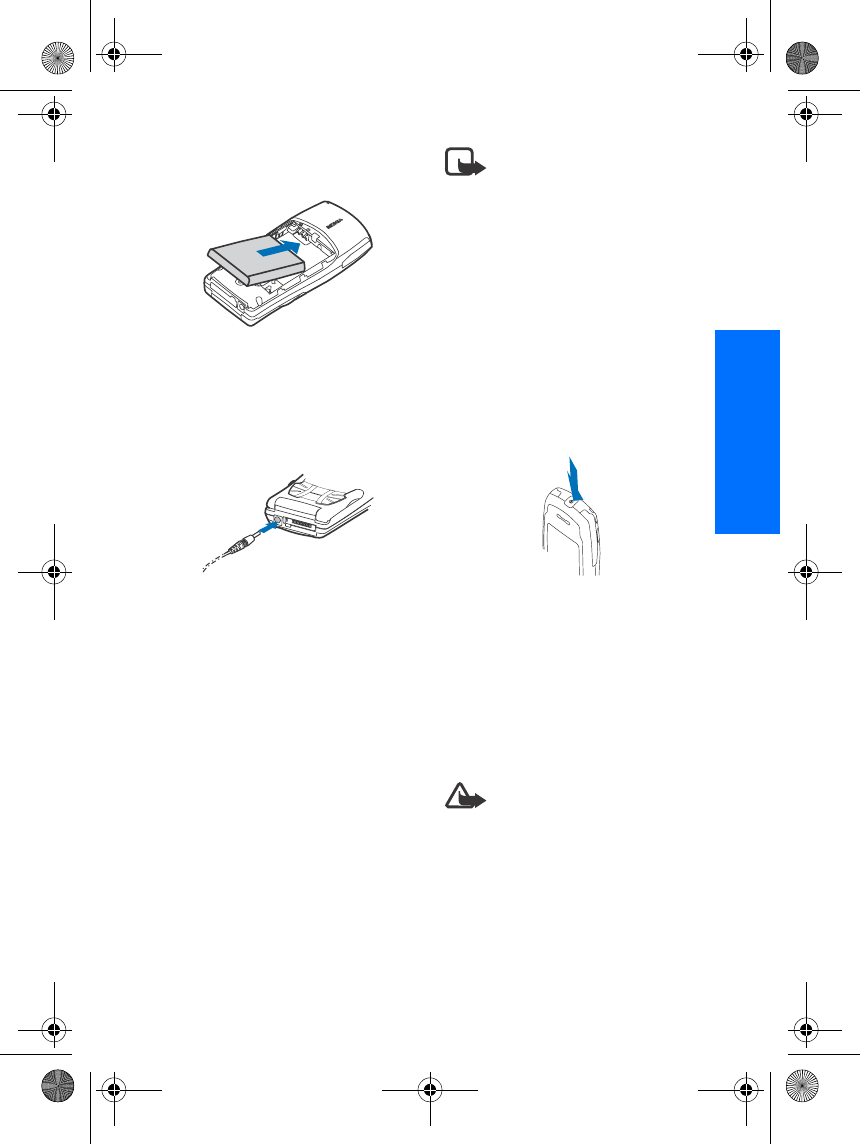
Getting started
7
English
those on the phone. Insert the
battery (6).
■Charging the battery
1. Connect the plug from the
charger to the socket on the
bottom of the phone.
2. Plug the charger to a standard
AC outlet.
• After a few seconds, the
battery indicator on the
display starts to scroll from
bottom to top.
• When the battery is about
full, the bar in the display
stops scrolling.
• Charging time depends on
the charger and battery.
3. Disconnect the charger from the
AC outlet and the phone once
charging is complete.
Note: You can use the
phone while the battery is
charging. However, if the
battery is completely
empty, it may need to
charge a few minutes
before you can make or
receive calls or before the
battery indicator appears.
■Switching the phone on
and off
Press and hold the power key.
Note that if the phone displays
Insert SIM card even though the
SIM card is properly inserted, or
SIM card not supported, contact
your network operator or service
provider. Your phone does not
support 5 Volt SIM cards and the
card may need to be changed.
Warning: Do not switch
the phone on when wireless
phone use is prohibited or
when it may cause interference or
danger.
TIPS ON EFFICIENT
OPERATION: Your phone has a
built-in antenna. As with any other
radio transmitting device, do not
6
3108_Dufu_fcc_1.1.fm Page 7 Friday, October 24, 2003 2:11 AM
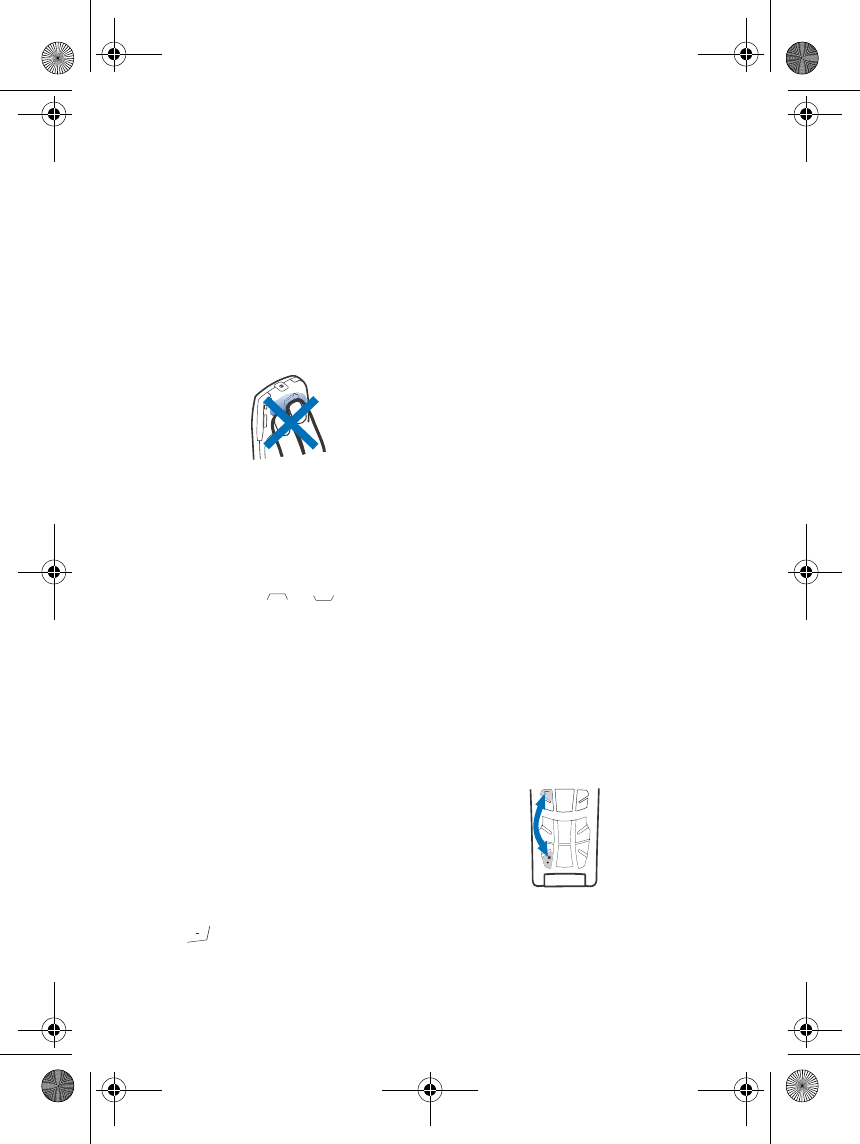
Getting started
8
touch the antenna unnecessarily
when the phone is switched on.
Contact with the antenna affects
call quality and may cause the
phone to operate at a higher power
level than otherwise needed. Not
touching the antenna area during a
phone call optimises the antenna
performance and the talktime of
your phone.
■Access menu functions
By scrolling
1. To access the menu, press Menu.
2. Scroll with or through
the menu and select, for
example, Settings by pressing
Select.
3. If the menu contains submenus,
select the one you want, for
example Call settings.
4. If the selected submenu contains
further submenus,
step 3. Select the next submenu,
for example Anykey answer.
5. Select the setting of your choice.
6. Press Back to return to the
previous menu level, and Exit or
to exit the menu.
By using a shortcut
You can access most of the menus,
but not all, by using the shortcut.
The menus, submenus and setting
options are numbered. To access a
menu using the shortcut, in standby
mode, press Menu, and within two
seconds, key in the first number of
the menu you want to access. Keep
going until you’ve entered all the
numbers.
For example, to enter Anykey
answer, press Menu 5-3-2
(Settings-Call settings-Anykey
answer).
■Help text
Most of the menu functions have
brief help texts. To view the help
text, scroll to the menu, pause for
about 15 seconds. To exit the help
text, press Back. See more in ”Help
text activation” on page 45.
■Keypad lock
(Keyguard)
You can lock the keypad to prevent
accidental key presses.
3108_Dufu_fcc_1.1.fm Page 8 Friday, October 24, 2003 2:11 AM
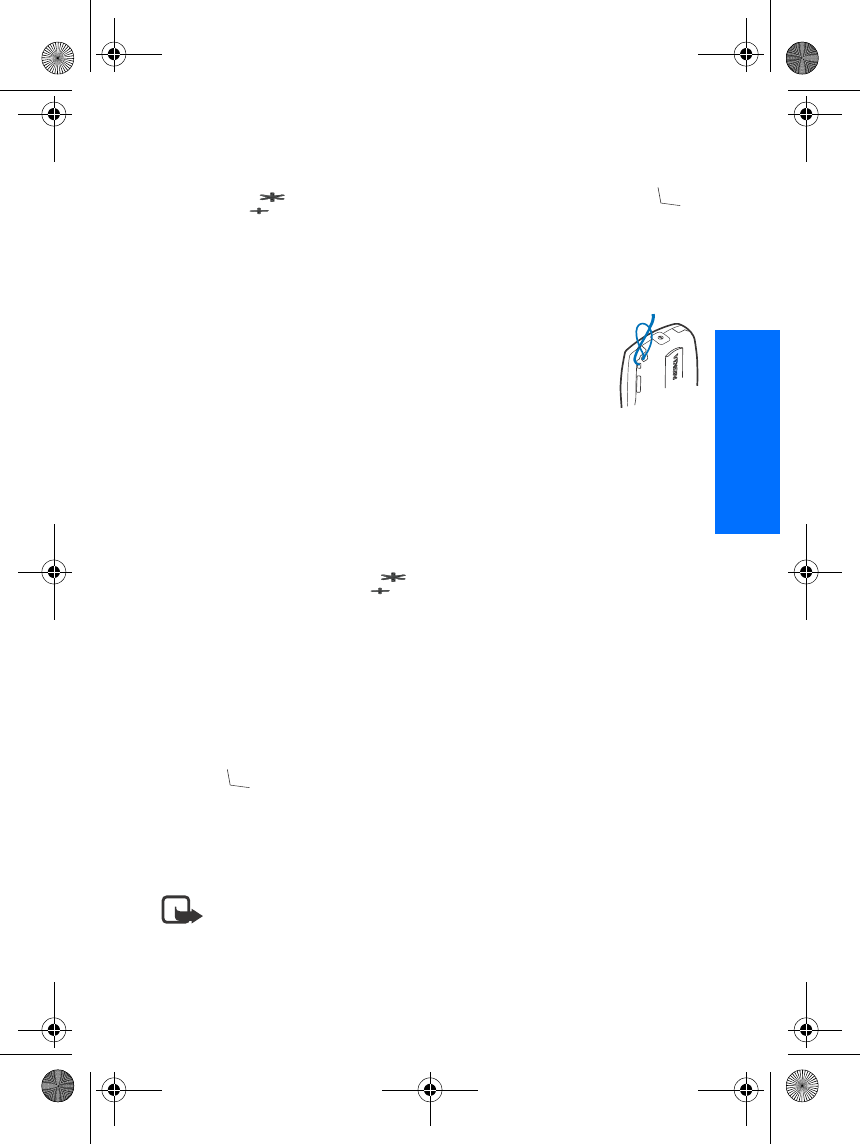
Getting started
9
English
Lock the keypad
• In standby mode, press Menu
and then within 1.5
seconds.
• You can also activate the
automatic keypad lock. If the
phone is in standby mode for the
preset period of time, the keypad
is locked automatically. Refer to
”Automatic keyguard” on page
44.
To handle calls when the keypad is
locked, refer to “Handle incoming
calls when keypad is locked” on
page 9.
Unlock the keypad
You can unlock the keypad by:
• Pressing Unlock and then
within 1.5 seconds.
• Or opening the flip cover of the
phone.
Handle incoming calls
when keypad is locked
You can answer an incoming call by
pressing when the keypad is
locked.
When you end or reject the call, the
keypad is automatically locked
again.
Note: When The keyguard
is on, calls may be possible
to the emergency number
programmed into your phone (e.g.
112, 911, or other official
emergency number). Key in the
emergency number and press .
The number is displayed only after
you have keyed in its last digit.
Put on the wrist strap
Thread the strap as
shown in the picture
and then tighten it.
3108_Dufu_fcc_1.1.fm Page 9 Friday, October 24, 2003 2:11 AM
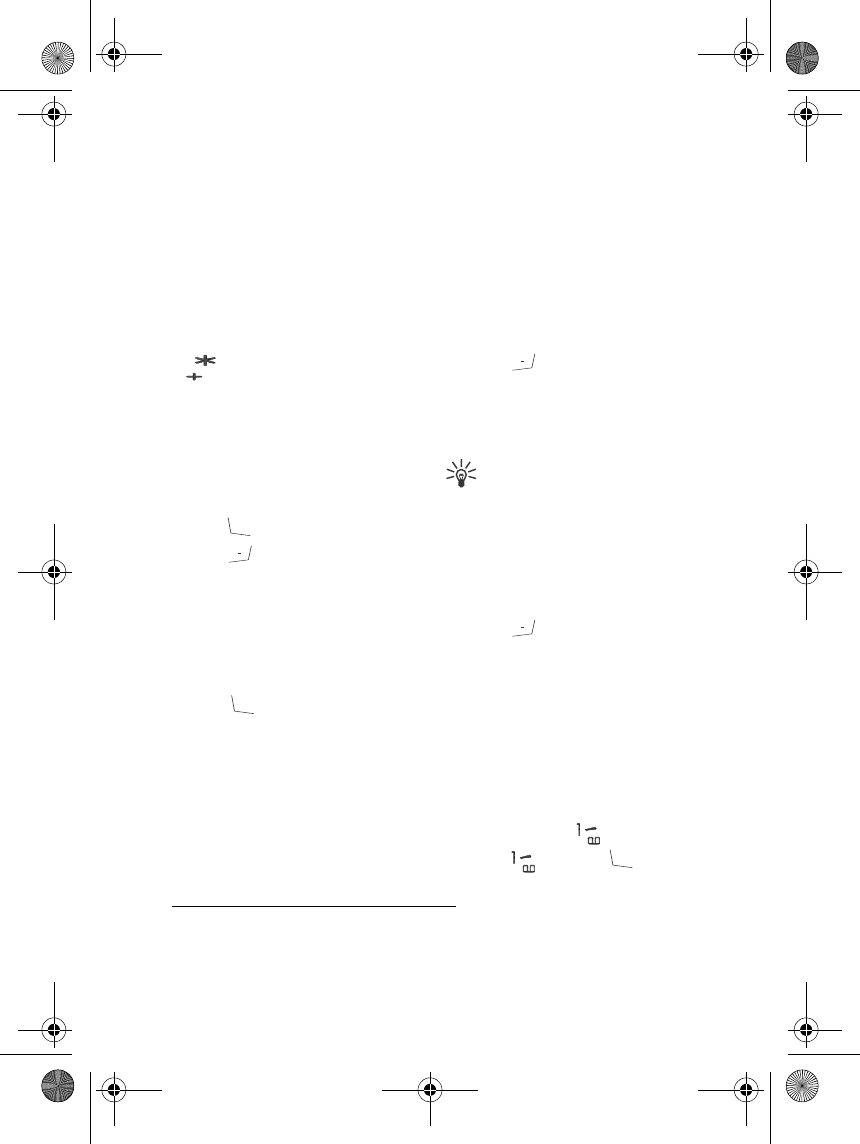
Call functions
10
3. Call functions
■Make a call
1. Key in the phone number, or get
it from your phone book (See
”Search for a name in the phone
book” on page 37).
For international calls1, press
twice for the international
prefix (the + character replaces
the international access code2)
and then key in the country code,
the area code without the
leading 0, if necessary, and the
phone number.
2. Press to call the number.
3. Press to end the call or to
cancel the call attempt.
■Answer a call
You can answer an incoming call
through the following ways:
• Press .
• Open the flip cover of the phone
to answer a voice call. Refer to
“Flip call handling” on page 43.
• Press Silence to mute the ringing
tone. Then press Options, and
select Answer to answer the call.
• When a compatible headset is
connected to the phone, press
the button on the headset to
answer the call.
■Reject a call
•Press .
• Press Silence to mute the ringing
tone. Then press Options, and
select Reject to reject the call.
Tip: If the Divert if busy
function is activated,
rejecting a call will also
divert the call. Refer to ”Call
divert” on page 42.
■End a call
•Press .
• Close the flip cover of the phone
to end a voice call. Refer to page
43.
■Call your voice mailbox
(network service)
In standby mode
• Press and hold , or
• Press , and then .
1. Note that some calls between the regions of one country (for example, in China
between mainland provinces and Hong Kong Special Administrative Region) are
also considered international calls.
2. Depending on your operator, you may still be able to use the international access
code (network services)
3108_Dufu_fcc_1.1.fm Page 10 Friday, October 24, 2003 2:11 AM

Call functions
11
English
Enter the voice mailbox number if
the phone asks for it. See also
”Voice messages” on page 31.
■Redial recently dialled
numbers
1. In standby mode, press .
A list of recently dialled
numbers (up to 20) is displayed.
2. Scroll to the number or name
you want.
3. Press to call the number.
Tip: In standby mode, press
twice to redial the last
number you dialled.
For more about recently dialled
calls, refer to “Call register (Menu
2)” on page 34.
To set automatic redial, see
“Automatic redial” on page 43.
■Speed dial a phone
number
Before you can use speed dialling,
assign the phone number to one of
the speed dialling keys, from
to , see ”Speed dials” on page
39. Call the number in either of the
following ways:
• Press the speed dialling key you
want and then press .
•Or,
1. Set Speed dialling which is
under Settings, Call settings
to on. See also ”Speed
dialling” on page 43.
2. Press and hold the speed
dialling key until the call is
started.
■In-call options
Many of the options during a call
are network services. Pressing
Options during a call may give
some of the following options (may
not be in the same order as in the
phone):
Mute or Unmute, End call, End all
calls, Contacts, Menu, Hold or
Unhold, New call, Conference,
Private, Answer, Reject, Lock
keypad, Send DTMF, Swap,
Transfer, and Loudspeaker or
Handset.
Make a new call
When you have an ongoing call,
you may be able to make a new call
by pressing Options, then select
New call (network service).
When the new call is active, the
original call is put on hold.
Handle a waiting call
After you activate the Call waiting
function in your phone, you may be
able to receive another call when
you have an ongoing call (network
service).
3108_Dufu_fcc_1.1.fm Page 11 Friday, October 24, 2003 2:11 AM
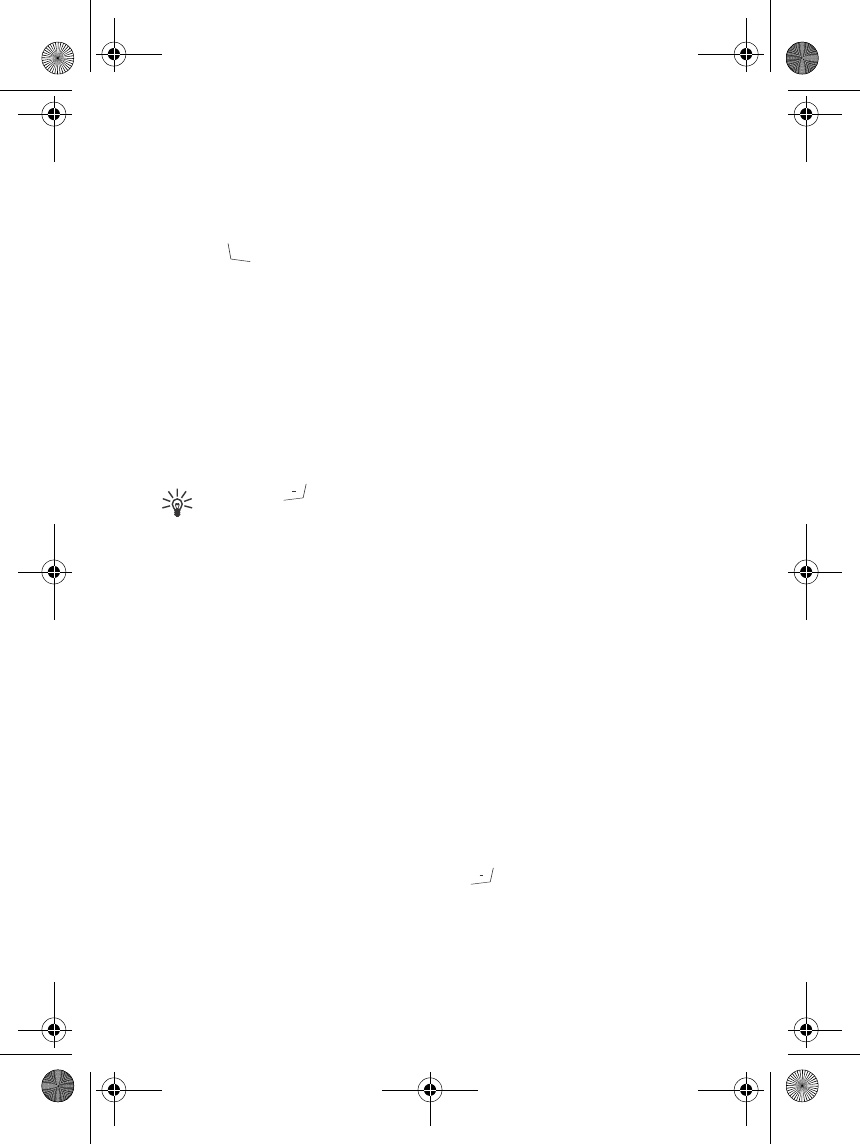
Call functions
12
Call waiting is under Settings, Call
settings. See also ”Call waiting” on
page 43.
To answer the waiting call
•Press .
• Press Answer if it’s available.
• Press Options, and select
Answer.
When the waiting call is active, the
original call is on hold.
To reject the waiting call
• Press Options, and select Reject.
• Press Reject if available.
Tip: Press to end the
active call.
■Swap calls (network
service)
When you have an active call and a
held call, you may be able to switch
their call status by pressing
Options, and select Swap. Then the
held call is active, and the
previously active call is put on hold.
■Transfer calls (network
service)
When you have an active call and a
held call, you may be able to
connect the other two parties by
pressing Options, and select
Transfer. Then your call with either
party is ended.
■Make a conference call
Conference calling is a network
service. It allows up to six people to
take part in a call.
1. Call the first participant.
2. To call a new participant, press
Options and select New call.
3. Enter, or find from the phone
book, the phone number of the
new participant, and press Call.
The first call is put on hold.
4. When the new call is answered,
join the first participant to the
call by pressing Options, and
select Conference.
Alternatively, the second
participant can call you after you
have established a call with the
first participant.
5. To add a new participant to the
conference call, repeat steps 2 to
4.
6. To have a private conversation
with one of the participants:
Press Options , select Private
and select the desired
participant. Rejoin the
conference call as described in
step 4.
7. To end the conference call, press
.
■Loudspeaker
You can turn on the loudspeaker
during a call.
3108_Dufu_fcc_1.1.fm Page 12 Friday, October 24, 2003 2:11 AM
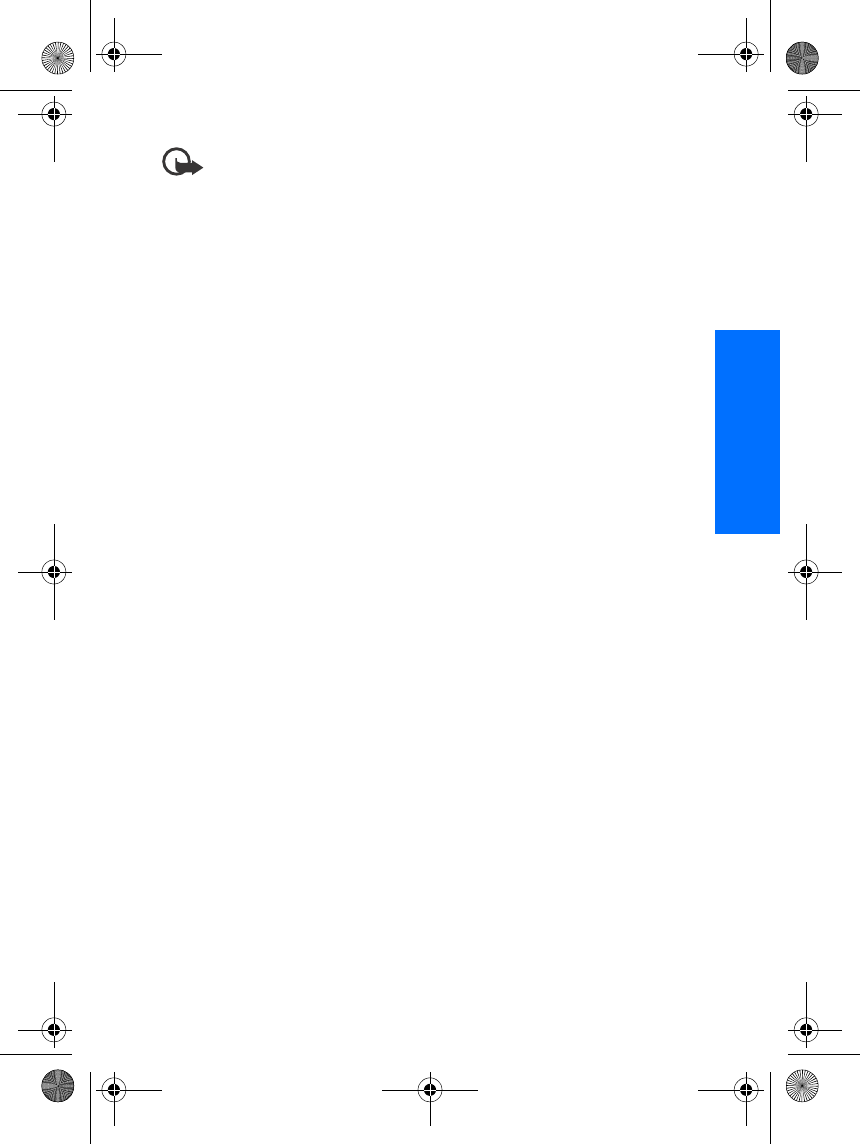
Call functions
13
English
Important: Do not hold the
phone to your ear during
loudspeaker operation.
• To activate the loudspeaker,
press Options and select
Loudspeaker, or press Loudsp.,
if available.
• To deactivate the loudspeaker
during a call, press Options and
select Handset, or press
Handset, if available.
If you have connected a
compatible handsfree or headset
to the phone, Handset in the
options list is replaced with
Handsfree or Headset and the
selection key Handset with
Handsfr. or Headset,
respectively.
The loudspeaker is
automatically deactivated when
you end the call, or when you
connect the handsfree unit or
headset to the phone.
■Answering or Ending a
call with the flip cover
You can answer or end a call with
the flip cover. For more
information, please see also
“Functions of the flip cover” on
page 2 and “Flip call handling” on
page 43
3108_Dufu_fcc_1.1.fm Page 13 Friday, October 24, 2003 2:11 AM
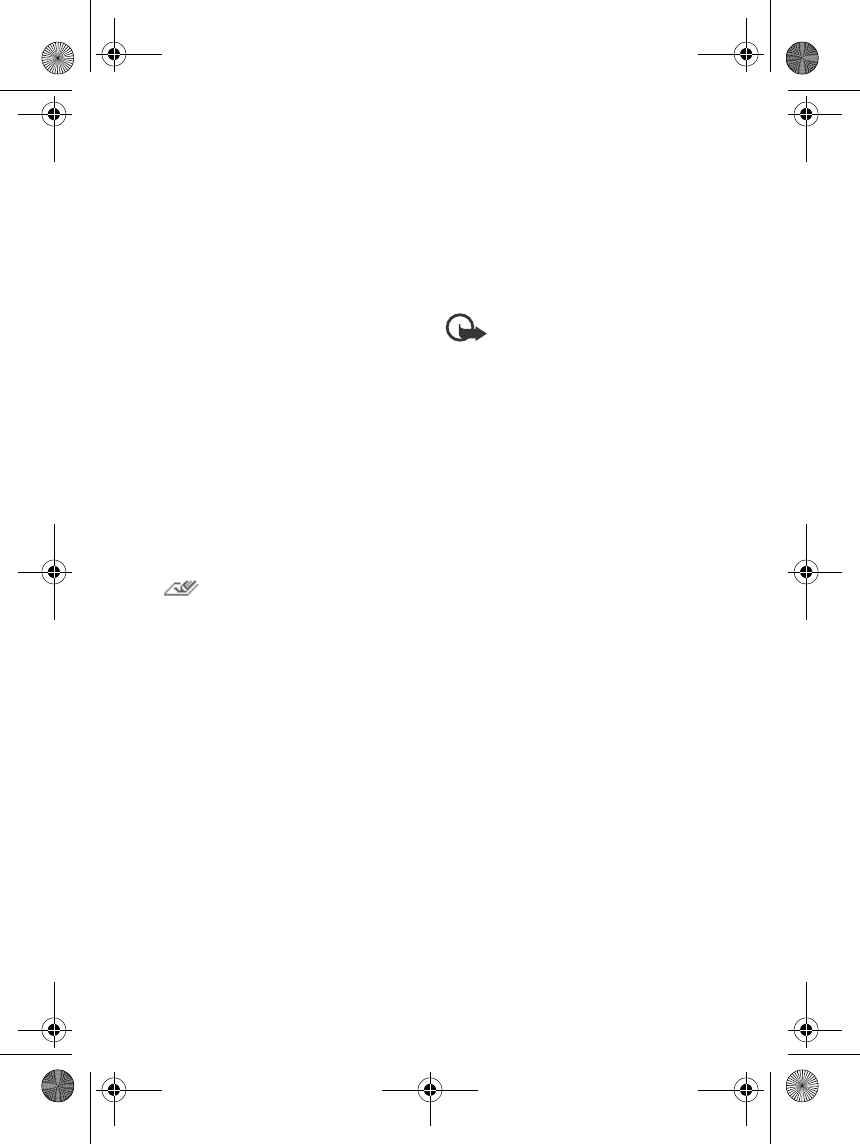
Handwriting input method
14
4. Handwriting input method
When you want to send a text
message, make a note, add a name
to the phone book, this phone
provides two different types of
input methods:
• keypad input method: using the
keypad for inputting. For more
information please see “Keypad
input methods” on page 20.
• handwriting input method: using
the stylus for handwriting
inputting. This chapter
illustrates how to use
handwriting input method.
When the flip cover is open,
handwriting input is indicated by
in your phone.
Note that handwriting input is
available only when the flip cover is
open and the handwriting input
indicator is displayed on the upper
left corner of the screen. You may
not be able to use handwriting input
methods anywhere you can input
with keys. For example,
• You must use the keypad to
input any password-type of
information, such as the PIN
code, PUK code, Security code,
Barring code, and the password
in certain functions and
applications.
• You can not enter a number with
handwriting input while the
phone is in standby mode, or in
calculator.
• You can not input time and date
with handwriting input.
Important: Use only a
stylus that has been
approved by Nokia to be
used in connection with this
device. Using other stylus
may invalidate any
warranty applying to the
phone and may damage the
touch pad. Avoid
scratching the touch pad.
Never use an actual pen or
pencil or other sharp
objects to write on the
touch pad.
■Writing with the stylus
When you want to enter text, open
the flip cover of the phone to
activate the touch pad, then write
gently in the middle of the touch
pad with the stylus.
3108_Dufu_fcc_1.1.fm Page 14 Friday, October 24, 2003 2:11 AM
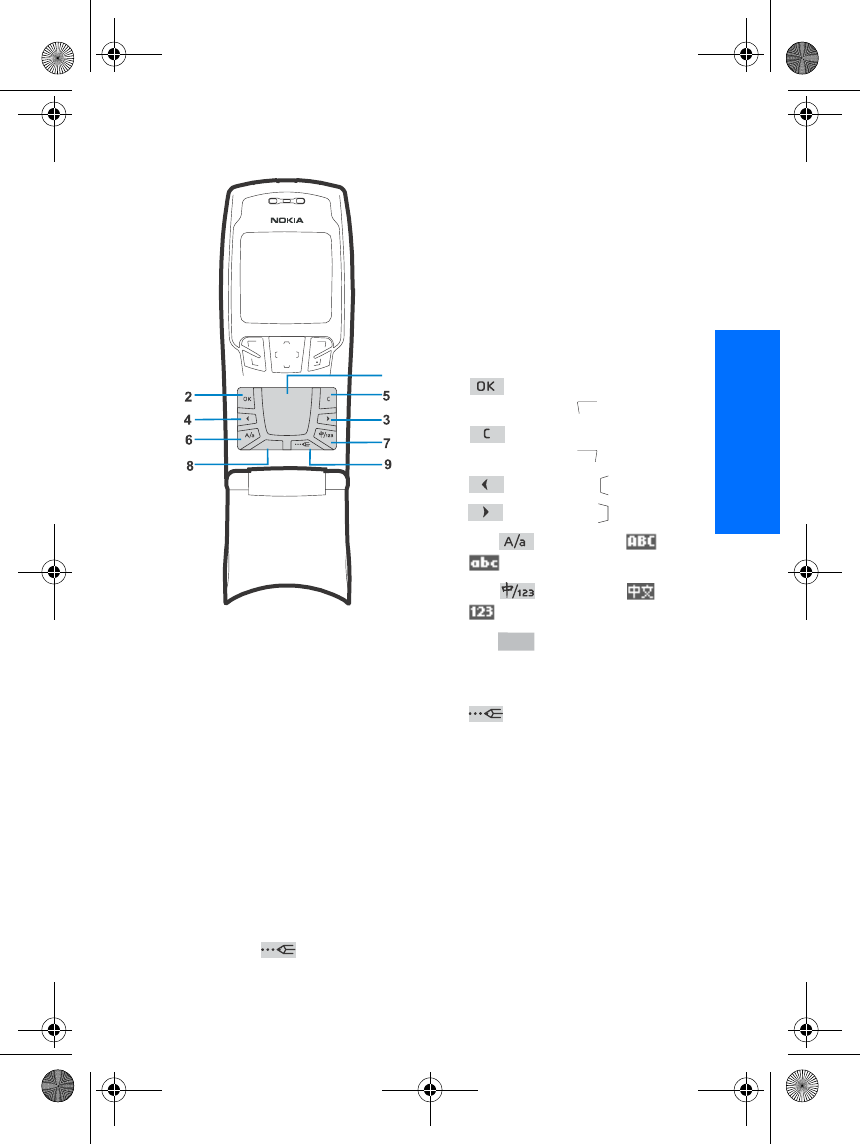
Handwriting input method
15
English
The middle of the touch pad is the
writing area (1). Surrounding the
writing area are eight functional
keys (2-9). Tap the functional keys
with the stylus for the relevant
functions when necessary.
The phone provides a list of seven
candidate characters or letters based
on the strokes you write. In
addition, when you are writing
Chinese text, the phone can also
provide a list of predicted Chinese
characters based on the Chinese
character to the left of the cursor
when you tap .
The following sections in this
chapter describe many important
concepts and methods, such as why
and how to change the input mode,
what is recognition time out, use of
gestures during writing, etc.. Please
read them carefully in order to use
the handwriting input method
efficiently.
1. Write in this box with the stylus.
2. functions as the left
selection key ( ).
3. functions as the right
selection key ( ).
4. functions as .
5. functions as .
6. Tap to switch to or
input mode.
7. Tap to switch to or
input mode.
8. Tap to list punctuation
marks and symbols.
9. When entering Chinese text, tap
to get a list of predicted
Chinese characters based on the
Chinese character to the left of
the cursor or the hightlighted
character. Note predictive input
is only available when you are
inputting Chinese
1
£
!
?
£
!
?
3108_Dufu_fcc_1.1.fm Page 15 Friday, October 24, 2003 2:11 AM
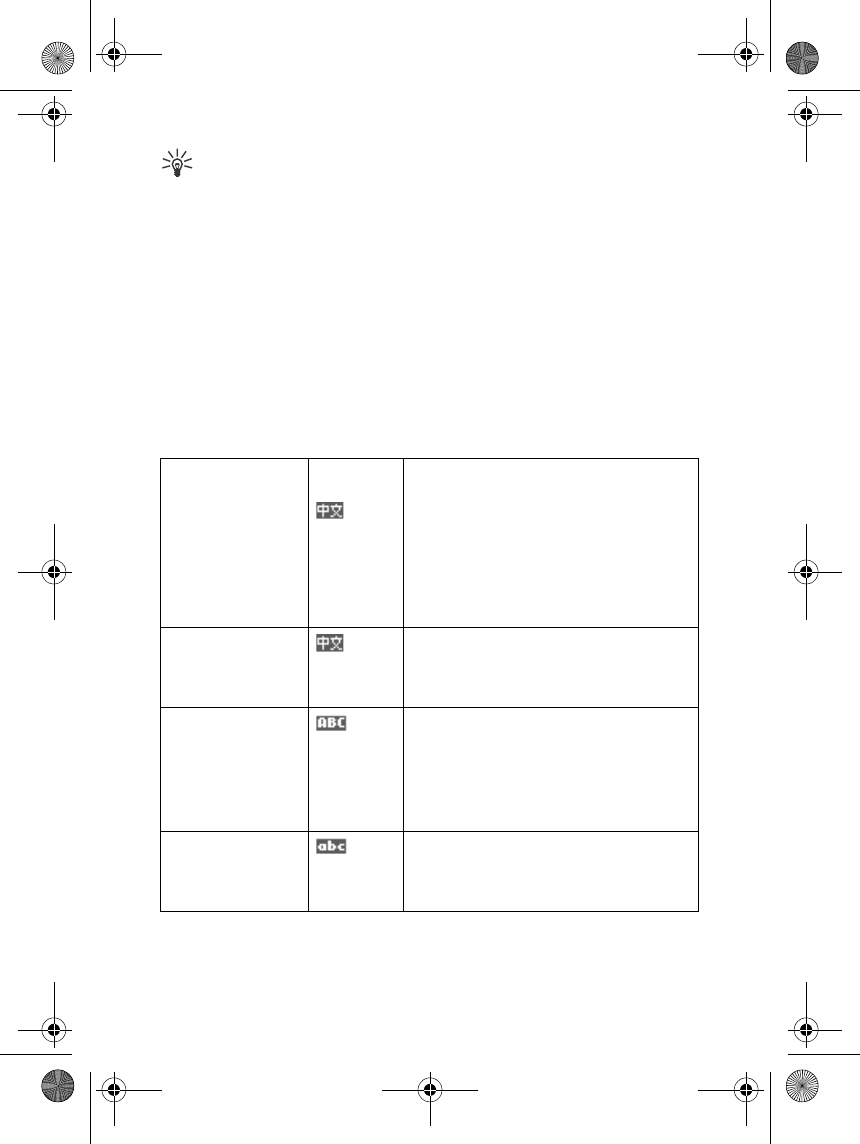
Handwriting input method
16
Tip: If the hightlighted
candidate character or letter
in the candidate list (not the
predicted list) is what you
want, you can continue
writing. The phone inputs the
character automatically.
■Handwriting input
modes
Different handwriting input modes
are available in your phone for
entering different types of text. This
narrows down the recognition
scope for each mode and thus
enable increased accuracy and
speed of recognition.
The strokes are recognised only as
the type of text pertaining to the
mode. Different recognition scopes
in different mode are described in
the following table.
Input mode indicator and
recognition scope
Mode Indicator Recognition scope
Simplified Chi-
nesea
• Simplified Chinese characters.
• Some frequently used full-width
punctuation marks and symbols, for
example:
、。! “”,:;?
Traditional Chi-
neseb
• Traditional Chinese characters.
• Some frequently used full-width
punctuation marks and symbols.
Upper case • Capital English letters.
• Some frequently used half-width
punctuation marks and symbols, for
example:
@ / ! " ’ , . : ; ?
Lower case • English letters in lower case.
• Some frequently used half-width
punctuation marks and symbols.
3108_Dufu_fcc_1.1.fm Page 16 Friday, October 24, 2003 2:11 AM
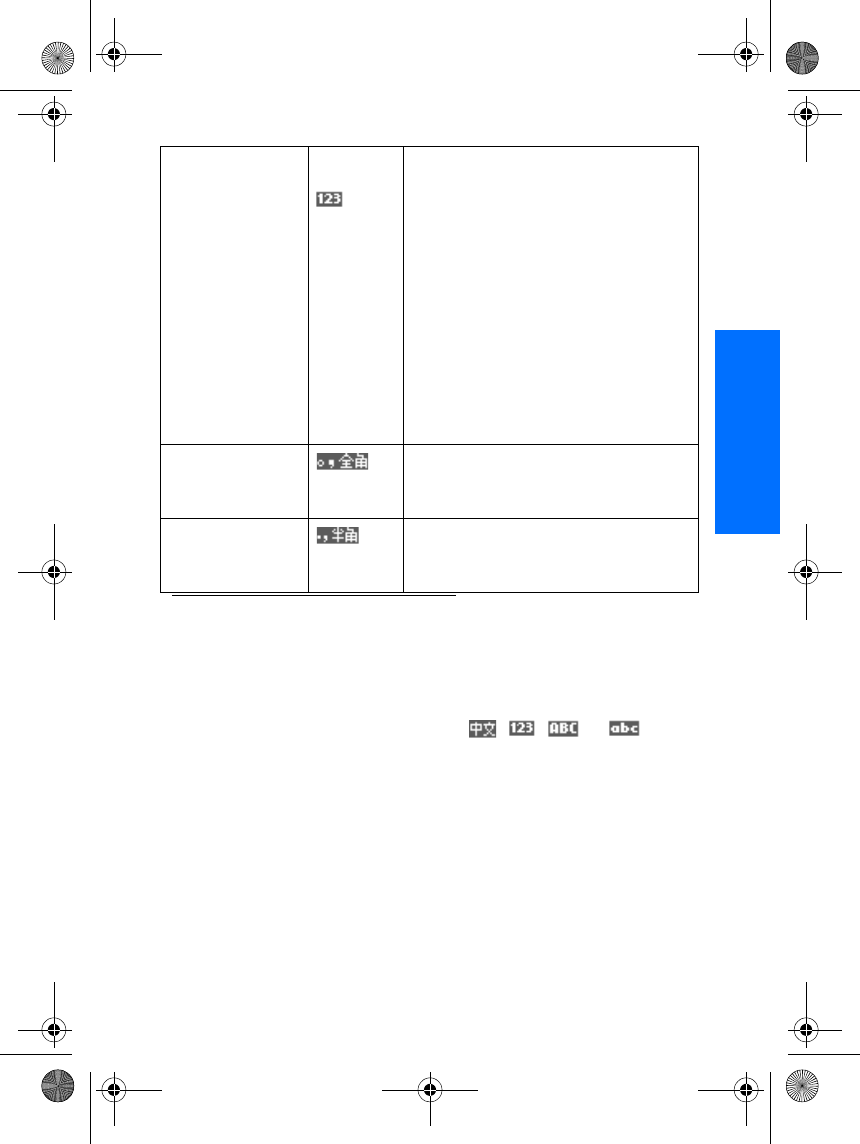
Handwriting input method
17
English
Note that the character set in your
phone does not include all the
characters in Chinese and that you
may not find all the characters you
want.
Switching between
handwriting input modes
You can s witch between
handwriting input modes in two
ways:
• Tap the corresponding touch-
key with the stylus to switch to
, , , or .Note
under some circumstances not
all the modes are available.
• Press Options if it is available,
and select the desired mode
from the list.
■Recognition timeout
Recognition timeout is the
maximum interval time allowed
between two strokes input when
Number Different recognition scope in different
context, for example:
• In the context of entering text: some
frequently used half-width punctua-
tion marks and symbols in addition
to numbers.
• In the context of entering phone
numbers: *, +, p, w, # in addition to
numbers.
• In the context of entering IP
addresses: Dot (.) and numbers.
Full-width punctu-
ation marks &
symbols
Full-width punctuation marks and sym-
bols
Half-width punctu-
ation marks &
symbols
Half-width punctuation marks and sym-
bols
a. Available only in phones sold to mainland China, Indonesia, Malaysia, Singapore,
and Vietnam.
b. Available only in phones sold to China Hong Kong SAR, and China Taiwan.
Mode Indicator Recognition scope
3108_Dufu_fcc_1.1.fm Page 17 Friday, October 24, 2003 2:11 AM
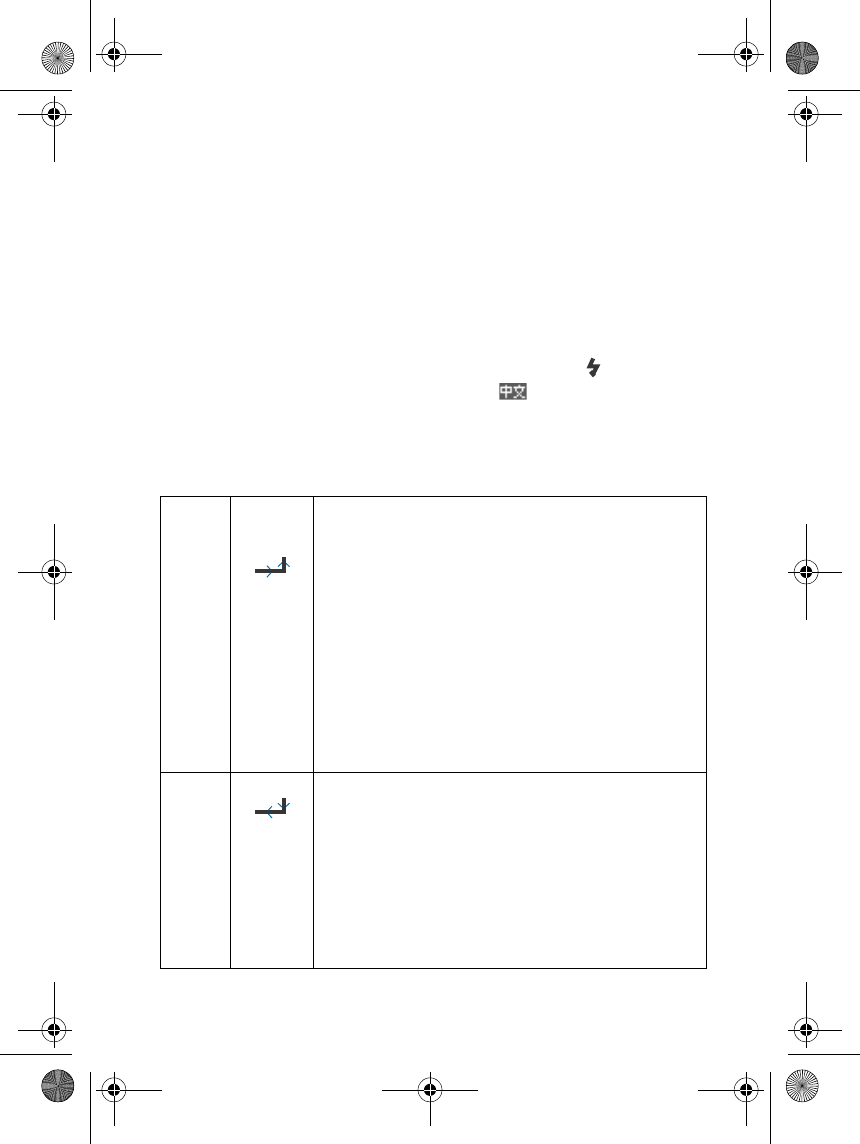
Handwriting input method
18
writing a character or letter. Every
time you finish a stroke and lift the
stylus from the touch pad, the
phone begins to count time. If you
do not
the next stroke within the timeout,
it’s considered that you have
finished writing the character or
letter, and the phone begins to
recognise the strokes, and displays
a list of candidates.
The default recognition timeout
setting is Normal. If you want to
write faster or slower, you can
change the timeout in Settings,
Phone settings, Recognition time-
out. Refer to “Recognition time-
out” on page 44.
■Use gestures
You can write several gestures for
certain functions.
The gestures include: Space, Enter,
Clear, and Repeat. See the table
below. You can use (Repeat)
only in mode, but other
gestures in all handwriting input
modes.
Name Gesture Functions
Space • When the cursor is blinking in the editing window,
writing the gesture inserts a space to the left of the
cursor.
• When the candidate list is shown, writing the ges-
ture inputs the highlighted candidate and inserts a
space after it.
• When the list of predicted Chinese candidates is
shown, writing this gesture clears the list and
inserts a space to the left of the cursor in the edit-
ing window.
Enter • When the cursor is blinking in the editing window,
writing the gesture inserts a line feed.
• When the candidate list is shown, writing the ges-
ture inputs the highlighted candidate and inserts a
line feed.
• When the list of predicted Chinese candidates is
shown, writing this gesture clears the list and
inserts a line feed.
3108_Dufu_fcc_1.1.fm Page 18 Friday, October 24, 2003 2:11 AM
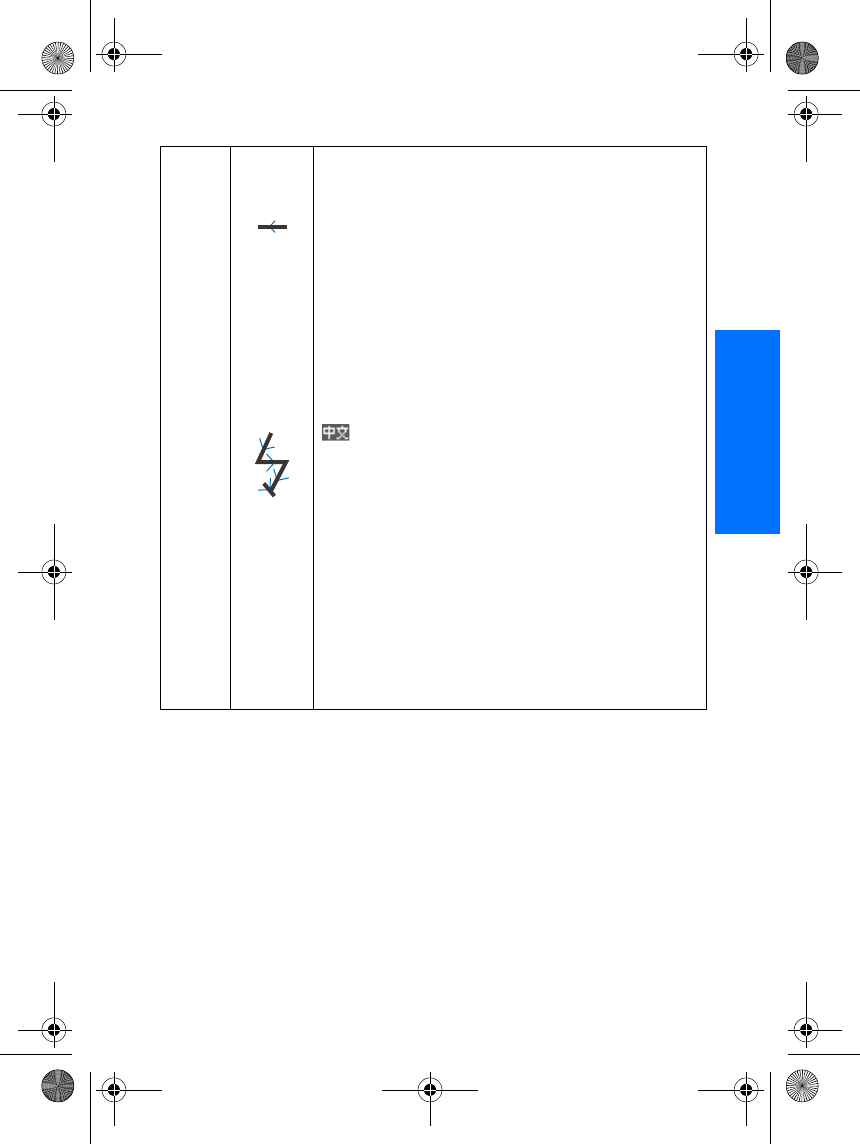
Handwriting input method
19
English
■Touch pad tone
A tone sounds when you press the
stylus on the touch pad to start
writing a stroke, or tap the
functional keys with the stylus. You
can set the level tone together with
the keypad tone in Settings, Tone
settings, Keypad tones. Refer to
“Tone settings” on page 46.
Clear • When the cursor is blinking, writing the gesture
deletes the Chinese character, English letter, num-
ber, or punctuation mark or symbol to the left of
the cursor.
• When the list of candidates or predicted Chinese
candidates is shown, writing the gesture clears the
list and deletes the Chinese character, English let-
ter, number, or punctuation mark or symbol to the
left of the cursor.
Repeat You can only use the stroke when the input method is
.
• After you have just input a Chinese character,
writing the gesture inputs the same Chinese char-
acter again.
• When the list of the candidate Chinese characters
is shown, writing the gesture inputs the high-
lighted Chinese candidate twice.
• When the list of the predicted Chinese candidates
is shown, writing the gesture ignore the list and
inputs Chinese character to the left of the cursor
again..
Note this gesture only works with Chinese characters.
Name Gesture Functions
3108_Dufu_fcc_1.1.fm Page 19 Friday, October 24, 2003 2:11 AM
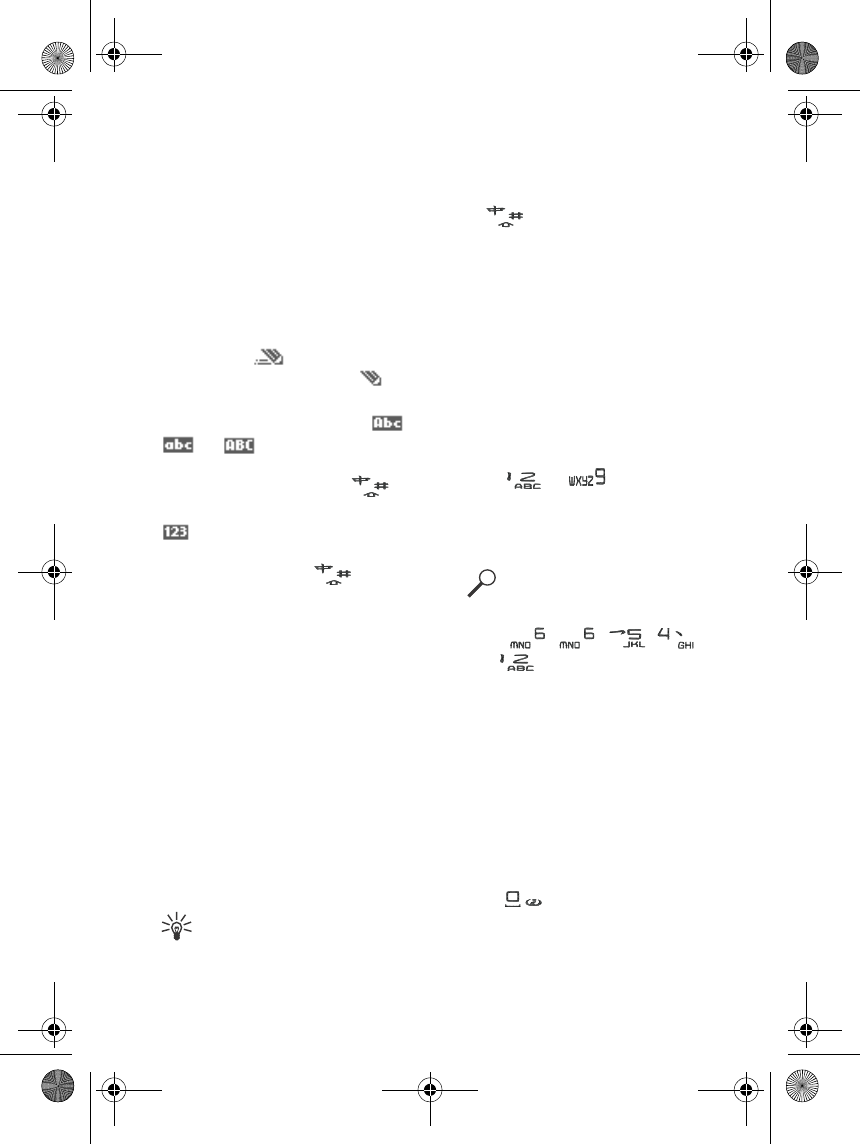
Keypad input methods
20
5. Keypad input methods
You can key in text, for example,
when writing messages, using
traditional or predictive English
input.
When you are writing text, the
predictive English input is
indicated by and the
traditional English input by at
the top left of the display. The
character case is indicated by ,
, or next to the text input
indicator. You can change the
character case by pressing .
The number mode is indicated by
, and you can change between
the letter and number mode by
pressing and holding .
■Setting predictive
English input on or off
When writing text, press Options
and select Dictionary.
• To set the predictive English
input on, select English in the
dictionary options list.
Predictive English input is only
available for the languages on
the list.
• To revert to traditional English
input, select Dictionary off.
Tip: To quickly set the
predictive English input on
or off when writing text,
press twice, or press and hold
Options.
■Using predictive
English input
You can key in any letter with a
single keypress. The predictive
English input is based on a built-in
dictionary to which you can also
add new words.
1. Start writing a word using the
keys to . Press each
key only once for one letter. The
word changes after each
keystroke.
Example: To write Nokia
when the English
dictionary is selected,
press , , ,
and .
To insert a number while in
letter mode, press and hold the
desired number key.
More instructions for writing
text, see ”Tips for writing text”
on page 21.
2. When you have finished writing
the word and it is correct,
confirm it by adding a space
with or by pressing any of
the scroll keys. Pressing a scroll
key also moves the cursor.
If the word is not correct,
3108_Dufu_fcc_1.1.fm Page 20 Friday, October 24, 2003 2:11 AM
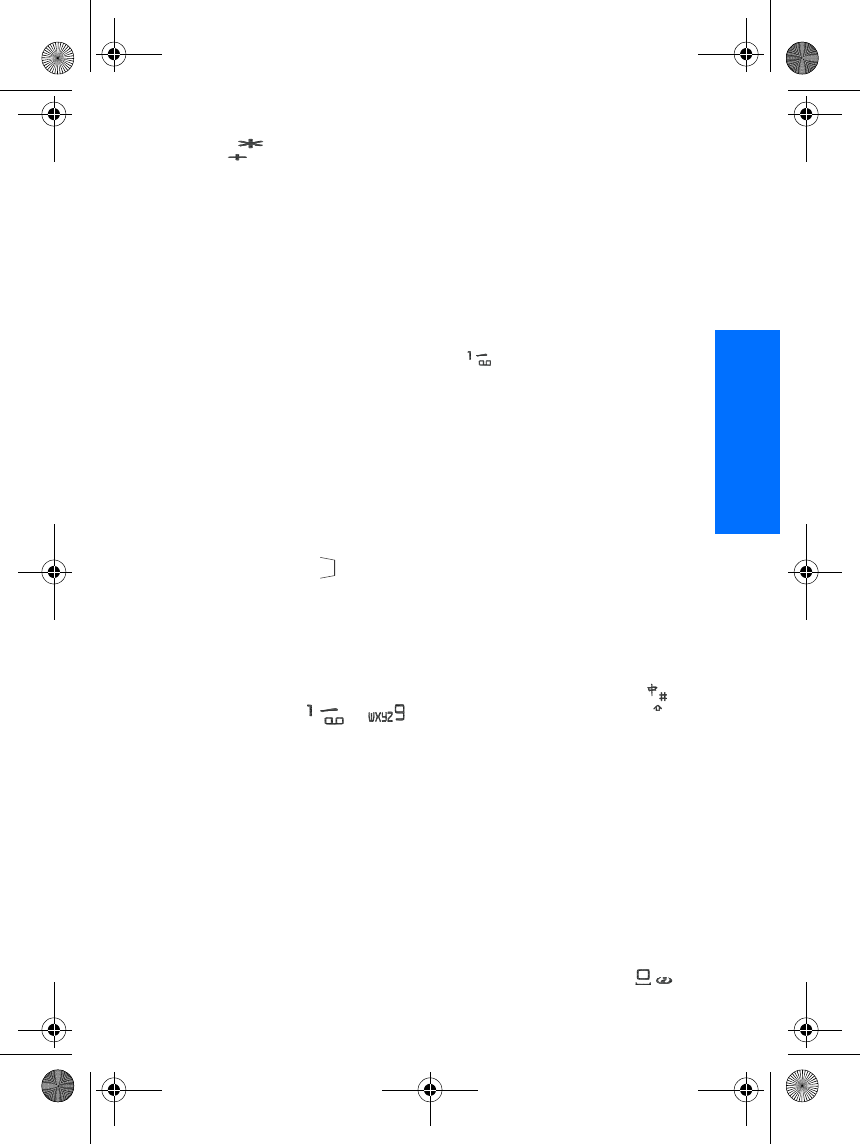
Keypad input methods
21
English
press repeatedly or press
Options and select Matches.
When the word you want
appears, confirm it.
If the ? character is displayed
after the word, the word you
intended to write is not in the
dictionary. To add the word to
the dictionary, press Spell, key
in the word (traditional English
input is used) and press Save.
When the dictionary becomes
full, the new word replaces the
oldest one that was added.
3. Start writing the next word.
Writing compound words
Key in the first part of the word and
confirm it by pressing . Write the
last part of the word and confirm
the word.
■Using traditional
English input
Press a number key, to ,
repeatedly until the desired
character appears. Not all
characters available under a number
key are printed on the key. The
characters available depend on the
language selected in the Phone
language menu, see ”Language
settings” on page 44.
To insert a number while in letter
mode, press and hold the desired
number key.
• If the next letter you want is
located on the same key as the
present one, wait until the cursor
appears, or press any of the
scroll keys and then key in the
letter.
• The most common punctuation
marks and special characters are
available under the number key
.
For more instructions for writing
text, see ”Tips for writing text” on
page 21.
■Changing writing
language.
You may change the writing
language if the phone support the
writing language you want:
• Permanently change the writing
language. Please refer to
“Language settings” on page 44.
• Temporarily change the writing
language. Press and hold ,
select Writing language and then
the language you want to use.
When you quit editing or
inputting, the writing language
will change back to the
permanent writing language you
have set.
■Tips for writing text
The following functions may also
be available for writing text:
• To insert a space, press .
3108_Dufu_fcc_1.1.fm Page 21 Friday, October 24, 2003 2:11 AM
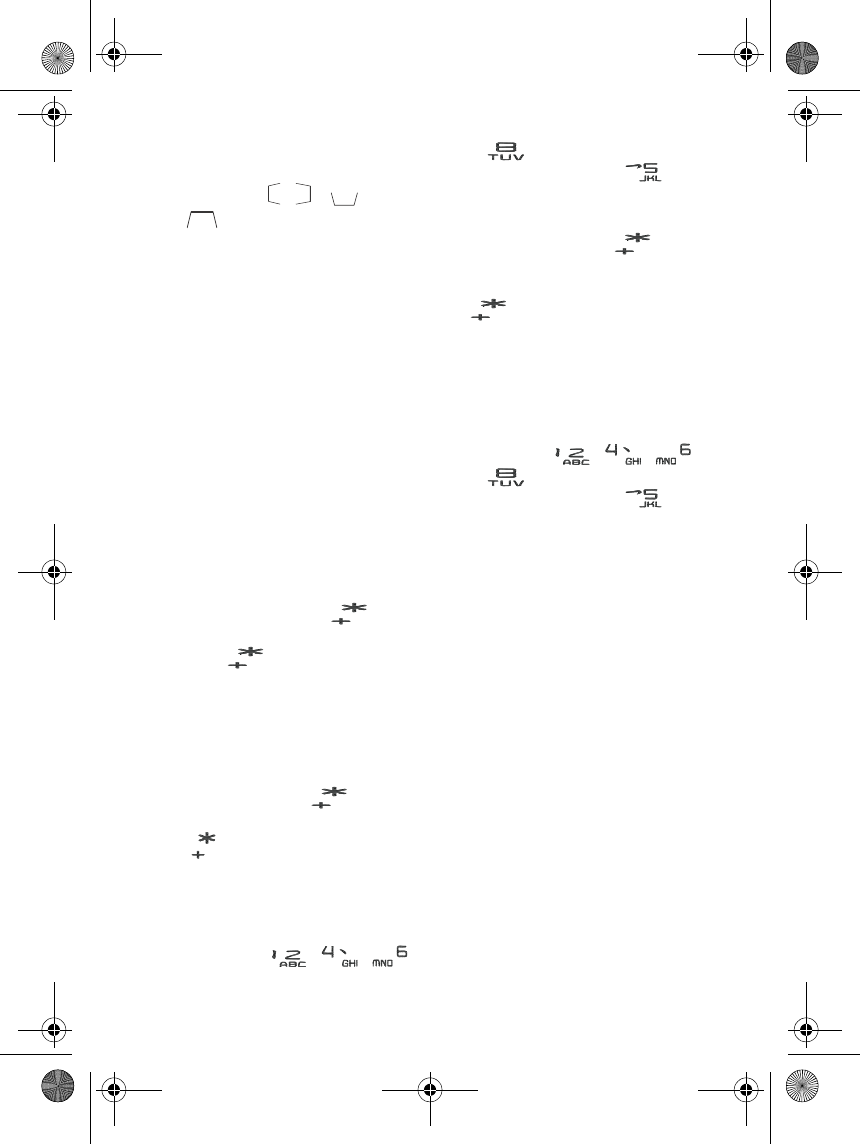
Keypad input methods
22
• To move the cursor to the left,
right, down or up, press the
scroll keys , , or
, respectively.
• To delete a character to the left
of the cursor, press Clear. Press
and hold Clear to delete the
characters more quickly.
To delete all the characters at
once when writing a message,
press Options and select Clear
text.
• To insert a word when using the
predictive English input, press
Options and select Insert word.
Write the word using the
traditional English input and
press Save. The word is also
added to the dictionary.
• When using the traditional
English input, press to
insert a special character, or
press twice to insert a
smiley. When using the
predictive English input, press
Options and select Insert symbol
to insert a special character or
Insert smiley to insert a smiley;
or press and hold to insert
a special character and press
again to insert a smiley.
Press any of the scroll keys to
scroll to a character and press
Use to select the character.
You can also scroll to a character
by pressing , ,
or , and select the
character by pressing .
• To insert a special character
when using the traditional
English input, press , or
when using the predictive
English input, press and hold
, or press Options and
select Insert symbol.
Press any of the scroll keys to
scroll to a character and press
Use to select the character.
You can also scroll to a character
by pressing , ,
or , and select the
character by pressing .
3108_Dufu_fcc_1.1.fm Page 22 Friday, October 24, 2003 2:11 AM
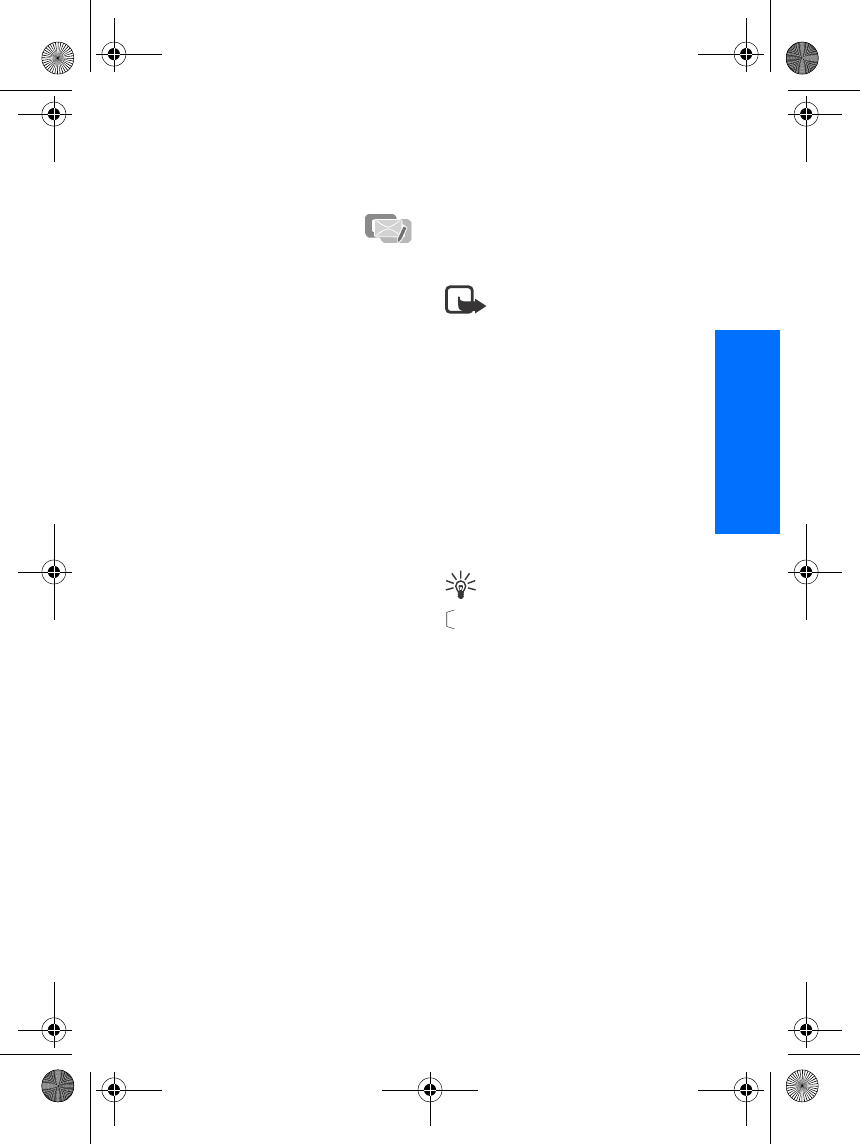
Menu functions
23
English
6. Menu functions
■Messages (Menu
1)
You can read, compose, send and
save text and multimedia messages
to and from compatible devices
(network services). All messages
are organised into folders.
Before you can send any text, or
picture, you need to save your
message centre number, see
”Message settings” on page 32.
Text messages
Your phone can send and receive
multi-part messages, which consist
of several ordinary text messages
(network service). This may affect
the invoicing for the message. You
can check the number of characters
available and messages to be sent in
the counter on top of the screen.
Note that some characters may
require more space than others, for
example Chinese characters require
more space than English letters, and
the counter may adjust the number
of maximum number of characters
available accordingly. For pricing
of multi-part messages, contact
your service provider.
You can also send and receive text
messages that contain pictures.
Each picture message is made up of
several text messages. Therefore,
sending one picture message may
cost more than sending one text
message.
Note:The picture message
function can be used only if
it is supported by your
network operator or service
provider. Only phones that offer
picture message features can
receive and display picture
messages.
Compose and send messages
1. Press Menu, and select
Messages, Text messages and
Create message.
Tip: To quickly open the
Create message menu, press
in standby mode.
2. Compose the message.
• To insert text templates or a
picture into the message, see
”Templates” on page 26.
• To insert a number, press
Options and select Insert
number. Enter the number
you want to insert or search
for it in the phone book and
press OK.
• To insert a name from the
phone book, press Options,
and select Insert contact.
Highlight the name you want,
then press Options. To insert
3108_Dufu_fcc_1.1.fm Page 23 Friday, October 24, 2003 2:11 AM
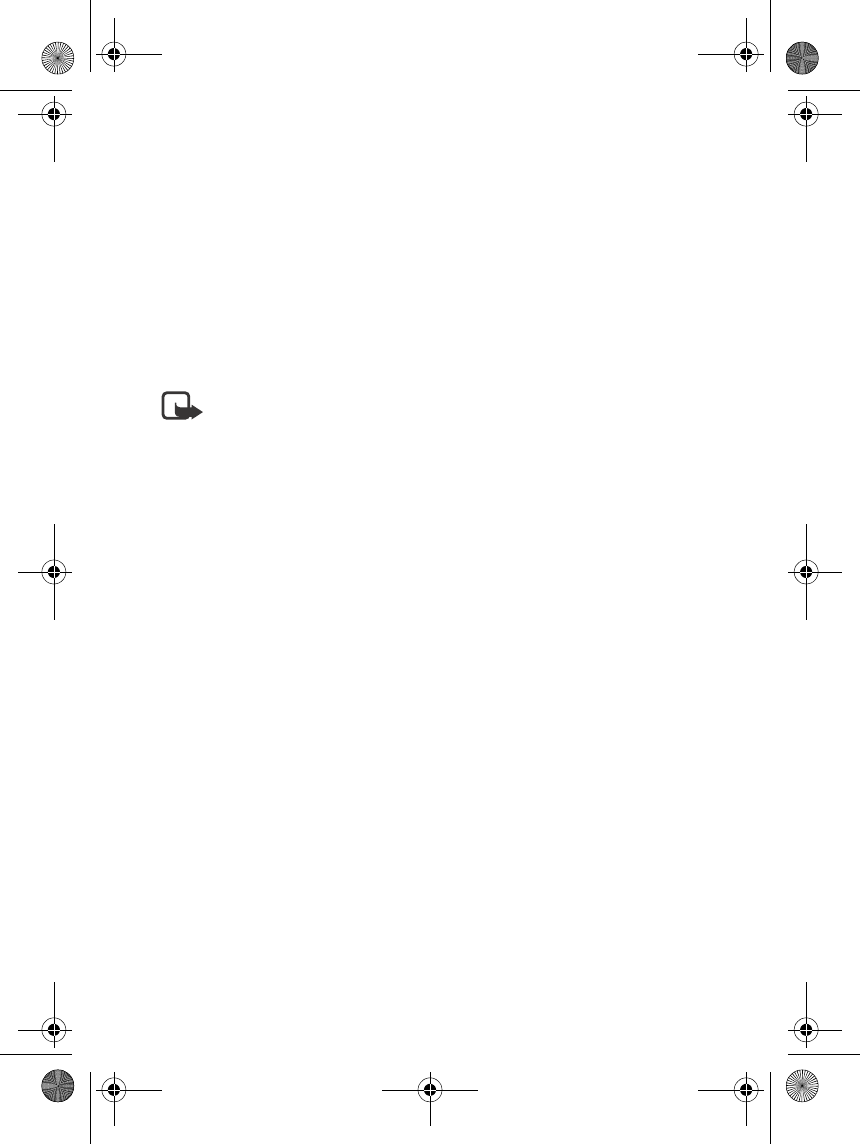
Menu functions
24
a phone number or a text item
attached to the name, press
Options, and select View
details.
3. To send the message, press
Options and select Send.
4. Enter the recipient’s phone
number or get it from your
phone book.
Press OK to send the message.
Note: When sending
messages via the SMS
network service, your
phone may display the
words Message sent. This is
an indication that the
message has been sent by your
phone to the message centre
number programmed into your
phone. This is not an indication that
the message has been received at
the intended destination. For more
details about SMS services, check
with your service provider.
Options for sending a message
After you have written a message,
press Options and select Sending
options.
• To send a message to several
recipients, select Send to many.
When you have sent the
message to everyone you want
to send it to, press Done.
• To send a message using a
message profile, select Sending
profile and then the desired
message profile.
To define a message profile, see
”Message settings” on page 32.
Composing and sending SMS e-
mail
Nokia 3108 phone provides e-mail
feature:
• SMS e-mail: sending email via
SMS. The following section
describes how to use SMS e-
mail.
Before you can send SMS e-mail ,
you need to save the settings for
sending SMS e-mail, see ”Message
settings” on page 32. For
availability and subscription to the
SMS e-mail service, contact your
network operator or service
provider. To save an e-mail address
in Contacts, see ”Save multiple
numbers and text items per name”
on page 37.
1. Press Menu, and select
Messages, Text messages and
Create SMS e-mail.
2. Key in the recipient’s e-mail
address or search for it in
Contacts and press OK.
3. If you wish, you can key in the
subject for the SMS e-mail and
press OK.
4. Key in the SMS e-mail message.
See ”Keypad input methods” on
page 20. The total number of
characters that you can key in is
3108_Dufu_fcc_1.1.fm Page 24 Friday, October 24, 2003 2:11 AM
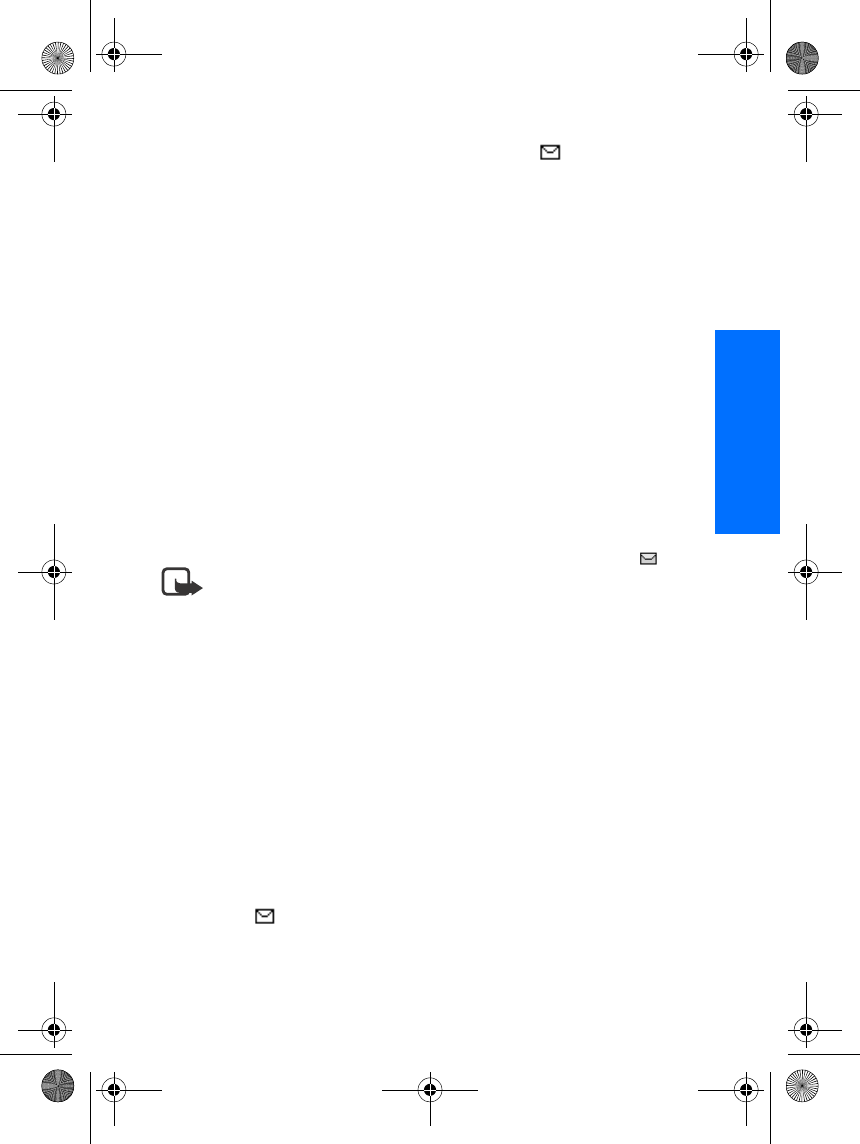
Menu functions
25
English
shown on the top right of the
display. The e-mail address and
subject are included in the total
number of characters.See also
the description about multi-part
messages on page 23.
See also ”Insert a text template
into a message” on page 26.
Pictures cannot be inserted.
5. To send the SMS e-mail, press
Options and select Send SMS e-
mail. If you have not saved the
settings for sending SMS e-
mails, the phone asks for the
number of the SMS e-mail
server.
Press OK to send the SMS e-
mail.
Note: When sending e-
mails via the SMS network
service, your phone may
display the words Message
sent. This is an indication
that the e-mail has been sent by
your phone to the e-mail server.
This is not an indication that the e-
mail has been received at the
intended destination. For more
details about e-mail services, check
with your service provider.
Read and reply to a message
When you have received a message,
the indicator and the number of
new messages followed by
Messages received are shown.
The blinking indicates that the
message memory is full. Before you
can receive new messages, delete
some of your old messages.
The text messages function uses
shared memory. Refer to ”Shared
memory” on page 0.
1. Press Show to view the new
message, or press Exit to view it
later.
Reading the message later:
Press Menu, and select
Messages, Text messages and
Inbox.
2. If more than one message has
been received, select the one that
you want to read. An unread
message is indicated by .
3. While reading or viewing the
message, press Options.
You can select an option, for
example, to delete, forward or
edit the message as a text
message or an SMS e-mail,
move and rename the message
you are reading.
Select Copy to calendar to copy
text at the beginning of the
message to your phone’s
calendar as a reminder note for
the current day. For more
information about calendar, see
“Calendar” on page 51.
Select Message details to view
the sender’s name and phone
number, the message centre
3108_Dufu_fcc_1.1.fm Page 25 Friday, October 24, 2003 2:11 AM
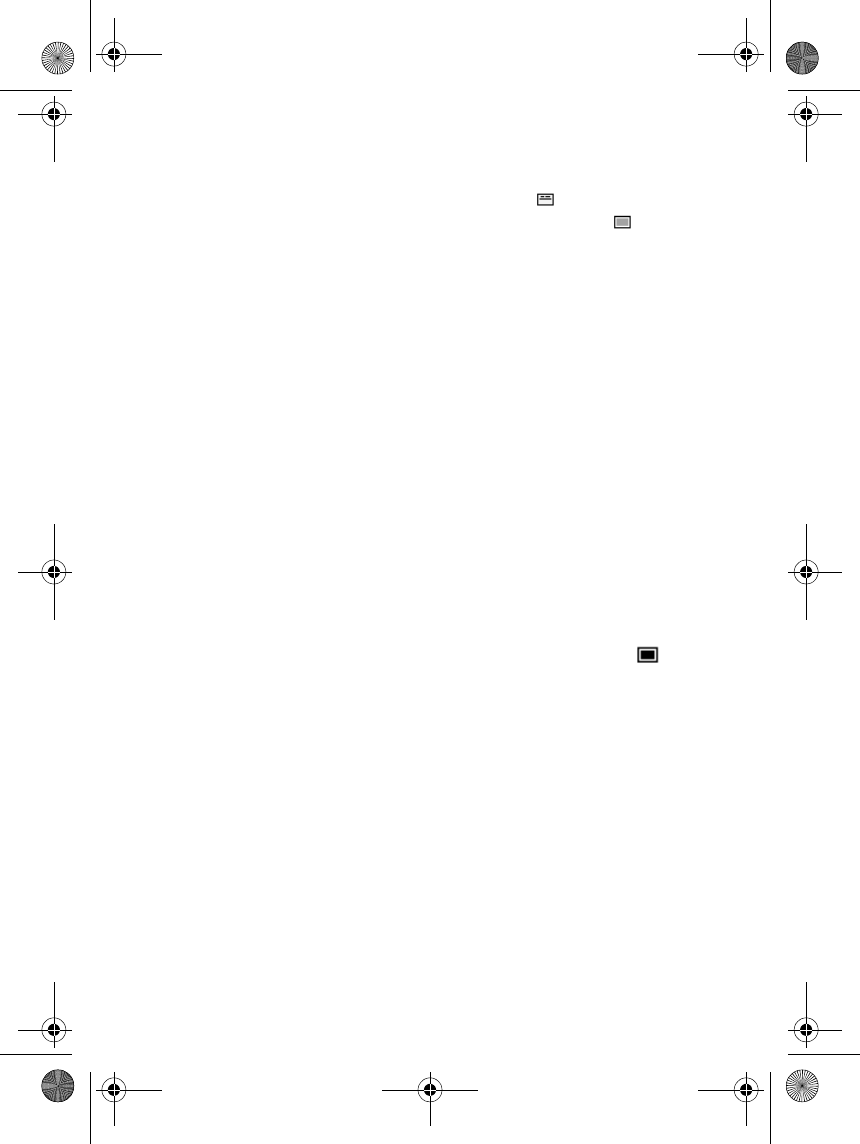
Menu functions
26
used, and the date and time of
receipt.
Select Use detail to extract
numbers, e-mail addresses and
website addresses from the
current message. Please note
that only those website and e-
mail addresses with spaces
separating them from the other
texts on either side can be
identified.
When reading a picture
message, select Save picture to
save the picture in the Templa te s
folder.
4. Select Reply to reply to a
message. Select Original text to
include the original message in
the reply, or select a standard
answer to be included in the
reply, or select Empty screen.
5. Press Options, select Send, and
press OK to send the message to
the displayed number.
Inbox and outbox folders
The phone saves incoming text
messages in the Inbox folder and
sent messages in the Sent items
folder of the Text messages
submenu.
Text messages that you wish to send
later can be saved in the Archive, or
Templates folder.
Templates
Your phone includes text templates,
indicated by , and picture
templates, indicated by .
To access the template list, press
Menu, and select Messages, Text
messages and Templ at es.
Insert a text template into a
message
• When you are writing or
replying to a message , press
Options. Select Use template
and select the template that you
want to insert.
Insert a picture into a text
message
• When you are writing or
replying to a message, press
Options. Select Insert picture
and select a picture to view it.
Press Insert to insert the picture
into your message. The
indicator in the header of the
message indicates that a picture
has been attached. The number
of characters that you can enter
in a message, depends on the
size of the picture.
To view the text and the picture
together before sending the
message, press Options and
select Preview.
Archive folder and my folders
To organise your messages, you can
move some of them to the Archive
3108_Dufu_fcc_1.1.fm Page 26 Friday, October 24, 2003 2:11 AM
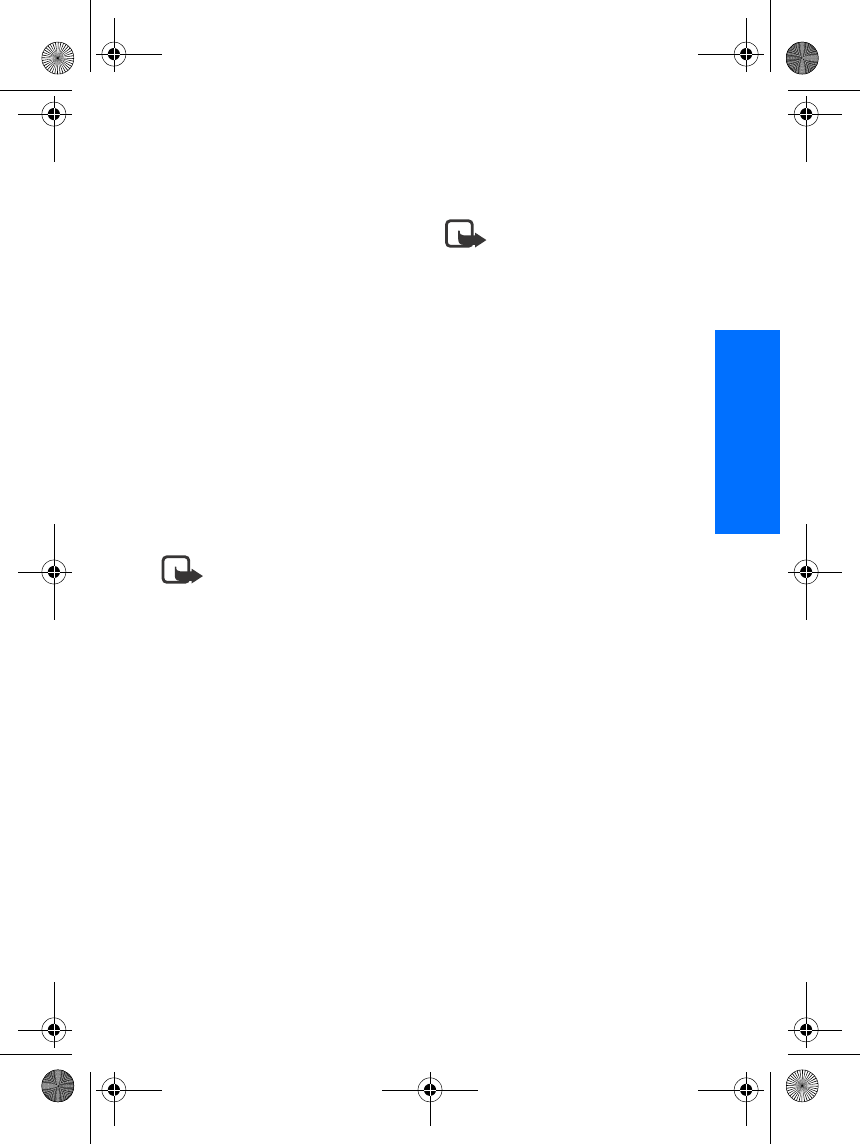
Menu functions
27
English
folder, or add new folders for your
messages.
While reading a message, press
Options. Select Move, scroll to the
folder that you want to move the
message to and press Select.
To add or delete a folder, press
Menu, and select Messages, Text
messages, and My folders.
• To add a folder, press Options
and select, Add folder.
• To delete a folder, scroll to the
folder that you want to delete,
press Options and select Delete
folder.
Multimedia messages
Note: This function can be
used only if it is supported
by your network operator
or service provider. Only
phones that offer compatible
multimedia message features can
receive and display multimedia
messages.
A multimedia message can contain
text, sound and a picture. The phone
supports multimedia messages that
are up to 45 KB in size. If the
maximum size is exceeded, the
phone may not be able to receive
the message. Depending on the
network, you may receive a text
message that includes an Internet
address where you can view the
multimedia message.
If the message contains a picture,
the phone scales it down to fit the
display area.
Note: If Allow multimedia
reception is set to Yes or In
home network, your
operator or service provider may
charge you for every message you
receive.
Multimedia messaging supports the
following formats:
• Picture: JPEG, GIF, PNG, and
BMP.
• Sound: Scalable Polyphonic
MIDI (SP-MIDI) and
monophonic ringing tones.
The phone does not necessarily
support all variations of the file
formats mentioned above. If a
received message contains any
unsupported elements, they may be
replaced with the file name and the
text Object format not supported.
Note that you are not able to receive
any multimedia messages if you
have a call in progress, a game or
another Java application running, or
an active browsing session over
GSM data (see ”Keying in the
service settings manually” on page
59). Because delivery of
multimedia messages can fail for a
variety of reasons, do not rely
solely upon them for essential
communications.
3108_Dufu_fcc_1.1.fm Page 27 Friday, October 24, 2003 2:11 AM
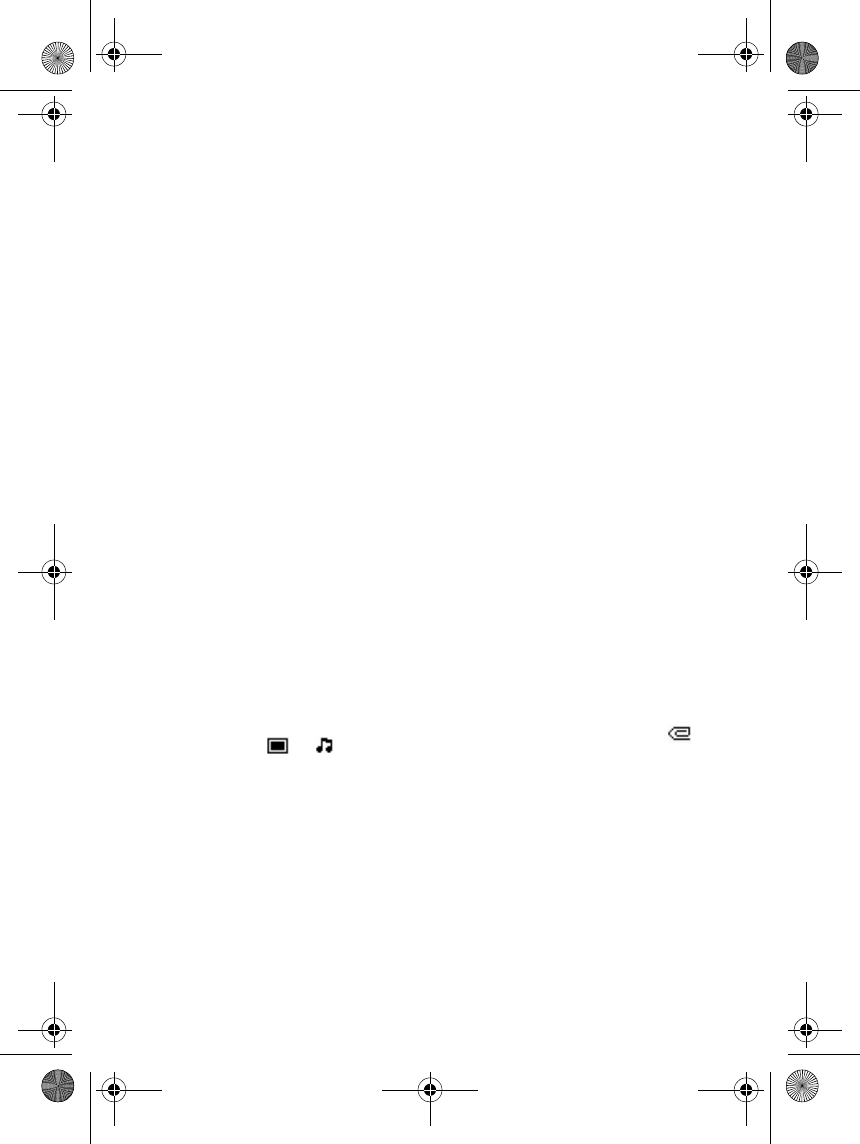
Menu functions
28
Writing and sending a
multimedia message
To set the settings for multimedia
messaging, see ”Settings for
multimedia messages” on page 33.
To check the availability or
subscribe to the multimedia
messaging service, contact your
network operator or service
provider.
1. Press Menu, and select
Messages, Multimedia msgs.
and Create message.
2. Key in or use the stylus to write
a message. See ”Keypad input
methods” on page 20 or
“Handwriting input method” on
page 14.
To insert a picture or a sound
clip, press Options, and select
Insert image or Insert sound
clip, respectively. The list of
available folders in the Gallery
is shown. Open a specific folder,
scroll to the desired picture or
sound, press Options and select
Insert. The or indicator
in the header of the message
indicates that a picture or sound
has been attached. Copyright
protections may prevent some
images, ringing tones and other
content from being copied,
modified, transferred or
forwarded.
To insert a name from Contacts,
press Options, select More
options and Insert contact.
Scroll to the desired name, press
Options and select Insert
contact.
To insert a number, press
Options, select More options
and Insert number. Key in the
number or search for it in
Contacts, and press OK.
3. To view the message before
sending it, press Options and
select Preview.
4. To send the message, press
Options and select Send to
number (or Send to e-mail or
Send to many).
5. Enter the recipient’s phone
number (or e-mail address) or
search for it in Contacts. Press
OK and the message is moved to
the Outbox folder for sending.
It may take more time to send a
multimedia message than to
send a text message. While the
multimedia message is being
sent, the animated indicator
is displayed and you can use
other functions on the phone. If
there is an interruption while the
message is being sent, the phone
tries to resend it a few times. If
this fails, the message will
remain in the Outbox folder and
you can try to resend it later
from there.
The messages that you have sent
will be saved in the Sent items
3108_Dufu_fcc_1.1.fm Page 28 Friday, October 24, 2003 2:11 AM
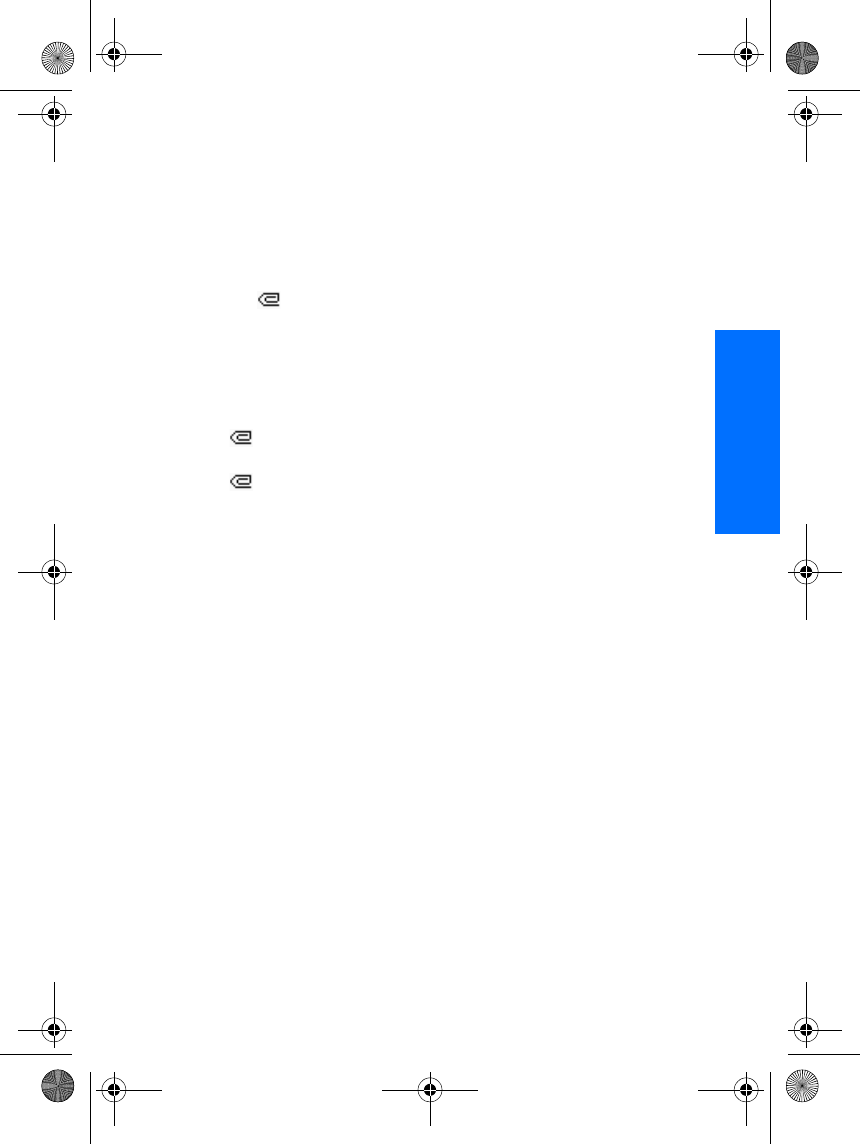
Menu functions
29
English
folder if the setting Save sent
messages is set to Yes . See
”Settings for multimedia
messages” on page 33.
Reading and replying to a
multimedia message
The blinking indicates that the
memory for multimedia messages
is full, see ”Multimedia messages
memory full” on page 30.
When your phone is receiving a
multimedia message, the animated
indicator is displayed. When
the message has been received, the
indicator and the text
Multimedia message received are
shown.
The multimedia message function
uses shared memory, see ”Shared
memory” on page 0.
1. Press Show to view the message,
or press Exit to view it later.
Reading the message later: Press
Menu, and select Messages,
Multimedia msgs. and Inbox.
2. Scroll to view the message.
Press Options and some of the
following options may be
available.
•Delete message to delete a
saved message.
•Reply or Reply to all to reply
to the message. To send the
reply, refer to ”Writing and
sending a multimedia
message” on page 28
•Forward to no., Forward to
e-mail or Forward to many to
forward the message.
•
•Message details to view the
subject, size and type of the
message.
•Details to view the details of
the attached image or sound.
•Save sound clip to save the
ringing tone in the Gallery.
•Save image to save the
picture in the Gallery.
Refer also to the file options in
Gallery, see ”Gallery (Menu 7)”
on page 49. Note that copyright
protections may prevent some
images, ringing tones and other
content from being copied,
modified, transferred or
forwarded.
Inbox, Outbox, Saved and Sent
items folders
The phone saves the multimedia
messages that have been received in
the Inbox folder of the Multimedia
msgs. submenu.
Multimedia messages that have not
yet been sent are moved to the
Outbox folder of the Multimedia
msgs. submenu.
The multimedia messages that you
wish to send later, can be saved in
the Saved items folder of the
Multimedia msgs. submenu.
3108_Dufu_fcc_1.1.fm Page 29 Friday, October 24, 2003 2:11 AM
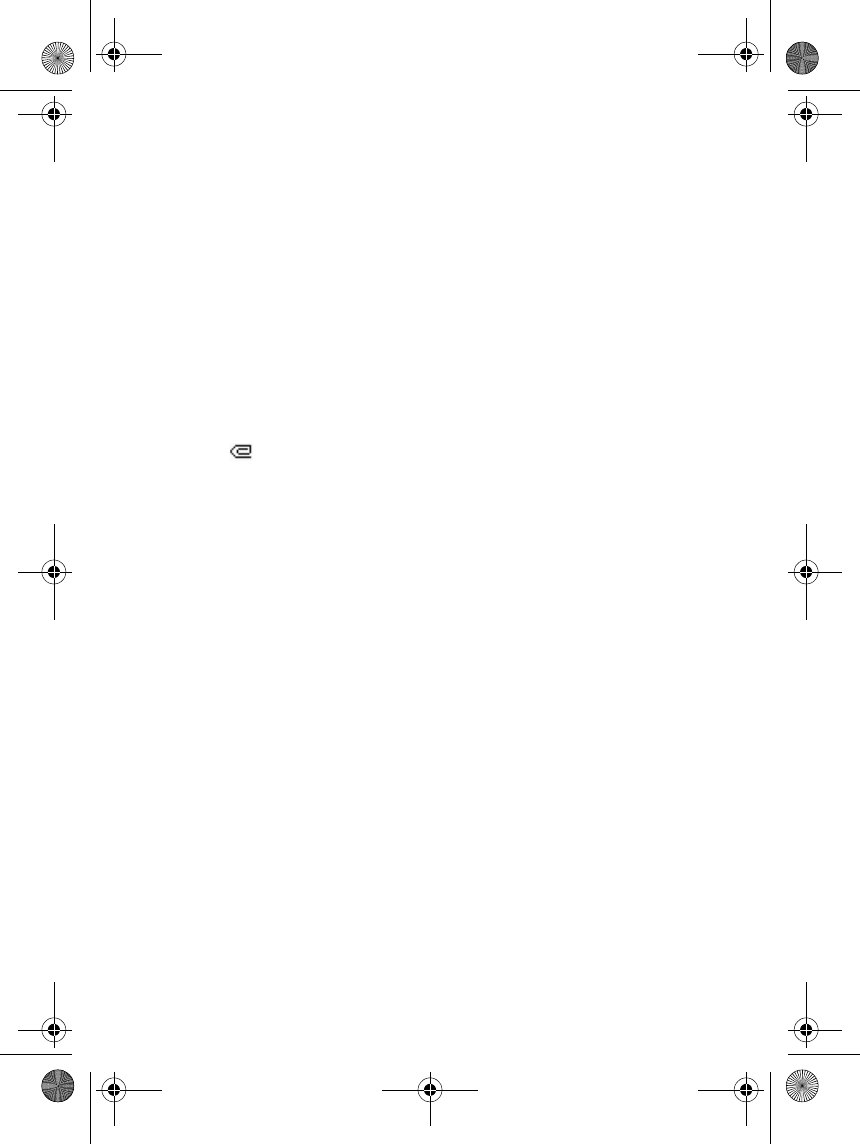
Menu functions
30
The multimedia messages that have
been sent are saved in the Sent items
folder of the Multimedia msgs.
submenu if the setting Save sent
messages is set to Ye s. See ”Settings
for multimedia messages” on page
33.
Multimedia messages
memory full
When you have a new multimedia
message waiting and the memory
for the messages is full, the
indicator blinks and
Multimedia me- mory full, view
waiting msg. is shown. To view the
waiting message, press Show. To
save the message, press Options,
select Save message and delete old
messages by first selecting the
folder and then the old message to
be deleted. Note that unless you
have chosen to save the waiting
message, the message will not be
saved in your phone even when you
view it.
To discard the waiting message,
press Exit and Yes. If you press No,
you can view the message.
Delete messages
1. To delete text messages, press
Menu, and select Messages, Text
messages and Delete messages.
To delete all text messages from
all folders, select All messages
and when Delete all messages
from all folders? is displayed,
press OK. If the folders contain
unread messages, the phone will
ask whether you want to delete
them also.
To delete multimedia messages,
press Menu, and select
Messages, Multimedia msgs.
and Delete messages.
2. To delete all messages from a
folder, scroll to the folder and
press Select. If the folder
contains unread messages, the
phone will ask whether you
want to delete them also.
Chat
You can have a text message based
conversation with another person
using this faster text messaging
application (network service). You
cannot save received or sent
messages, but you can view them
while chatting. Each message is
sent as a separate text message.
1. To start a chat session, press
Menu, select Messages and
Chat. Enter or get from your
phone book the phone number
of the person you want to chat
with, and press OK.
Another way to start a chat
session: When you have
received a message, press Show
to read it. To start a chat session,
press Options and select Chat.
3108_Dufu_fcc_1.1.fm Page 30 Friday, October 24, 2003 2:11 AM
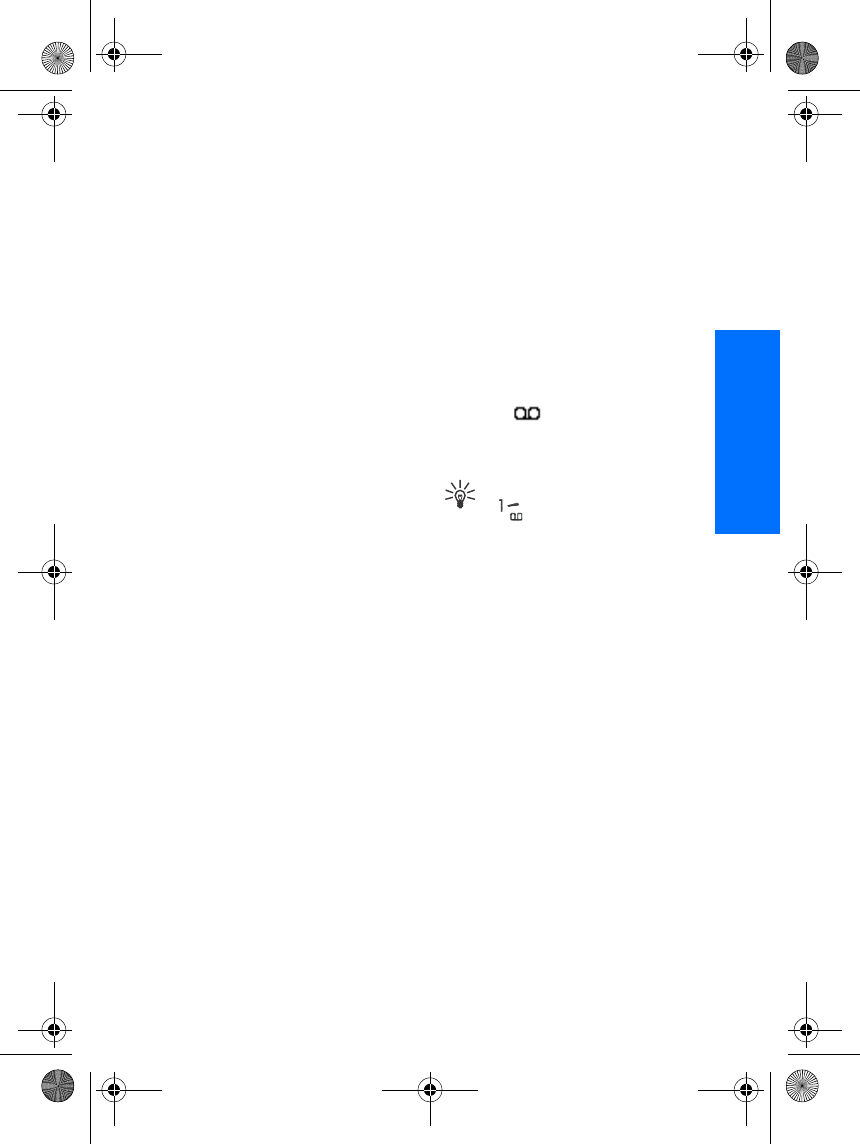
Menu functions
31
English
2. Enter your nickname for the chat
session and press OK.
3. Compose your chat message.
4. To send the message, press
Options and select Send.
5. The reply message from the
other person is shown above
your original message.
To reply to the message, press
OK and repeat steps 3 and 4.
6. To end the chat session, press
OK and Options, and select
Quit.
To view the most recent messages
of the current chat session, press
Options and select Chat history.
The messages that you sent are
indicated by "<" and your nickname
and the messages that you received
are indicated by ">", and the
sender’s nickname. Press Back to
return to the message you are
currently writing. To edit your
nickname, select the option Chat
name.
Voice messages
Voice mailbox is a network service
and you may need to subscribe to it.
For more information and for the
voice mailbox number, contact your
service provider.
Press Menu, and select Messages
and Voice messages. Select
•Listen to voice messages to call
your voice mailbox at the phone
number that you have saved in
the Voice mailbox number menu.
Each phone line may have its
own voice mailbox number, see
”Line for outgoing calls” on
page 43.
•Voice mailbox number to enter,
get from your phone book, or
edit your voice mailbox number.
Press OK to save it.
If supported by the network, the
indicator will show new voice
messages. Press Listen to call your
voice mailbox number.
Tip: Pressing and holding
calls your voice
mailbox.
Info messages
With the info message network
service you may be able to receive
messages on various topics from
your service provider, for example
weather or traffic conditions. For
available topics and the relevant
topic numbers, contact your service
provider.
If the GPRS connection is set to
Always online, the info messages
may not be received. In that case,
set the GPRS connection to When
needed, see “GPRS Connection” on
page 60, to enable reception of info
messages.
3108_Dufu_fcc_1.1.fm Page 31 Friday, October 24, 2003 2:11 AM
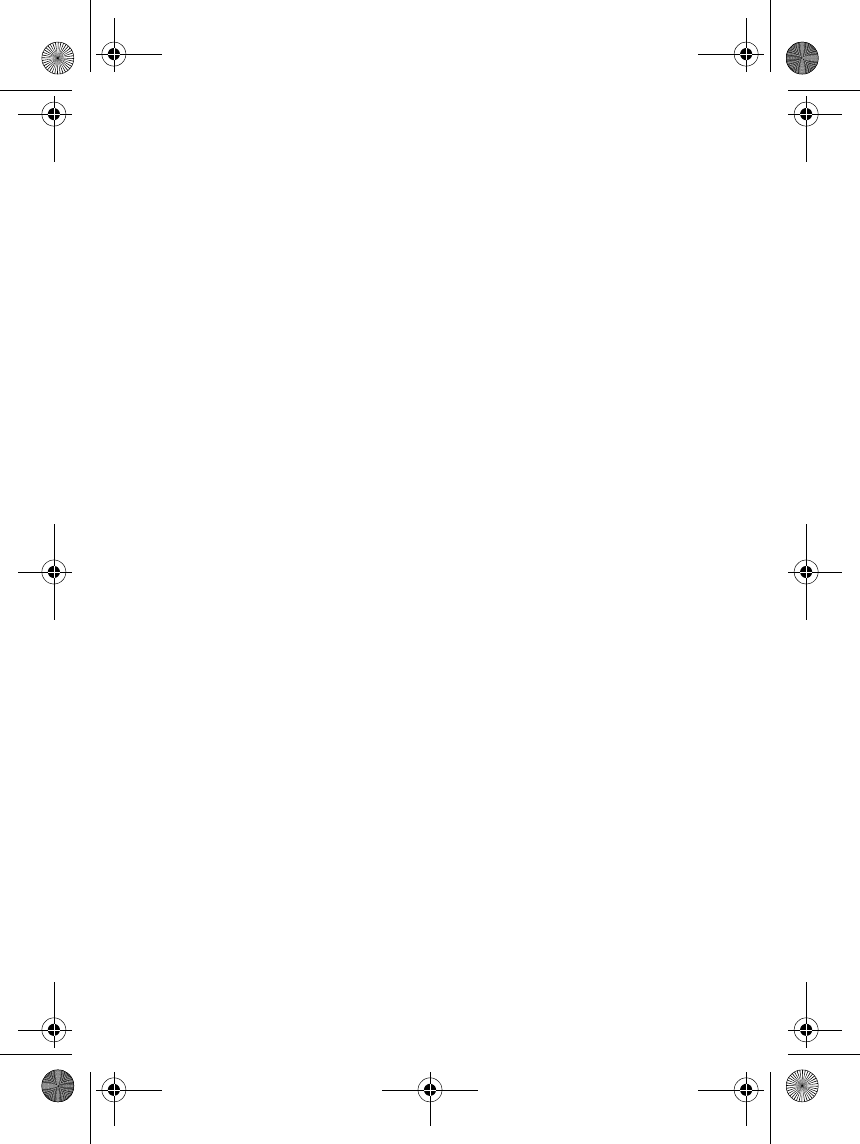
Menu functions
32
Message settings
The message settings affect the
sending, receiving and viewing of
messages.
Settings for text messages
1. Press Menu, and select
Messages, Message settings,
Text messages and Sending
profile.
2. If more than one message profile
set is supported by your SIM
card, select the set you want to
change.
• Select Message centre
number to save the phone
number of the message
centre that is required for
sending text messages. You
will receive this number from
your service provider.
• Select Messages sent via to
select the message type Tex t,
E-mail, Paging or Fax.
• Select Message validity to
select the length of time for
which the network should
attempt to deliver your
message.
• For message type Tex t, select
Default recipient number to
save a default number for
sending messages for this
profile.
• Select Delivery reports to ask
the network to send delivery
reports about your messages
(network service).
•Select Use GPRS to set
GPRS as the preferred SMS
bearer (network service).
•Select Reply via same centre
to allow the recipient of your
message to send you a reply
via your message centre
(network service).
•Select Rename sending
profile to change the name of
the selected message profile.
The message profile sets are
only displayed if your SIM
card supports more than one
set.
Overwrite settings
When the text message memory is
full, the phone cannot receive or
send any new messages. However,
you can set the phone to
automatically replace old text
messages in the Inbox and Sent
items folders with the new ones.
Press Menu, and select Messages,
Message settings, Text messages
and Overwriting in inbox or
Overwriting in sent items. Select
Allowed to set the phone to replace
the old text messages with new ones
in the Inbox or the Sent items folder,
respectively.
3108_Dufu_fcc_1.1.fm Page 32 Friday, October 24, 2003 2:11 AM
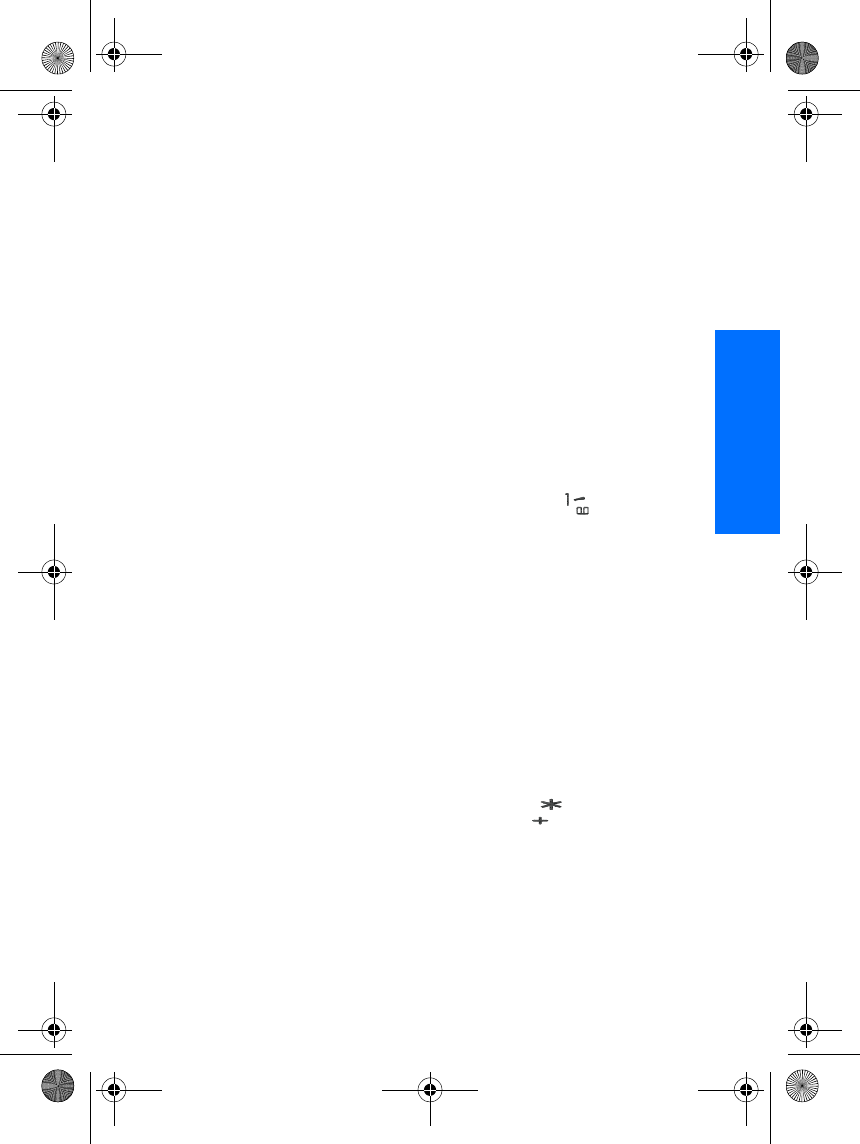
Menu functions
33
English
Settings for multimedia
messages
Press Menu, and select Messages,
Message settings and Multimedia
msgs.. Select
•Save sent messages. Select Yes
to set the phone to save sent
multimedia messages in the Sent
items folder. If you select No, the
sent messages are not saved.
•Delivery reports to ask the
network to send delivery reports
about your messages (network
service)
•Scale image down. Select Yes to
set the phone to scale the image
inserted in the multimedia
message to the default size, if the
original size of the image is
larger than the default size. If
you select No,the inserted image
will be added into the message
as its original size.
•Allow multimedia reception.
Choose No, Yes or In home
network to use the multimedia
service. If you choose In home
network, you cannot receive
multimedia messages when
outside your home network.
•Incoming multi- media
messages. Select Retrieve to set
the phone to automatically fetch
newly received multimedia
messages, or select Reject if you
do not wish to receive
multimedia messages. This
setting is not shown if the Allow
multimedia reception is set to
No.
•Connection settings. Define
WAP connection settings for
retrieving multimedia messages.
Activate the set where you want
to save the connection settings
and then edit the settings.
•Settings' name. Enter the new
name for the connection set
and press OK.
•Homepage. Enter the
homepage address of the
WAP service that you want to
use, press for a dot, and
press OK.
•Session mode. Select
Permanent or Temporary.
•Data bearer. Select GPRS.
•GPRS access point. Enter the
access point name to
establish a connection to a
GPRS network and press
OK. Contact your network
operator or service provider
for the access point name.
•IP address. Enter the address,
press for a dot, and press
OK. You obtain the IP
address from your network
operator or service provider.
•Authentication type. Select
Secure or Normal.
•User name. Enter the user
name and press OK.
3108_Dufu_fcc_1.1.fm Page 33 Friday, October 24, 2003 2:11 AM
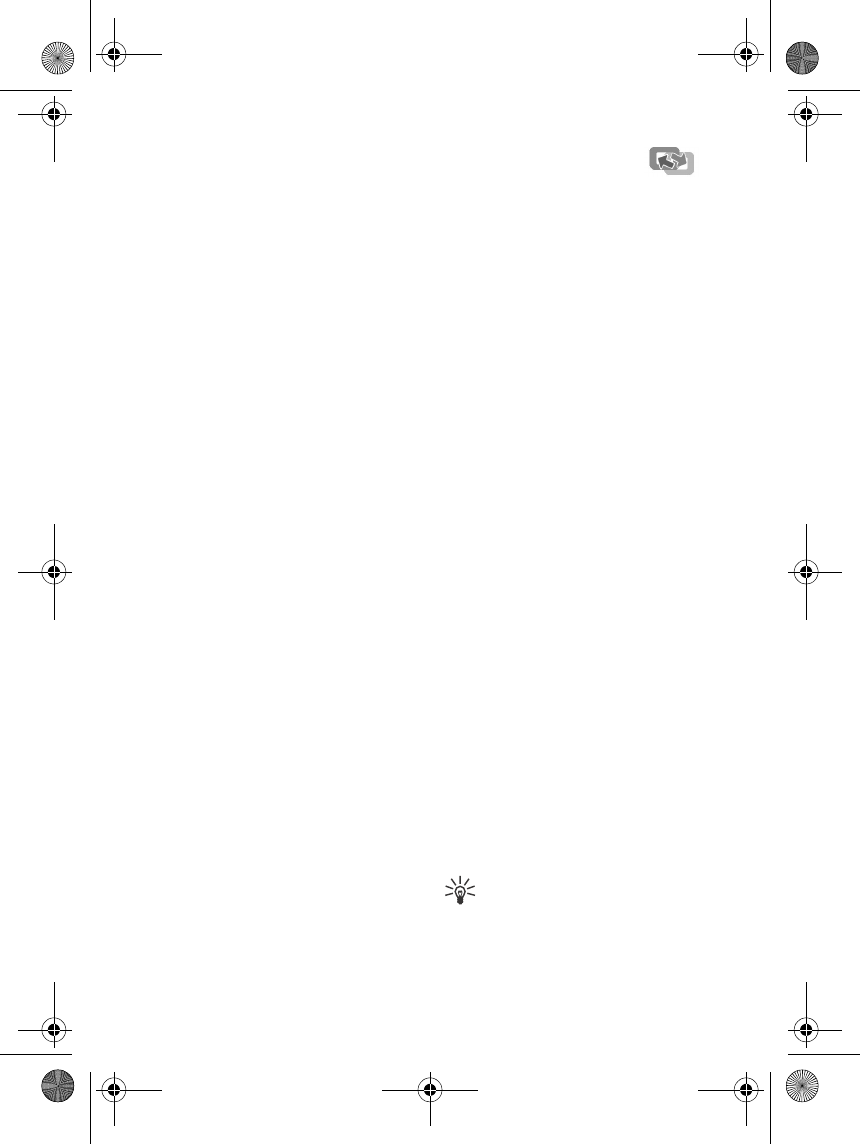
Menu functions
34
•Password. Key in the
password and press OK.
•Allow adverts. You can allow or
reject advertisements. This
setting is not shown if the Allow
multimedia reception is set to
No.
To receive the multimedia
connection settings as a text
message
You may be able to receive the
service settings as a text message
from the network operator or
service provider that offers the
WAP service that you want to use.
For more information, contact your
network operator or service
provider.
Font size setting
To select the font size for reading
and writing messages, press Menu,
and select Messages, Message
settings, Other settings and Font
size.
Service commands
Press Menu, and select Messages
and Service commands. Enter and
send service requests (also known
as USSD commands), such as
activation commands for network
services, to your service provider
(network service).
■Call register
(Menu 2)
The phone registers the phone
numbers of missed, received and
dialled calls, and the approximate
length and cost of your calls.
The phone registers missed and
received calls only if the network
supports these functions, the phone
is switched on and within the
network’s service area.
When you press Options in the
Missed calls, Received calls and
Dialled numbers menu, you can, for
example, view the date and the time
of the call, edit or delete the phone
number from the list, save the
number in the phone book, or send a
message to the number.
Recent calls lists
Press Menu, and select Call register
and then select
•Missed calls to view the list of
up to the last ten phone numbers
from which somebody has tried
to call you (network service).
The number in front of the
(name or) phone number
indicates the amount of call
attempts from that caller.
Tip: When a note about
missed calls is displayed,
press List to access the list
of phone numbers. Scroll to
3108_Dufu_fcc_1.1.fm Page 34 Friday, October 24, 2003 2:11 AM
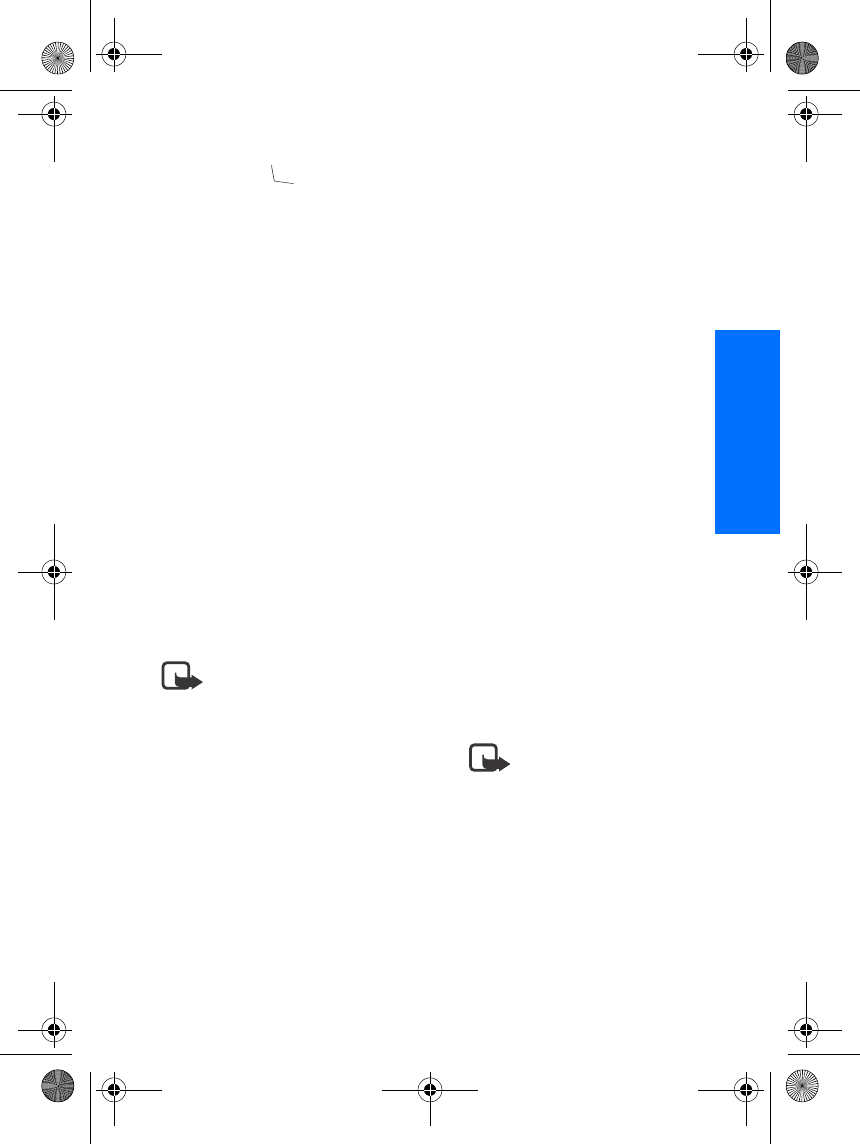
Menu functions
35
English
the number you would like to call
back and press .
•Received calls to view the list of
up to the last ten phone numbers
from which you have most
recently accepted calls (network
service).
•Dialled numbers to view the list
of up to the 20 phone numbers
that you have most recently
called or attempted to call.
•Delete recent call lists to delete
the recent calls lists. Select
whether you want to delete all
the phone numbers in the recent
calls lists, or only those numbers
in the missed calls, received
calls or dialled numbers lists.
You cannot undo the operation.
Call counters and call
timers
Note: The actual invoice
for calls and services from
your service provider may
vary, depending upon network
features, rounding-off for billing,
taxes and so forth.
Press Menu, and select Call register
and then select
•Call duration scroll to view the
approximate duration of your
incoming and outgoing calls in
hours, minutes and seconds. The
security code is required to clear
the timers.
Each phone line has its own call
timers and the timers of the
selected line are displayed. See
”Line for outgoing calls” on
page 43.
•Call costs (network service).
Select Last call units or All calls'
units to check the cost of your
most recent call or all calls in
terms of units specified within
the Show costs in function.
Select Call cost settings and
select Clear counters to clear the
counters, or select Show costs in
to set the phone to show the
remaining talk time in terms of
charging units, Units, or units of
currency, Currency. Contact
your service provider for
charging unit prices.
Select Call cost limit to limit the
cost of your calls to a certain
amount of charging units or
units of currency. The PIN2
code is required for the call cost
settings.
Note: When no more
charging units or
currency units are left,
calls may only be possible to the
emergency number programmed
into your phone (e.g. 112, 911, or
other official emergency number).
•GPRS data counter Scroll to
check the amounts of data that
were sent or received in the last
session, data sent and received
3108_Dufu_fcc_1.1.fm Page 35 Friday, October 24, 2003 2:11 AM
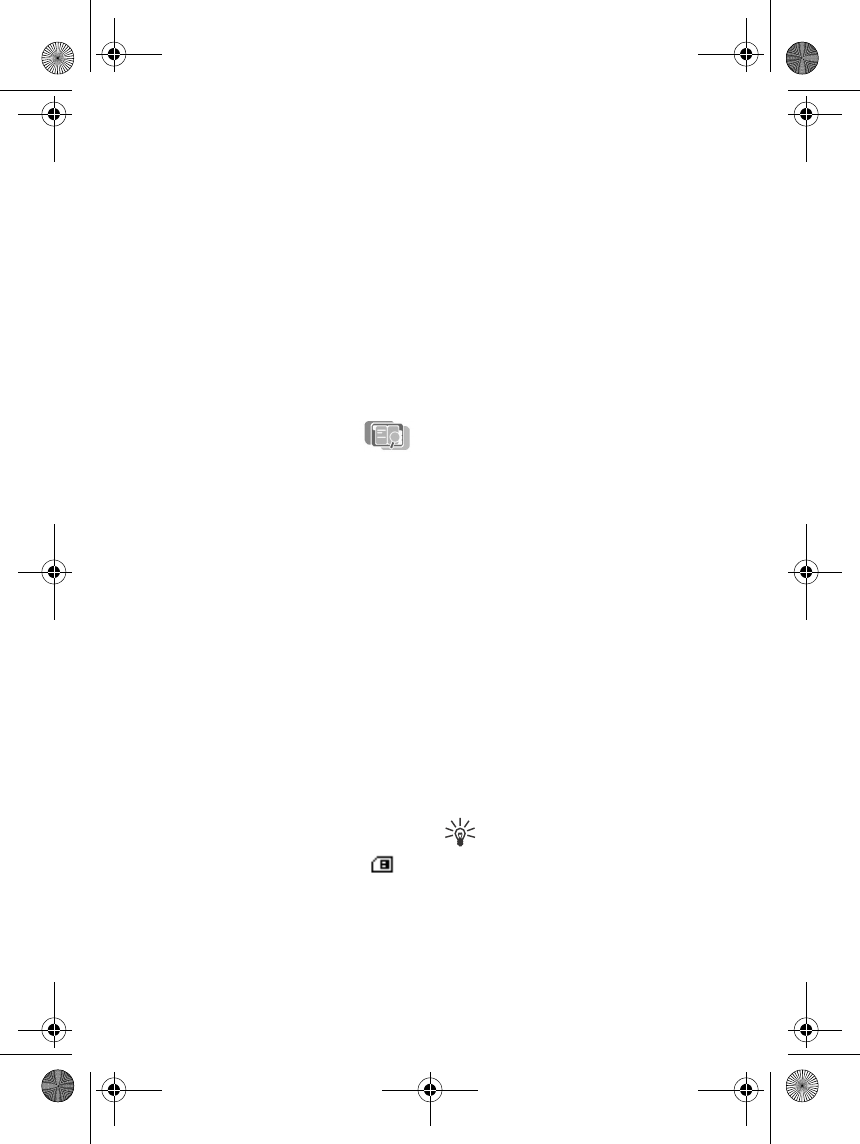
Menu functions
36
in total, and to clear the
counters. The counter unit is a
byte. The security code is
required to clear the counters.
•GPRS connection timer Scroll to
check the approximate duration
of the last GPRS connection or
the total GPRS connection. You
can also clear the timers. To
clear the timers, the security
code is required.
■Contacts (Menu
3)
You can save names and phone
numbers in the phone’s memory
(internal phone book) and in the
SIM card’s memory (SIM phone
book).
• The internal phone book may
save up to 300 names with
numbers and text notes about
each name. The number of
names that can be saved depends
on the length of the names, and
the number and length of the
phone numbers and text items.
• The phone supports SIM cards
that can save up to 250 names
and phone numbers. Names and
numbers saved in the SIM card’s
memory, are indicated by .
Phone book settings
Press Menu and select Contacts and
Settings. Select
•Memory in use to select the
phone book you want to use. To
find names and numbers from
both phone and SIM card, select
Phone and SIM. The names and
numbers will be saved in the
phone’s memory.
•Contacts view to select how the
names and numbers in the phone
book are displayed.
•Memory status to see how many
names and phone numbers are
currently saved and how many
can still be saved in the selected
phone book.
Save names and phone
numbers (Add names)
Names and numbers will be saved
in the used memory, see ”Phone
book settings” above.
1. Press Menu and select Contacts
and Add contact.
2. Enter the name and press OK.
3. Enter the phone number, and
press OK.
4. When the name and number are
saved, press Done.
Tip: Quick save In
standby mode, key in the
phone number. Press
Options, and select Save. Enter the
name, press OK and Done.
3108_Dufu_fcc_1.1.fm Page 36 Friday, October 24, 2003 2:11 AM
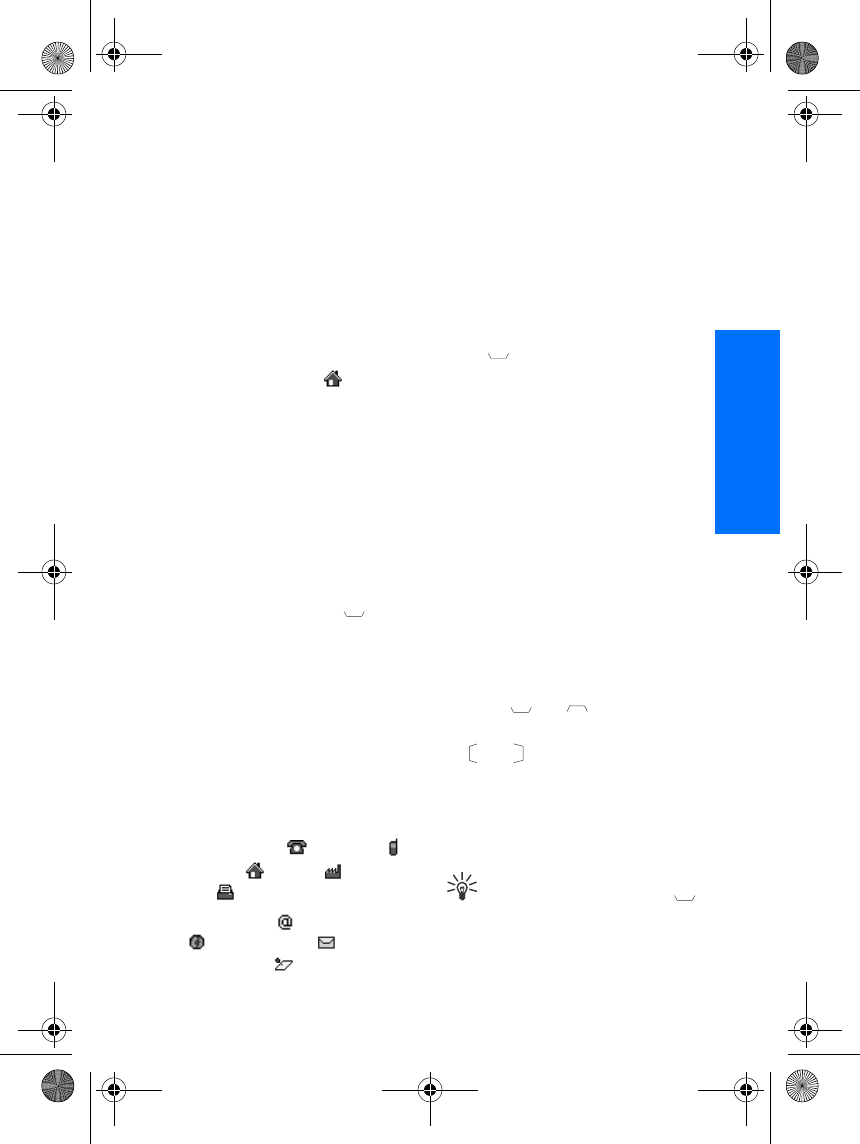
Menu functions
37
English
Save multiple numbers and text
items per name
You can save different types of
phone numbers and short text items
per name in the phone’s internal
phone book.
The first number saved is
automatically set as the default
number and it is indicated with a
frame around the number type
indicator, for example . When
you select a name from the phone
book, for example to make a call,
the default number is used unless
you select another number.
1. Make sure that the memory in
use is either Phone or Phone and
SIM. See ”Phone book settings”
on page 36.
2. To access the list of names and
phone numbers, press in
standby mode.
3. Scroll to the name saved in the
phone’s internal phone book to
which you want to add a new
number or text item, and press
Details.
4. Press Options and select Add
number or Add detail.
5. Select one of the following
number types General,
Mobile, Home, Office
and Fax,
or text types E-mail address,
Web address, Postal
address and Note.
To change the number or text
type, select Change type in the
options list.
6. Enter the number or text item
and press OK to save it.
7. Press Back and then Exit to
return to standby mode.
Change the default number
Press in standby mode, scroll to
the name you want and press
Details. Scroll to the number you
want to set as the default number.
Press Options and select Set as
default.
Search for a name in the
phone book
1. Press Menu and select Contacts
and Search.
2. You can key in the first
characters of the name you are
searching for in the pop-up
window.
Press and to scroll
through the names in the list, and
and to move the cursor in
the pop-up window.
3. Scroll to the name you want, and
press Details. Scroll to view the
details of the selected name.
Tip: To quickly find a name
and phone number, press
in standby mode. Key in the
first letter(s) of the name, and/or
scroll to the name you want.
3108_Dufu_fcc_1.1.fm Page 37 Friday, October 24, 2003 2:11 AM
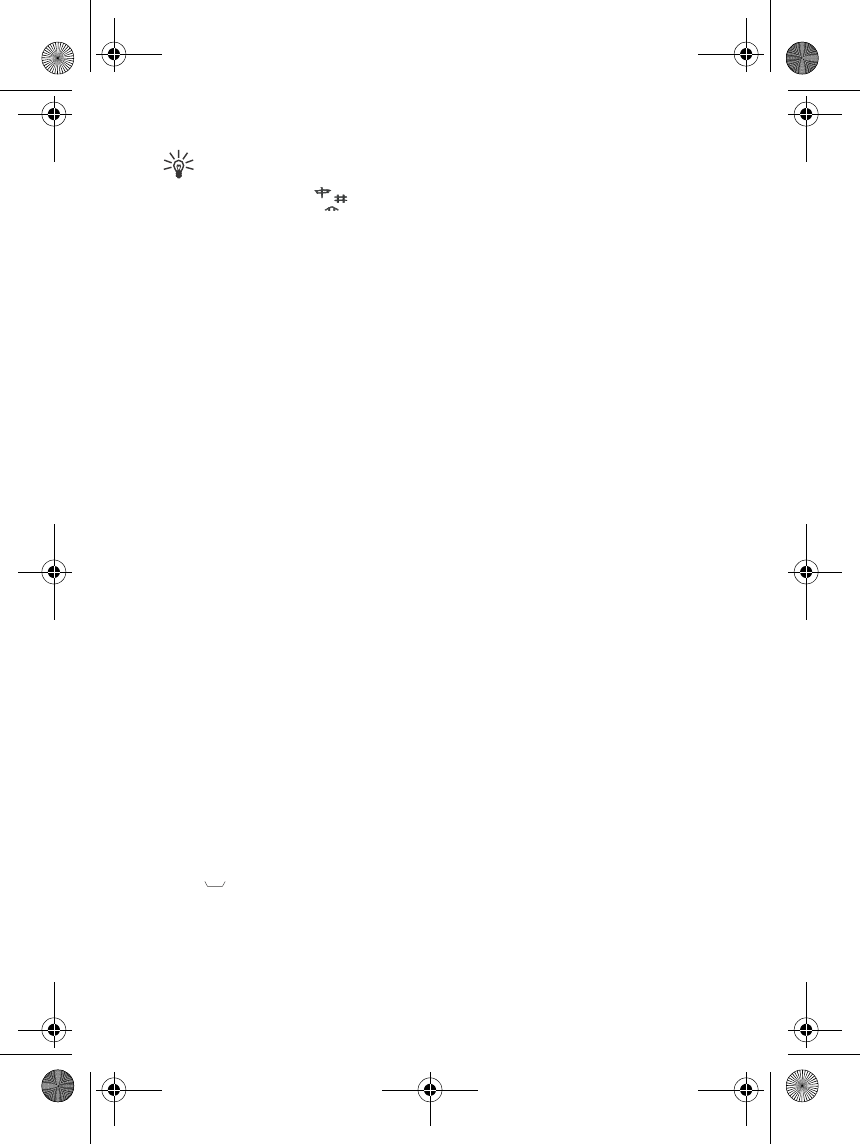
Menu functions
38
Tip: To view a specific name
with its default number,
press and hold .
Edit a name, number or
text item
Search for the name (and number)
you want to edit and press Details.
Scroll to the name, number or text
item you want to edit, and press
Options. Select Edit name, Edit
number or Edit detail to edit the
name, number or text, then press
OK.
Delete names and numbers
Press Menu and select Contacts and
Delete.
• To delete names and numbers
one by one, select One by one
and scroll to the name (and
number) you want to delete.
Press Delete and press OK to
confirm.
• To delete names and numbers in
the phone book all at once, select
Delete all and then scroll to the
phone book, Phone or SIM card
and press Delete. Press OK and
confirm with the security code.
Delete numbers or text items
Press in standby mode, scroll to
the des
ed name (and number) and press
Details. Scroll to the number or text
item you want to delete, press
Options and select Delete number
or Delete detail, respectively.
Copy in phone book
You can copy names and phone
numbers from the phone’s memory
to your SIM card’s memory and
vice versa. Note that any text items
saved in the phone’s internal
memory, such as e-mail addresses,
will not be copied to the SIM card.
1. Press Menu and select Contacts
and Copy.
2. Select the copying direction,
From phone to SIM card or
From SIM card to phone.
3. Select One by one, All or Default
numbers.
• If you select One by one,
scroll to the name you want
to copy and press Copy.
Default numbers is shown if you
copy from the phone to the SIM
card. Only the default numbers
will be copied.
4. To choose whether you want to
keep or delete the original
names and numbers, select Keep
original or Move original.
• If you select All or Default
numbers, press OK when
Start copying? or Start
moving? is displayed.
3108_Dufu_fcc_1.1.fm Page 38 Friday, October 24, 2003 2:11 AM
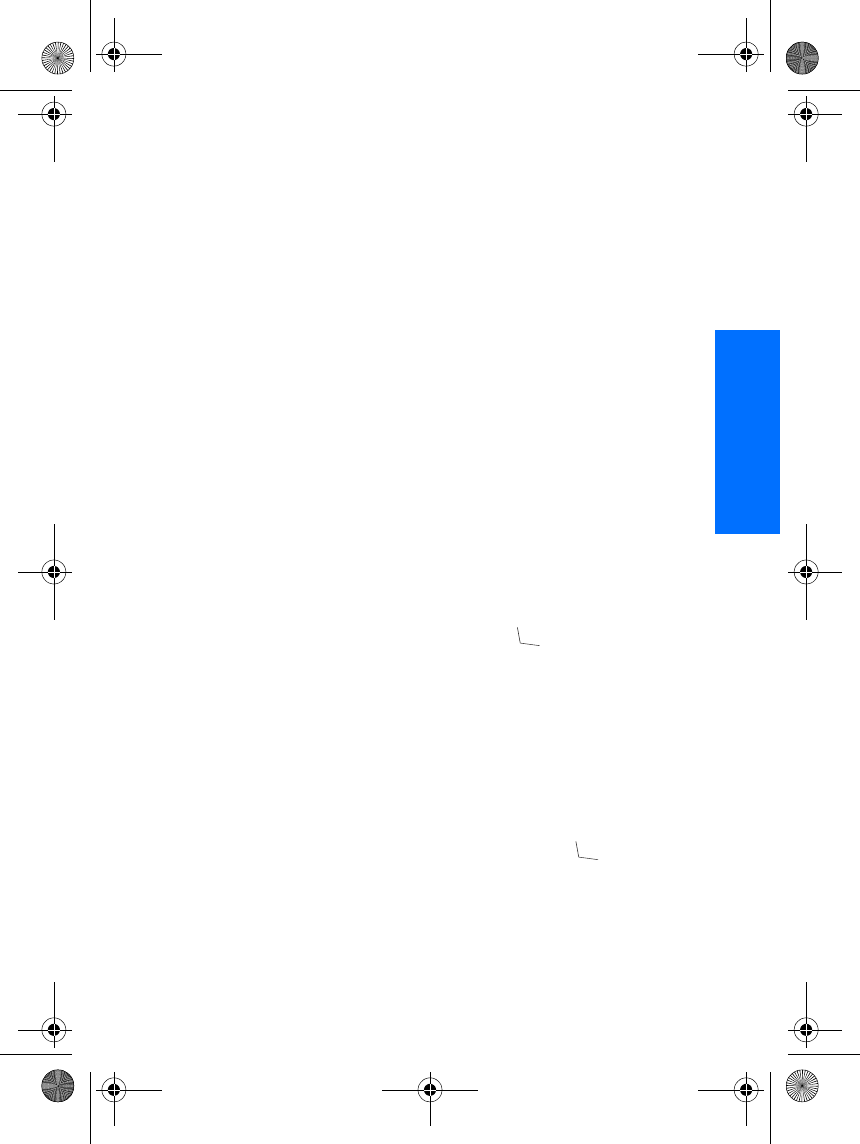
Menu functions
39
English
Send and receive business
cards
You can send and receive a person’s
contact information as a business
card from one compatible device to
another as a message if supported
by the network.
Receiving a business card
When you have received a business
card as a message, press Show.
Press Save to save the business card
in the phone’s memory. To discard
the business card, press Exit and
then OK.
Sending a business card
You can send a business card as a
message to a compatible phone or
other handheld device which
supports the vCard standard.
1. To send a business card, search
for the name and phone number
you want to send from the phone
book, press Details and Options
and select Send bus. card.
2. To send the business card as an
OTA message, select Via text
message.
Speed dials
To assign a number to a speed
dialling key, press Menu, select
Contacts, Speed dials. Scroll to the
speed dialling key number you
want.
Press Assign, press Search, and
select first the name and then the
number you want to assign. If a
number has already been assigned
to the key, press Options, and you
can view, change or delete the
assigned number.
If the Speed dialling function is off,
the phone asks whether you want to
activate it. Press Yes to activate the
function. Refer to “Speed dialling”
on page 43.
Info numbers
you can call the information
numbers of your service provider
from this menu if they are pre-
installed in your SIM card.
Press Menu and select Contacts and
Info numbers. Scroll through a
category to an information number
and press to call the number.
Service numbers
You can call the service numbers of
your service provider from this
menu if the numbers are pre-
installed in your SIM card.
Press Menu and select Contacts and
Service numbers. Scroll to a service
number and press to call the
number.
My numbers
The phone numbers assigned to
your SIM card are saved in My
3108_Dufu_fcc_1.1.fm Page 39 Friday, October 24, 2003 2:11 AM
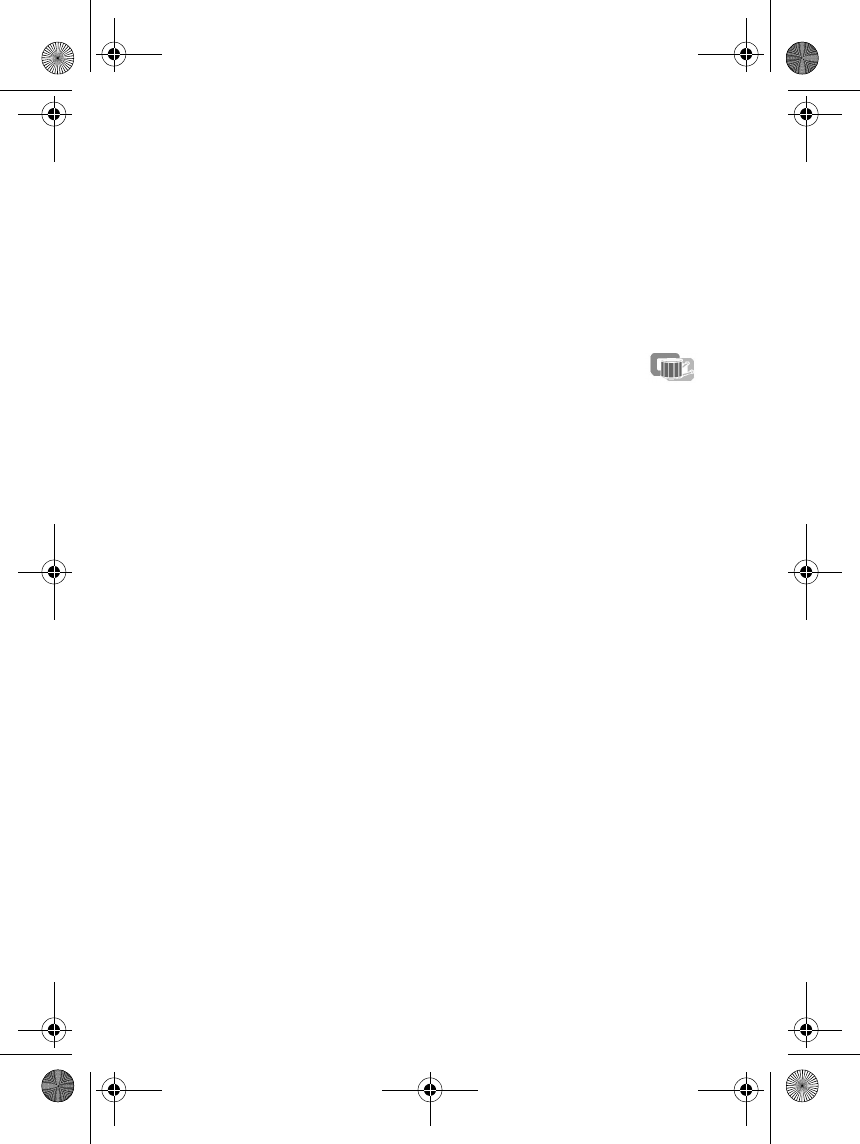
Menu functions
40
numbers if this is allowed by the
card. To view the numbers press
Menu and select Contacts and My
numbers. Scroll to the desired name
or number, and press View.
Caller groups
You can arrange the names and
phone numbers saved in the phone
book into caller groups. For each
caller group, you can set the phone
to sound a specific ringing tone and
show a selected graphic on the
display when you receive a call
from a recognised phone number in
the group, see below. To set the
phone to ring only upon calls from
phone numbers belonging to a
selected caller group, see Alert for
in ”Tone settings” on page 46.
Press Menu and select Contacts and
Caller groups and select the desired
caller group. Select
•Group name, enter a new name
for the caller group and press
OK.
•Group ringing tone and select
the ringing tone for the group.
Default is the ringing tone
selected for the currently active
profile.
•Group logo and select On to set
the phone to display the group
logo, Off not to display it, or
View to view the logo.
•Group members to add a name to
the caller group, press Options
and select Add contact. Scroll to
the name you want to add to the
group and press Add.
To remove a name from a caller
group, scroll to the name you
want to remove, and press
Options and select Remove
contact.
■Profiles (Menu
4)
Your phone has various setting
groups, profiles, for which you can
customise the phone tones for
different events and environments.
Initially, personalise the profiles to
your own liking and then you only
need to activate a profile to use it.
Available profiles are General,
Silent, Meeting, Outdoor, and
Pager.
Press Menu, and select Profiles.
Scroll to a profile and press Select.
• To activate the selected profile,
select Activate.
• To set the profile to be active for
a certain amount of time up to 24
hours, select Timed and set the
end time. When the time set for
the profile expires, the previous
profile that was not timed,
becomes active.
• To personalise the profile, select
Personalise. Select the setting
you want to change and make
the changes. The same settings
3108_Dufu_fcc_1.1.fm Page 40 Friday, October 24, 2003 2:11 AM
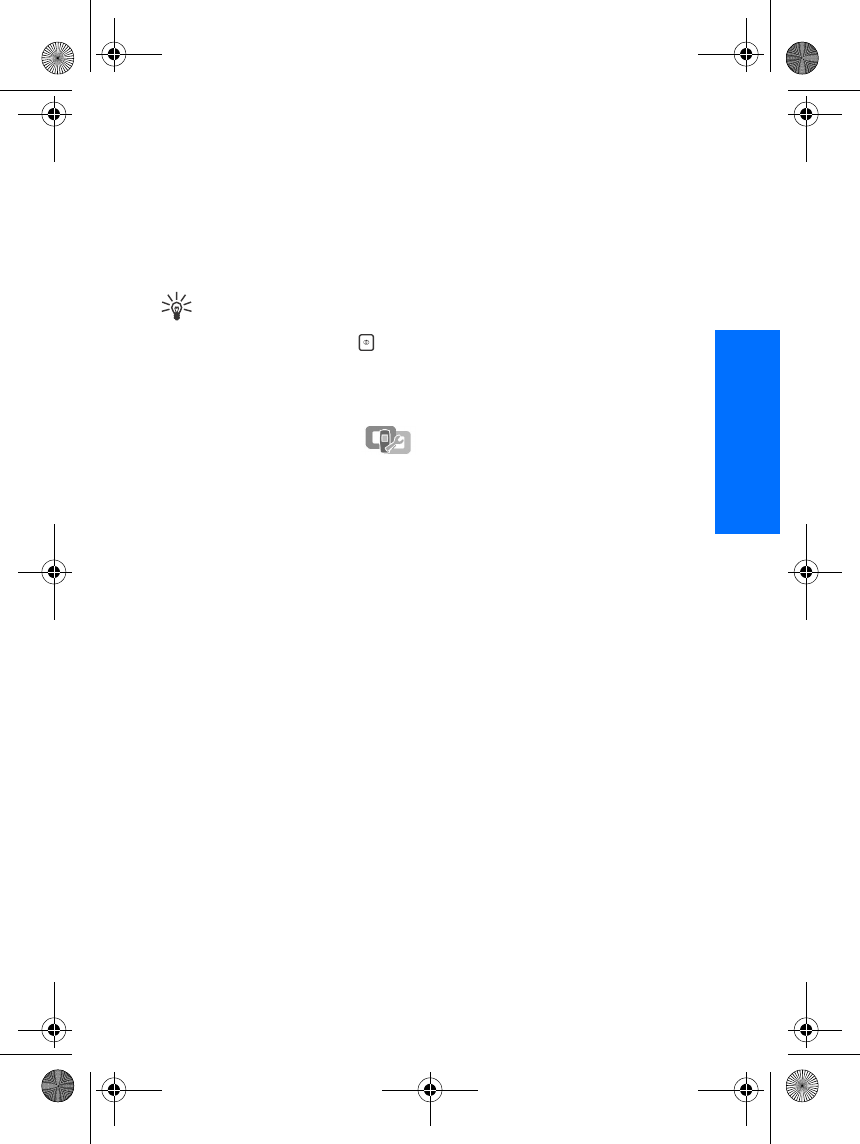
Menu functions
41
English
can also be changed in the Tone
settings menu, see ”Tone
settings” on page 46.
To rename a profile, Profile
name. The General profile can
not be renamed.
Tip: To change the profile
quickly in standby mode,
press the power key ,
scroll to the profile you want
to activate and press Select.
■Settings (Menu
5)
Right selection key
To access some specific functions
quickly, you can add them to the list
assigned to the right selection key,
and rearrange the functions in the
list.
1. Press Menu, and select Settings
and Right selection key settings.
• To select desired functions
for the right selection key,
select Select options and the
list of available functions is
shown.
To add the desired function to
the selection key list, press
Mark. When a function is
added to the list, the right
selection key changes from
Contacts to Go to.
To remove a function from
the list, press Unmark.
• To rearrange the functions in
the list, select Organise and
then the desired function.
Press Move and select an
option to move the function
in the list.
2. When you have made all the
changes, press Done. To save the
changes, press Yes or to discard
the changes, press No.
Screen saver settings
Press Menu, select Settings , Screen
saver and select:
•On to turn on the screen saver;
•Off to turn off the screen saver;
•Select s. saver to select the
animation or image you want to
set as screen saver;
•Time-out to set the timeout after
which the screen saver will be
activated.
Time and date settings
Clock
Press Menu, and select Settings,
Time and date settings and Clock.
Select Show clock (or Hide clock) to
show (or hide) the time on the top
right of the display in standby
mode. Select Set the time to adjust
the clock to the correct time, and
Time format to select 12-hour or 24-
hour time format.
3108_Dufu_fcc_1.1.fm Page 41 Friday, October 24, 2003 2:11 AM
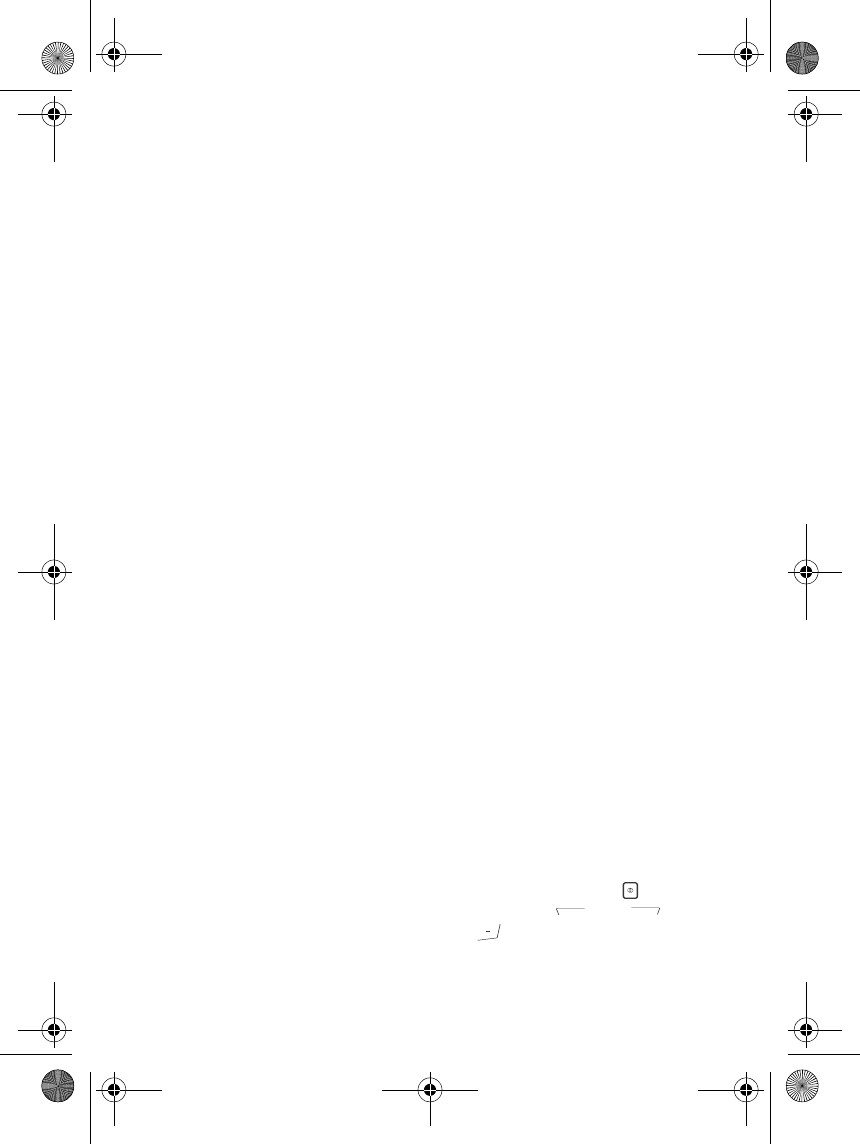
Menu functions
42
Date
Press Menu, and select Settings,
Time and date settings and Date.
Select Show date (or Hide date) and
the date is shown (or hidden) on the
display when the phone is in
standby mode. Select Set the date to
adjust the date. You can also select
the date format.
If the battery is flat or removed
from the phone for a long time, you
may need to set the date and time
again.
Auto update of date and time
Press Menu, and select Settings,
Time and date settings and Auto-
update of date & time (network
service). To set the phone to
automatically update the time and
date according to the current time
zone, select On. To set the phone to
ask for a confirmation before the
update, select Confirm first.
Note that the automatic update of
the date and time will affect other
time related features (for example
alarm clock). These features will
always follow the updated time.
Updating may cause some alarms
that you have set to expire.
Call settings
Call divert
Press Menu, and select Settings,
Call settings and Call divert
(network service). With call divert,
you can direct your incoming calls
to another number, for example, to
your voice mailbox number. For
details, contact your service
provider. Divert options not
supported by your SIM card or your
network operator may not be
shown.
Select the divert option you want,
for example, select Divert if busy to
divert the voice calls when your
number is busy or when you reject
an incoming call.
To set the divert setting to on, select
Activate and then select the timeout
after which the call is diverted, if
this is available for the divert
option. To set the divert setting to
off, select Cancel, or select Check
status to check whether call divert
is activated or not. Check status is
only available for certain options.
Several divert options may be
active at the same time.
To see the divert indicators in
standby mode, see ”Standby mode”
on page 2.
Anykey answer
Press Menu, and select Settings,
Call settings and then Anykey
answer. Select On and you can
answer an incoming call by briefly
pressing any key, except ,
selection keys and ,
and .
3108_Dufu_fcc_1.1.fm Page 42 Friday, October 24, 2003 2:11 AM